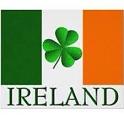
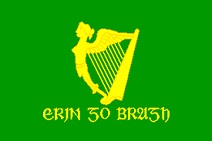







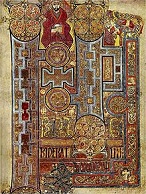
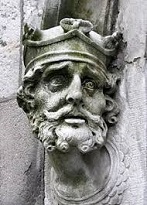




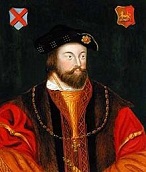

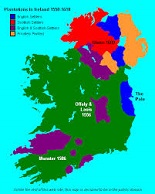


















TLW's Irelandscope™ (Ireland Historyscope) |
By T.L. Winslow (TLW), the Historyscoper™ |
© Copyright by T.L. Winslow. All Rights Reserved. |
Original Pub. Date: July 24, 2017. Last Update: Feb. 25, 2022. |


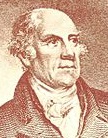
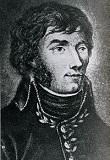



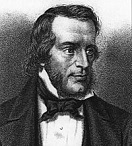


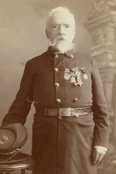



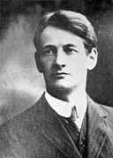









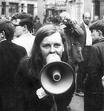


Westerners are not only known as history ignoramuses, but double dumbass history ignoramuses when it comes to Ireland and Ireland's history. Since I'm the one-and-only Historyscoper (tm), let me quickly bring you up to speed before you dive into my Master Historyscope.
The 32,595 sq. mi. island of Hibernia AKA Ireland (Eire, Eriu) (modern-day pop. 6.5M) is the wild, wild west of Europe, the last area to be civilized, a land of freedom-loving peoples, making its history more interesting than the over-civilized servile east. Add their unpronounceable names and weird-wonderful culture, and who wants to pass them up?
About 4000 B.C.E. tombs at Loughcrew in County Meath, Ireland align with the rising Sun at the spring and autumn equinoxes.
About 3200 B.C.E. the 200K-ton Newgrange Tomb in County Meath, Ireland is built; each winter solstice the Sun shines through an opening above the entrance for about 15 min., illuminating a 60-ft.-long passage; discovered in 1699 C.E.
The Celts begin fighting for their free-ee-ee-dom? About 3,000 B.C.E. the Celts (from the Greek word Keltoi, meaning hidden people), a fusion of Mediterranean, Alpine, and Nordic strains, incl. a dark Iberian and a blonde stock, and known, like Slavs, for big beards (compared to Chinese who have stubble beards, Ethiopians who have curly beards, and Am. aborigines, who are bare-faced) appear in N Europe; their Indo-European Gaelic Language drops the p sound in the initial or medial position (Lat. porcus becomes Gael. orc); they eventually form more than 150 distinct tribes, incl. the Britons in Britain, the Gauls in France, and the Goidels (Gaels) (Gael. "gwyddel" = savages) in Ireland, Scotland, and the Isle of Man; Goidelic Gaelic splits from Brythonic Galic by preserving the hard c sound, which turns into p in Brythonic (Irish mac becomes Welsh map); they practice the Druid Religion (Gr. "drus" = oak tree), which worships trees (rowans), practices magical ceremonies, and believes in the Sun god Belenus (Beli Mawr) ("the shining one"), the goddess of victory Andraste (Andrasta) (Andred), tree genies, Earth gods, and elfin demons; they fail to develop a written lit., relying on oral transmission by bards, filid (poets), scelaige (narrators), and entertainers; although they have no alphabet, symbols they use incl. the cross, swastika (fylfot), and trefoil (trivet), plus the colors and weaves later used in Scottish tartans; the Britons are cannibals; the social org. is tribal and clannish, preventing consolidation into a central govt., which proves their weakness and undoing?
In 2680 B.C.E. the Partholon (Partholón) (Parthalán) settle in Ireland 300 years after Noah's Food, multiply from 1K to 4K, then all die of plague in a single week.
In 2500 B.C.E. the Passage Graves are built in Ulster, Ireland. Maes How (Maeshowe), a huge burial mound (tumulus) is built in Orkney. Loughcrew Cairns burial mound in Ireland contains carvings which could be attempts to evoke trances.
In 2459 B.C.E. the traditional date of Noah's Great Flood; 489-y.-o. Noah (b. -2948) saves all air-breathing life on his Ark, incl. his four sons and their wives; after landing on Mt. Ararat in Turkey (highest mountain in the Middle East), the ramps come down and the Earth is repopulated; Ireland is populated by Magog, son of Japheth? - there must have been land bridges to all continents, right? Mt. Ararat is in the Caucasus Mts., so that's where White (Caucasian) is Right came from?
In 2350 B.C.E. the Nemedians ("holy", "privileged") arrive in Ireland in one of 44 ships that set out from the Caspian Sea a year and a half earlier, and defeat the semi-divine Fomorians; later they are defeated by the Fir Bolg ("bag men", "bright ones"), who are defeated by the Tuatha De Danann (People of the Goddess Dana or Danu), who are defeated by the Sons of Mil Espaine (Milesians) from the NW Iberian Peninsula, after which they are led underground into the Sidhe (Shee) Mounds by the god Dagda ("good god"), assuming invisibility, with the power to reappear in human form, becoming the Fairy Folk, with their goddess Eriu giving Ireland its name; thus, modern-day Ireland contains two races, one visible, the other invisible? - depending on how much whiskey you've drunk?
In 2250 B.C.E. portal tombs incl. the Kempe Stones in Newtownards are built in Ulster, Ireland.
In 1934 B.C.E. according to legend, the Fir Bolg (Gael. "men of bags") (Belgae of N Gaul?) invade Ireland with 5K men at Wexford Harbor at the mouth of the Slaney River, with the (legendary) five sons of Dela dividing Ireland, Slaine (Sláine) (Sláinge) (Slánga) mac Dela becoming the first High King of Ireland, taking Leinster, and his older brothers Rudraige (Ruadhraighe) mac Dela taking Ulster, Gann mac Dela taking N Munster, Genann (Geanann) mac Dala taking Connacht, and Sengann (Seangann) mac Dela taking S Munster; Slaine only rules one year before dying at Dind Rig in County Carlow and being buried in Slane, County Meath, and is succeeded as high king by Rudraige (-1933 to -1931), Gann and Genann (-1931 to -1927), and Sengann (-1927 to -1921); Irish high kings are crowned on the sacred Hill of Tara (Teamhair) near the Boyne River, just S of where the Five Ancient Slighe (Roads) from the four provinces of Ireland meet at Lismullen.
About 1800 B.C.E. the Bronze Age begins in Ulster; during the Bronze Age tin begins to be mined in Cornwall in SW England, furnishing Phoenicians with one of their favorite articles of trade, although they carry on their trade with them indirectly via Gaul; Britain becomes known as the Cassiterites (Tin Islands).
About 1500 B.C.E. the Picts traditionally migrate from Brittany to Ireland, are refused permission to stay, but allowed to settle in NE Scotland on the condition that each Pictish king marry an Irish princess, since Pict society is matriarchal.
In 1351 B.C.E. Amenhotep III dies (from complications caused by abscesses in his teeth?), and his son (co-regent since -1353) Amenhotep (Amenophis) ("Amun is satisfied") IV (-1384 to -1334) (later Akhenaten) becomes king #10 of the 18th Egyptian Dynasty at Thebes; his sister-wife is luscious eye liner-wearing ruby-red-lipped "Lady of the Two Lands" Nefertiti (Ankhkheperure Neferneferuaten) (-1370 to -1330) ("Nefer" = beautiful, "Titi" = er, arrived), daughter of the equally luscious Queen Tiy; they have six daughters, incl. the three "senior princesses" Meritaten (Merytaten) (Meryetaten) (-1350 to ?) ("beloved of Aten"), who marries her brother Smenkhkare, Meketaten (-1349 to ?) ("protected by Aten"), and Ankhesenpaaten (Ankhesenamen) (-1348 to -1323), who marries King Tutankhamun, and whose statue is discovered in the 1930s by English archeologist Mary Chubb (1903-2003); Akhenaten, Nefertiti, and Tut have elongated skulls, spawning theories that they are part alien; in 1955 Irish archeologist Sean P. O'Riordan (1905-57) of Trinity College, Dublin discovers a necklace of Egyptian-style fired faience beads in the Mount of Hostages in Tara, Ireland, along with a golden collar similar to Tutankhamun's, proving intercourse with the Celts?
By 1200 B.C.E. the Celts in Britain consist of two stocks, the Goidels (Gaels) in N Ireland and the Scottish highlands, and the Cimbri (Cymbri) (Cymri) (Combroges) ("co-landers") (Welsh) and Britons (Brythons) (kin to the Belgae in Gaul) in Wales and the lowlands; the Cimbri may have started in Jutland, giving their name to Cumberland, and might have been Germanic; their religion is dominated by the Druids; gold is mined in Ulster, Ireland.
In the 7th cent. B.C.E. the Priteni tribe of Celts arrives in the British Isles, becoming the ancestors of the Cruitin (Cruithin) (Cruthin) tribe in Ireland.
In the 6th cent. B.C.E. the Erainn (Euerni) (Firbolg) tribe of Celtic Belgii from N Gaul begins arriving in the British Isles, claiming to be descended from the god Daire and his son Lugaid, going on to invade and settle in Eire (Ireland), subduing the Neolithic inhabitants and creating the Fifths of Ireland, incl. Ulster (north), Connaught (west) (home of the Wild West family of Connaught Eastwood?), Leinster (east), and (East and West, or undivided?) Munster (Muma) (south) (home of Herman and Lily?) - the gall of it?
In the 5th cent. B.C.E. Carthaginian explorer Himilco I the Navigator becomes the first Mediterranean explorer to reach the NW shores of Europe, incl. the Tin Islands (Brittany?) (Cornwall?) (Ireland?) - the Earth's crust is 10 parts per million (.001%) tin, so good luck?
In 320 B.C.E. Pytheas the Greek (-380 to -300) of Massalia (Marseille), having returned from a 7K mi. voyage, during which he circumnavigated Britain and watched people harvesting grain and tending cattle, visited tin mines in Cornwall, searched for amber on the coast of Denmark, going as far as Thule (Iceland or Norway), then returning via Ireland, pub. On the Ocean; he describes the Goths as a tribe dwelling on the Baltic; he says of Britain "The island is thickly populated and has an extremely chilly climate"; the people are "unusually hospitable, and... gentle in their manner... Their diet is inexpensive and quite different from the luxury that is born of wealth... It has many kings and potentates, who live for the most part in a state of mutual peace"; the British people "are simple in their habits, and far removed from the cunning and knavishness of modern man... they do not drink wine, but a fermented liquor made from barley, which they call curmi"; he also describes waters so cold that chunks of ice float in them, and that farther north (a day's sail from a land called Thule) the water is completely frozen, and the sun never sets during the summer solstice; too bad, his books are regarded as fiction by Polybius, Strabo and others, and are eventually lost, saving the British Isles and who knows what else from Grecification?
In the 3rd cent. B.C.E. the Laginian tribe of Celts from Armorica (Brittany) migrates to Leinster (Laighi), Ireland; a branch called the Galioin (Gailenga) settle N of Dublin and Meath and begin warring with the Firbolgs (Erainn), pushing them out of NW Connacht.
In 215 B.C.E. Greek poet Apollonius of Rhodes (b. -293) dies, leaving the epic poem Argonautica of Orpheus, containing the story of Jason and the Golden Fleece; it mentions Ierne (Iernis) (Ireland?), which is later called Hibernia and Juverna by classical writers; according to tradition, Ireland is inhabited by the Nemedians, Fomorians, Firbolgs, and Tuatha De Danann, who are eventually subdued by the Milesians (Scots?).
In the 2nd cent. B.C.E. the Iron Age reaches Ulster; agriculture declines for the next four cents. in Ireland.
About 150 B.C.E. the Celtic Gaelic-speaking Gaels (Milesians) AKA Sons of Mil begin fleeing Roman incursions in N Spain and S Gaul and settling in Ireland, landing at the mouth of the Boyne River in E Ireland and Kerry in S Ireland, the first group settling in N Leinster and setting up the Kingship of Tara, the latter group settling in Cashel ("stone ringfort") in modern-day County Tipperary.
By the 1st cent. C.E. Ireland (Hibernia) (Juverna) (Ierne) is divided into the Five Fifths (Cuig Cuigi): Connaught (Connacht) (W) (the Wild Wild West, home of Connaugh Eastwood?), North Leinster or Meath (Midhe) (NE), South Leinster (Laigin) (SE), Munster (Muma) (S), and Ulster (Ulaid) (N) (land of the Goidels), each with its own king, all subject to the ard-ri (monarch) in the C district of Meath, who resides in Tara; the laws are dispensed by brehons, who are endowed with lands and privileges.
About 100 B.C.E. the Irish Dark Age begins (ends 300 C.E.), a period of economic and cultural stagnation, partly caused by a mass export of slaves to Roman Britain?
The Anglo-Saxon Chronicle (begun 891 C.E.) is backdated to the 1st cent. C.E.; "The island Britain is 800 miles long, and 200 miles broad. And there are in the island five nations; English, Welsh (or British), Scottish, Pictish, and Latin. The first inhabitants were the Britons, who came from Armenia, and first peopled Britain southward. Then happened it, that the Picts came south from Scythia, with long ships, not many; and, landing first in the northern part of Ireland, they told the Scots that they must dwell there. But they would not give them leave; for the Scots told them that they could not all dwell there together; 'But', said the Scots, 'We can nevertheless give you advice. We know another island here to the east. There you may dwell, if you will; and whosoever withstandeth you, we will assist you, that you may gain it.' Then went the Picts and entered this land northward. Southward the Britons possessed it, as we before said. And the Picts obtained wives of the Scots, on condition that they chose their kings always on the female side, which they have continued to do, so long since. And it happened, in the run of years, that some party of Scots went from Ireland into Britain, and acquired some portion of this land. Their leader was called Reoda, from whom they are named Dalreodi (or Dalreathians)."
In the 1st cent. B.C.E. Black Pig's Dyke is built by the Ulaid and Cruithin along the S border of SW Ulster and NE Connacht in Ireland.
In the 1st cent. C.E. blind Irish druid Mug Ruith (Mogh Roith) (Gael. "slave of the wheel") from Munster allegedly lives on Valentia Island in County Kerry, becoming a student of Simon Magus of New Testament fame, going on to develop magical powers incl. the ability to turn into a giant, kill men with his breath and cause storms, and fly in his ox-driven chariot called the roth ramach (oared-wheel), wearing a hornless bull hide and bird mask, with a star-speckled black shield with silver rim; his descendants the Dugan (Duggan) clan populate Fermoy (Fir Maige Fene) (Gael. "monastery of the men of the plain") on the Blackwater River in E County Cork, which is ruled since the 11th cent. by the O'Keeffe (O'Keefe) (O Cuiv) clan (Gael. "caomh" = kind, gentle) of the Eoganacht Glendamnach, and becomes the site of a Cistercian abbey in the 13th cent.
In 82 C.E. Roman gov. of Britain Gnaeus Julius Agricola abandons plans to invade Ireland after a legion of German troops stationed in Galloway (Gael. "foreign Gael") (in modern-day SW Scotland) mutinies; meanwhile Inchtuthil, AKA Pinnata Castra (Lat. "fortress on the wing) and Victoria is built as the most northerly Roman fort in Caledonia on the N bank of the Tay River SW of modern-day Blairgowrie, Scotland; too bad, it is evacuated by 87 so that the troops can fight the Dacian invasion of Moesia; in the 1950s a cache of 750K iron nails is uncovered, along with other iron objects.
In the 2nd cent. C.E. Mug Nuadat (servant of mythical king Nuada), son of Mug Neit, son of Derg, son of Dergthene, son of Enna Munchain, son of Loch Mor, son of Muiredach Mucna, son of Eochaid Garb, son of Dui Dalta Dedad, all of the Clanna Dergthened (Deirgtine) (from Gaul?) becomes king of Munster in S Ireland, becoming a rival of Conn of the Hundred Battles, ruling the lands S of a line between Galway Bay and Dublin known as Leth Moga (Mug's half), while everything N of that line becomes known as Leth Cuinn (Conn's half) until Conn drives Mug to exile in Spain, then defeats and kills him at Mag Lena in modern-day Kilbride, County Offaly.

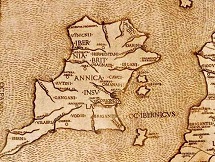
In 168 C.E. Egyptian-born Greek mathematician-astronomer Claudius Ptolemy (90-168) dies in Alexandria, Egypt, leaving Almagest (Arab. "Great Compilation") (original title "Astronomical System"), a 13-vol. system of mathematical astronomy placing the Earth at the center of a static Universe, which is accepted by both the Christian and Muslim worlds until the Christian Renaissance; he also leaves Geography (Geographical Guidance), which incl. a map of the known world with coordinates given, incl. the oldest known map of Ireland, and The Tetrabiblos (Apotelesmatika), a comprehensive work on astrology that becomes a std. work for 1K years, arguing that it is a natural and beneficial study.

They worship the Marlboro Man? In 177 C.E. Smyrna-born (St.) Irenaeus (125-203) was appointed bishop of Lugdunum (Lyons) to attempt the conversion of the Druidic Gauls, and goes to Rome to plead with Eleutherius to deal with the ascetic Montanist movement in Phrygia, which extols virginity, uses Hebrews 6:4-6 to claim that sins committed after baptism cannot be forgiven, and whose prophets go into ecstasy and speak with God's voice in the first person, claiming to supersede the Gospels, which later turns on Romanized Carthaginian Tertullian (160-230), who becomes a Montanist and writes De Ecstasi; followers of Eastern Christianity are driven across the English Channel during the persecutions of Lyons, carrying it with them and founding the Celtic Church in Britain, which takes until 1172 to conform with the Roman Catholic Church in rites and ceremonies (664 in England, 1153 in Scotland and Ireland).
In the 3rd cent. C.E. Mug Nuadaf's son Ailill Aulom (Ollamh) (Olum) becomes king of S Ireland, marrying Sadb Ingen Chuinn, daughter of Conn of the Hundred Battles, and dividing his kingdom between his sons Eogan Mor (Éogan Mór) (founder of the Eoganachta Dynasty of Munster), Cormac Cas (founder of the Dalcassians), and Cian, while his foster son (by Sadb) Lugaid Mac Con becomes Ard Ri (high king) of Ireland; Eogan's son is Fiachu Mullethan (Fiachu Fer Da Liach).
About 300 C.E. Cormac Mac Art (Airt) (Ua Cuinn) Ulfada (Gael. "long beard"), son of King Art, and grandson of Conn of the Hundred Battles rules Ireland as high king at Tara for 40 years, becoming the most famous Tara king.
In 312 C.E. Roman lit. (Nomina Provinciarum Omnium) (Names of All the Provinces) first describes the pesky warring tribe in Ireland as the Scoti (Scotti) (Scots), who harry the Roman province of Britannia and reach as far as the coast of Gaul - the squats? the skotes? the skwotes? the skahts?
In 331 C.E. the Three Colla defeat king Fergus Foga of the Ulaid Tribe in NE Ireland (who gave their name to Ulster) at the Battle of Achadh Leithdheirg in County Monaghan, seizing their territory W of the River Newry and Lough Neagh and burning their capital of Emain Macha.
In 360 C.E. a sudden series of coordinated raids of Wales by Irish, Anglo-Saxons, and Picts begins; the Irish colonize the Isle of Man; the O'Neills trace their family history to this year.
In 393 C.E. Irish raids begin on the N (Pict) and W (Welsh) British coasts - the Squats ah ah-cumin'?
Early in the 5th cent. C.E. Christianity reaches Ireland.
In 405 C.E. Irish raids on Britain end after Niall Noigiallach (Gael. "Niall of the Nine Hostages"), Celtic high king of Ireland (since 378) is KIA at sea; his descendants are called the Ui Neill; his son Eoghan mac Neill (Eógan mac Néill) (-465) (close friend of St. Patrick) of Inishowen in W Ulster in modern-day County Donegal founds the Cenel nEogain (Cenél nEógain) branch of the Northern Ui Neill along with the overkingdom of Ailech (Gael. "the North") (In Fochla) (In Tuaiscert) based in the Grianan of Aileach ring-shaped stone hillfort on top of Greenan Mountain in modern-day County Donegal, whose last king is Mael Sechlainn mac Murichertaig Mac Lochlainn (1177-85), changing to the kings of Tir Eoghain (Gael. "land of Eoghan/Owen") in counties Tyrone, Armagh, Down, Antrim, Londonerry, and NW Donegal as well as Argyll in Scotland, which end with Aed Buide Ua Neill (-1283).

In 431 C.E. Pope Celestine I sends Bishop Palladius (-461) on a mission to convert Ireland, becoming Ireland's first Christian bishop.


On July 28, 432 C.E. Pope Celestine I sends Scottish-born Roman future monk Patricius (hard c) (L. "patricius" = patrician, father of the people) AKA (St.) Patrick (387-461) (who was captured by Irish pirates in the Severn Estuary at age 16 along with thousands of others, and lived as their slave on townless roadless Pirate Island Ireland as a shepherd in Mayo County for six years, developing a love for the Emerald Isle, then escaped to England and became the pupil of Germanus of Auxelle) back to Ireland as bishop after special training to help Palladius in converting the Druids and Arians; he lands in Saul (Gael. "Sabhall Phadraig" = Patrick's Barn) in County Down E of Downpatrick ("Patrick's Stronghold") in SW Ireland, quickly converting local chieftain Dichu, who gives him a barn for church services; allegedly the Druids had predicted his arrival with the prophecy: "Adze-head [the Irish form of tonsure, done to the front part of the head] will come with a crook-head staff [crosier]; in his house head-holed [the first reference to the chasuble, named after a cottage or casa] he will chant impiety from his table [the altar]; from the front [the eastern] part of his house all his household [attendant clerics] will respond, 'So be it! So be it!' [Amen! Amen!]", as mentioned in Muirchu's 683 Life of St. Patrick; after traveling to Donegal in NW Ireland, home of clans governed by Niall of the Nine Hostages, he converts Clan Connail (Dalaigh), becoming his first clan; after he blesses the clan's members, the sign of a cross allegedly appears on the chieftain's shield, becoming their logo; too bad, Patrick allegedly introduces the distillation of usquebaugh (whisky) (whiskey) ("water of life") from oat and barley beer to the Irish, causing the Dalriadic Scots to later bring it with them to Scotland; Ireland is ruled by king Loigaire MacNeill, who presents Patrick with great obstacles, and after lighting a paschal fire on the Hill of Slane opposite the king's council on the Hill of Tara and inviting the Druids to do their worst, he goes on to baptize 120K and found 300 churches in Meath, Ulster, and Connaught, establishing the bishopric of Armagh in Ulster; it takes a cent. after his 461 death to convert all of Ireland, meanwhile turning it into a center of learning, causing it to later begin sending mendicant peregrini (wanderers for Christ) throughout Europe as far as Kiev, wearing the half-corona hairstyle (bald across the front), rough-spun habits, and cowls with rope belts and sandals, bringing literacy to Dark Age Europe, eventually setting up stalls at Charlemagne's court, shouting "Knowledge for sale"; St. Patrick allegedly creates the Celtic Cross by adding the Irish Sun.
In 441 C.E. St. Patrick spends 40 days of Lent in prayer and fasting for the people of Ireland on Croagh Patrick (St. Patrick's Stack) AKA the Reek, a cone-shaped mountain in County Mayo 5 mi. from Westport; a pilgrimage later begins on the last Sunday in July, and later a white Statue of St. Patrick holding a crook in his left hand and a shamrock in his right hand is erected overlooking the Galway Races - Erin go Bragh?
In 453 C.E. after being baptized in his royal seat of Cashel by St. Patrick by blood by driving his crozier through his foot, Oengus mac Nad Froich (Óengus mac Nad Froích) (430-89) of the Eoganachta (Eoghanacht) dynasty centered in Cashel becomes the first Christian king of Munster, imposing a baptismal tax on Christian converts for St. Patrick's benefit.
In 457 C.E. St. Patrick founds his main church in Armagh in Northern Ireland (modern-day pop. 15K), going on to become Ireland's ecclesiastical capital, see of the archbishop of Armagh, and the primate of all Ireland for the Roman Catholic Church and the Church of Ireland.
On Mar. 17, 461 C.E. (by tradition) Ireland's patron St. Patrick (b. 387) dies in Saul after having allegedly driven the snakes out of Ireland and used the 3-leaf hop clover shamrock to illustrate the concept of the Trinity, foiling the evil Arians and Druids at the same time; "May the enemies of Ireland never eat bread nor drink whisky, but be tormented with itching without benefit of scratching" (traditional St. Patrick's Day toast); really dies in 493?; really lives to age 120?; buried in Downpatrick (Gael. "Dun Padraig" = "Patrick's stronghold") 20 mi. S of modern-day Belfast.

In Aug. 476 C.E. Flavius Odoacer (Odovacer) (435-93), Herulian Visigoth chief gen. of the Germanic tribes in the Roman army leads a revolt over a baksheesh matter (free homes in Italy), captures Ravenna, and kills Orestes in Pavia; on Sept. 4 (Sept. 7 Gregorian) (Mon.) Romulus Augustus (461-77?) (AKA Augustulus), the boy emperor of Rome in Ravenna becomes the Last Roman Emperor of the West as he is deposed and exiled to the castle of Lucullus in Campania in S Italy (with 6K pieces of gold per annum allowance) by Odoacer, who proclaims himself Roman emperor of the West, petitioning Emperor Zeno to recognize him as a patrician and ruler of Italy on behalf of the Eastern Empire; Zeno accepts on the last part, but insists that exiled Julian Nepos (d. 480) remain Roman emperor, which he does, on coins; Odoacer uses the old Roman law of hospitality providing for the quartering of Roman soldiers to force Roman landowners to surrender a third of their estates for use by his soldiers; many non-aristocratic Romans welcome the new boss because he will abolish the taxation and police system, while aristocratic Romans in Gaul circle the wagons and create private armies; 753 + 476 - 1 = 1228?; the Dark Ages begin as 1.2K years of progress of civilization becomes kaput in Europe thanks to barbarians and Christian hostility to paganism, which to them incl. all pagan scientific, literary, historical, and cultural works, making all scientists forever suspect of being in league with the Devil by the Christian masses, an impediment that ends in ?, and the very idea of wanting to live for "the world" when the Kingdom of Heaven is dangled in front of your eyes to seem pointless?; "So it was in utter social decay and collapse that the great slave-holding 'world-ascendency' of the god-Caesars and the rich men of Rome came to an end" (H.G. Wells, Ch. 37) - so who is the last emperor, Romulus Augustus or Nepos?
In 476 C.E. after the Western Roman Empire falls, the new Visigoth masters of Italy, Gaul, Spain, and North Africa aren't into Science much, and as they were themselves squeezed by more German barbarians and Byzantine armies, Europe descends into the Dark Ages, where literacy is almost kaput, and money disappears, requiring barter; the onset of the Muslim Great Jihad in the 600s closes the last doors; literacy survives mainly in outlying monasteries in Ireland that only copy religious lit.
In 482 C.E. the Battle of Ocha at Faughan Hill in County Meath sees high king Alill Molt (Alill mac Nath i) KIA by the sons of Niall, fixing the high kingship of Ireland in one family for the next five cents.
In 484 C.E. the first Christian monastery in Ireland is founded in the Aran Islands (Inishmore, Inishmaan, Inisheer) at the mouth of Galway Bay on the barren isle of Killeany, Innish by St. Enda of Aran (450-530); in 546 it is agreed by the kings of Munster and Connacht, whose territories are separated by Galway Bay that the islands should be independent and pay no tribute.
In the late 5th cent. St. Brigid (Bridget) (Gael. "exalted") of Kildare (451-525) founds the double (abbot-abbess) Kildare Abbey in County Kildare, Ireland, keeper of the inextinguishable holy fire, becoming known as "the head city of all the bishops", with first bishop St. Conleth and his successors becoming known as "the archbishops of the bishops of Ireland", with huge crowds arriving to celebrate St. Brigid's feast day of Feb. 1 and receive cures at her venerated shrine; too bad, in 1136 it is sacked by Diarmaid O'Brien and his brothers.
In the late 5th cent. C.E. Irish priest St. Declan (Declán) (Déclán) of Ardmore converts the Deisi (Déisi) of E Munster, and founds the Ard Mor (Ardmore) Monastery in modern-day County Waterford.
In the 6th cent. C.E. the Golden Age of Irish Monastic Scholarship begins (ends 800) as Prince Eudo of Oriel (450-540) founds a school in Arranmore (Arainn) Ui Dhomhnaill on the W coast of County Donegal in Ulster, which draws scholars from all over Europe - free towels and bars of Irish Spring?
In the 6th cent. C.E. the O'Keeffe (O'Keefe) (O Cuiv) clan (Gael. "caomh" = kind, gentle) of the Eoganacht Glendamnach become kings of Munster (ends 8th cent.); the Eoganachta (Eoghanachta) dynasty centered in Cashel dominates S Ireland incl. Munster to the 10th cent., followed by the Kingdom of Desmond and its offshoot Carbery to the late 16th cent.; about 500 Eochaid mac Oengusa (Óengusa) (-522) becomes king of Munster.
About 500 C.E. the three islands of Aran in Galway Bay, Ireland are inhabited by Christian monks (until 800).

Early in the 6th cent. C.E. the Celtic Britons of W England win a V over the marauding German Saxon invaders at the Battle of Badon Hill (Mount Badon) (Mons Badonicus) under King Arthur (Athurius) (Artorus) (-537) (Gael. "rock"), who is later legendized as mixed Gaelic-Latin Arthur Pendragon (Lat. "standard-bearer", "head leader"); this is his 12th "messy battle" with them, during which 960 Saxons die in a single charge, after traitor Vortigern invites the Saxons in; Saxon expansion into W England is delayed for 50 years, and the halcyon Days of Camelot begin in Arthur's lot called Camelot near the town of Queen Camel in Somersetshire or Camelford in Cornwall or Winchester in Hampshire, with a lawn (really an island) called Avalon (Gael. "apples"), where funky druid Mervyn (Myrddin) (Merlin) and bad druidess Fata Morgana (Morgan le Fay) (Gael. "edge of the sea") (fairy half-sister of Arthur) romp with dragons?; Glastonbury Tor, a conical hill in SW Britain surrounded by swamps and marshes (now by meadows) is thought by some to be the Isle of Avalon, the Celtic Isle of the Blessed, where Arthur and his wife Guinevere (Gael. "Gwenhwyfar" = "white and soft or smooth") are allegedly buried (come here, Guinevere, and I'll put my rock in your soft and white?); King Arthur's Round Table is finally located in 2010, and seats 1K? Cadwallon ap Einion Lawhir ("long hand") (460-534) becomes king of Gwynedd in Wales, going on to expel pesky Irish settlers from Anglesey.

About 520 C.E. under Welsh inspiration St. Finian (Finnian) of Clonard (470-549) founds Clonard Abbey (Gael. "Erard's Meadow") on the Boyne River in modern-day County Meath, Ireland at the traditional N-S boundary line on the Esker Riada main E-W road on the boundary between the kingdoms of Meath and Leinster, becoming the leading church of the Irish midlands by the mid-9th cent.; 3K students live in wattled huts and receive open air instruction, eventually sending out the Twelve Apostles of Ireland (Erin) to found schools in Ireland and later the Continent; in 764 the abbey burns, and in 838 the Danes destroy and kill the monks, who return in 888; in 939 Cashel king Ceallachan assisted by the Danes of Waterford plunder it; in 970 Murcha's son Donell pillages and burns it.
In 528 C.E. Irish bishop St. Ailbe (Gael. "ail" + "beo" = rock + living) (Elvis) (Eifyw) (Eifw) (b. ?) dies after becoming the first Christian bishop of Emly in Munster, becoming the patron saint of the archiocese of Cashel and Emly, also regarded as the chief pre-St. Patrick saint of Ireland, going on to become associated with 6th cent. Welsh bishop St. David; really a pagan relic based on Ailbe the divine hound that defended Leinster?
In 536 C.E. extreme weather events become the most severe protracted short-term cooling events in the Northern Hemisphere until ?, with effects extending to Ireland, Europe, the Middle East, Peru, and China, where snow falls in Aug. and summer temps fall 1.5C-2.5C; "For the sun gave forth its light without brightness, like the moon, during the whole year" (Procopius); did this accelerate the coming of the Dark Ages?
In 536-9 C.E. there is a bread famine in Ireland.
In 540 C.E. St. Finian founds Movilla Abbey (Gael. "Magh Bhile" = plain of the sacred tree) on a pagan site on a hill overlooking 58 sq. mi. Strangford Lough (ON "strangr fjordr" = strong sea-inlet) on the Ards Peninsula (largest inlet in the British Isles) 1 mi. NE of modern-day Newtownards, Northern Ireland, going on to becoming a main Irish Christian center; in 825 the Vikings sack it, but it survives until the 1542 Dissolution of the Monasteries; in 1606 Hugh Montgomery founds the modern-day town of Newtown, which becomes Newtownards (modern-day pop. 28K).
In 544 C.E. the first mention of bubonic (blefed) plague in Ireland, which causes the disperson of the disciples of St. Mobhi, while St. Columba (Colmcille) returns to Ulster, founding the monastery of Derry (Gael. "Daire"/"Doire" = oak grove) on the W bank of the Foyle River in County Donegal at the S end of Inishowen Peninsula (modern-day pop. 83K/90K).
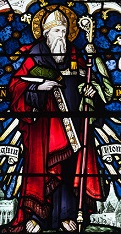
In 544 C.E. St. Ciaran (Ciarán) of Clonmacnoise (516-49) founds a monastery at Clonmacnoise (Gael. "meadow of the sons of Nos") on the Shannon River S of Athlone in County Offaly, becoming the most famous monastery in Ireland along with Clonard, associated with the kings of Connacht until the 9th cent., and the kings of Meath in the 9th-11th cents., becoming the burial place of many kings of Tara and Connacht; it is destroyed in 1552 during the dissolution of the monasteries.
In 549-50 C.E. the plague returns to Ireland.
In Jan. 549 C.E. the Battle of Cul (Cuile) Clonaire in Cera, County Mayo, Ireland sees Connacht king Ailill Inbanda (Gael. "womanish", "vigorous") and his brother Aed Fortobol (Gael. "the strong") defeated and KIA.
In 550 C.E. the Yellow Plague in Ireland kills two-thirds of the pop.?; next in 664.

The original Holy Blood, Holy Grail authors vs. Dan Brown copyright lawsuit? In 561 C.E. the Battle of Cooldrumman (Cúl Dreimhne) (Battle of the Book) in modern-day Drumcliff, County Sligo, NW Ireland results when St. Columba of Iona copies a ms. without permission, and Ard Ri (Irish high king) of Tara Diarmait mac Cerbaill (-565) rules: "To each cow its calf, to each book its copies"; too bad, Columba's supporters don't agree, and fight it out, and after 3K are KIA, Columba loses and is banished from Ireland, swearing off fighting and looking for the first livable piece of land to settle on. On May 12, 563 C.E. Celtic Christian Irish missionary (St.) Columba (Colmcille) (521-97) and his 12 companions from Ireland run into and settle on the 5-sq.-mi. island of Iona off the Isle of Mull on the W coast of Scotland (part of the kingdom of Dalriata), going on to found the Mother Church of Scotland, which becomes a monastic center of learning, and later produces St. Aidan, apostle of Northumbria and St. Finian, apostle of Wales.
About 566 C.E. St. Columba reports seeing and exorcising a strange creature in Loch Ness - funny how the rumors of Nessie are started by a copyright pirate?
In 570 C.E. Irish monk St. Brendan discovers America about this time? - you don't feel the cold when you're drunk?
In 588 C.E. a great snow rocks Ireland.


In 590 C.E. Meath (Leinster)-born (St.) Columbanus (543-615) (Lat. "white dove") of Bangor Abeey in County Down, Northern Ireland starts a missionary tour of France with 12 disciples, and founds the Luxueil Abbey in Burgundy, France, spreading Celtic Christianity (half-corona tonsure, different date of Easter and consecration of bishops, and a more austere rule than the Benedictines) on the Continent in competition with Roman; he later founds monasteries at Annegray (in the Vosges Mts.), and Fontaines-les-Luxeuil; his disciple St. Gall (Gallen) (Gallus) (550-646) founds the St. Gallen Monastery in Switzerland, which Charlemagne makes into an imperial abbey and goes on to evolve into one of the world's largest breweries.
In the 6th cent. C.E. Skellig Michael Monastery 7.2 mi. W of the Iveragh Peninsula in County Kerry, Ireland is founded (7th cent.?); it is abandoned in the late 12th cent.
In the 7th cent. C.E. Skellig Michael (Michael's Rock) one of the three Skellig ("splinter") islands 10 mi. off the coast of Ireland is inhabited by monks, who develop a cashless society (until 1200).
In 600 C.E. Irish Celtic church missionary Columbanus refuses to attend the Council of Chalons - those long-haired pot-smoking hippies turn me off?
In 603 C.E. Columbanus is charged by a synod of Frankish bishops with the error of keeping Easter according to Celtic custom; meanwhile, the Celtic Church orders him to return to Ireland to answer for accepting other Roman Catholic rules, but he refuses to go and writes them a letter instead.
In 604 C.E. the joint high kings of Tara in Ireland are assassinated; Aed Saine (aed Mac Diarmato), son of Diarmait mac Cerbaill of the Southern U Nuill dies; his descendants become known as the Sil nAedo Slaine (seed of Aed Slaine), becoming kings of the petty kingdom of Brega (Gael. "Magh Breagh" = fine plain) N of Dublin bounded on the S by the Liffey River and on the N by the Sliabh Breagha hills in modern-day S County Louth, which incl. the Hill of Tara near the Boyne River in modern-day County Meath, where the high kings of Ireland are proclaimed on the Lia Fail (Stone of Destiny); the N part is called Knowth.
In 664 C.E. the Great (Yellow) Plague begins again in Britain and Ireland (ends 668); last in 550.

In spring 664 C.E. under Northumbrian King Oswy's guidance the Synod of Whitby ("white farm"), hosted by abbess (St.) Hilda of Whitby (614-80), and dominated by Ripon abbot (St.) Wilfrid (Wilfrith) of York (634-709) debates whether the Roman Catholic Christianity of Augustine of Kent or the Celtic Christianity of Aidan of Northumbria should be the one and only for England, and ends with King Oswy deciding that Kent tastes good like a Christianity should, along with an agreement over the date of Easter and the adoption of the Peter-keyed Roman Catholic faith for Northumbria; the Celtic rite, centered in Lindisfarne Abbey in Northumbria under Bishop Finian is replaced with the Roman rite, centered in Canterbury, Kent; Iona doesn't accept the Roman Easter until 716; the Celtic Church now begins to decline (ends 1172), and there is a unified English church before there is an English nation?
In 688 C.E. according to Venerable Bleed, er, Bede, "The rain turned to blood in Britain, and in Ireland milk and butter turned to blood."

In 697 C.E. (St.) Adamnan (Adomnán) (Adamnan) (Adamnán) (624-704), abbot #9 of Iona Abbey (679-704) (St. Columba's biographer) and Iish high king Loingsech mac Óengusso (-703) in convoke the Synod of Birr in Birr (modern-day County Offaly), Ireland on the boundary between the N half of Ireland (dominated by the Ui Neill) and the S half (dominated by the Eoganachta kings of Munster), which proclaims the Cain (Law of) Adamnain (Adomnáin) (Law of the Innocents) in Ireland, protecting women, children, and clerics in war, prohibiting women warriors, and punishing domestic abuse of women incl. vulgar language and groping; the N Irish church submits to Roman Catholic usage, but the bond with Rome isn't, ahem, real close?
In 699 C.E. a cattle plague begins in Britain, spreading to Ireland by next year, adding to their woes of famine.
In 703 C.E. British raiders are defeated by the Ulaid tribe of NE Ireland (who gave their name to Ulster) at Ars peninsula in Ireland.
About 715 C.E. Cathal mac Finguine (-742) of the Eoganacht Glendamnacht becomes king of Munster based in Cashel (until 742), becoming high king of Ireland, the most powerful Irish king of the first half of the 8th cent., and strongest from Munster before Brian Boru.
In 717 C.E. at the instigation of the Northumbrian Trinitarian clergy, King Nechtan Mac Derile expels the Irish Arian clergy (linked to Iona) from Pictland.
In 724 C.E. Clann Cholmain takes overlordship of the Ui Neill in Ireland.
On Feb. 8, 730 C.E. (Wed.) an earthquake is recorded in Ireland.

On May 26, 735 C.E. English Benedictine monk-scholar Venerable Bede (b. 673) dies in Jarrow, Northumbria, leaving 45 vols. of writings, incl. 25 Commentaries on Scripture, and English Trans. of the Gospel of John (finished on his deathbed); he leaves the soundbyte: "The Irish, that harmless nation which has always been so friendly to the English."
In 763 C.E. Irish Ailech king Niall Frossach (Gael. "flowery", after showers of silver, honey, and wheat fall on his home in Fahan, Inishowen at his birth) mac Fergaile (718-78) of the Cenel nEogain branch of the Northern Ui Neill, son of Irish high king Fergal mac Maele Duin (-722) and brother of Irish high king Aed Allan (-743) becomes high king of Ireland, proclaiming the law of St. Patrick in force instead of the law of Columba of Iona, facing a challenge from Donchad Midi of Mide before abdicating about 772.
In 771 C.E. Donnchad Midi (-997) of Clann Cholmain becomes king of Mide in Ireland, going on to seize the monastery in Clonard in the Leinster borderlands in 775, campaign in Munster, devastating their territory, and invading Brega in 777, defeating and killing Knowth king Congalach mac Conaing (-778) in the Battle of Forchalad in 778.
In 793 C.E. Artri (Artrí) mac Cathail (-821), son of Cathal mac Finguine becomes king of Munster (untl 820), becoming the last king from the Glendamnach branch of the Eoganachta.
In 793 C.E. the Antichrist Thor's Hammer Odin's Raven Norse Vikings sack the English island Lindisfarne Monastery in Northumberland (founded 635), terrorizing and messing it up so much that it haunts the English for cents.?; many mss. are destroyed, incl. history materials about the Celts, plaguing later historians - causing Viking victims to see Devil horns on their helmets in their nightmares?
In 795 C.E. the first Viking raids on Ireland begin in Reachrainn (Lambay Island 5 mi. NE of the Irish mainland off N County Dublin), Rathlin Island (northernmost point of Northern Ireland), plus two monasteries on the W coast incl. Iona and Inishmurray; at this time there are no cities, stone bridges, or foreign trade to speak of in Ireland; about this time the Gaelic poem The Guardian Storm is written; "It plows up the wild hair of the sea,/ I have no fear that Viking hosts/ Will come over the water to me". :)
In 798 C.E. the Vikings destroy the monastery on St. Patrick's Island in County Dublin.
In the 9th cent. C.E. Viking traders begin bringing slaves into Ireland, lasting until the 1000s.
In the 9th cent. C.E. Vikings found the town of Arklow ("meadow of Arnkell") in County Wicklow at the mouth of the Avoca (Avonmore) River under Arklow Hill on the E coast of Ireland near Dublin (modern-day pop. 14K/13k); the Nineteen Arches Bridge linking the S and N parts (Ferrybank) of town becomes the longest handmade stone bridge in Ireland.
About 800 C.E. Vikings found the town of Wexford ("Veisafjordr" = inlet of the mud flats) on the S side of Wexford Harbor, estuary of the Slaney River near the SE corner of Ireland (modern-day pop. 20K).

About 800 C.E. the Book of Kells (Columba) (named after the Abbey of Kells in County Meath, 40 mi. NW of Dublin) is created, consisting of the Latin Gospels written in Irish majuscule script with fantastic artwork; compiled at Iona?; it orginally has a cover of gold studded with precious stones.
In 802 C.E. the Vikings sack and burn the monastery of Iona, and begin dominating Scotland.
In 804 C.E. a great storm in Ireland erodes the coast of County Clare, Ireland, and splits Mutton Island into three parts, killing 1,010.
On June 4, 806 C.E. there is a lunar eclipse in Britain, followed by a solar ring eclipse on Aug. 30; meanwhile there is a plague in Ireland.
In 806 C.E. the Columban Monastery of Iona is sacked and burned yet again by the Vikings after killing 63 monks on the beach; the 7th cent. Book of Kells (ornamented vellum copy of the Gospels created in the monastery) is taken back to Ireland.
In 812 C.E. the Vikings found the city of Limerick (Luimneach) (Loch Luimnigh) (modern-day pop. 94K/162K) in midwest Ireland (Munster) as a walled city on King's Island in the Shannon River.
In 820 C.E. Cork and Clonfert Abbey abbot Fedelmid mac Crimthainn (-847) of the Cenel Fingin sept of the Eoganacht Chaisil becomes king of Munster in Ireland, later being considered a saint.
In the 830s C.E. Viking raids in Ireland grow more intense.
In 834 C.E. the pagan Danish Vikings are successful in Ireland, overrunning the N and taking Dorestad (934-7), along with Dublin (Gael. "Diblinn" = black pool) (a dark tidal pool where the Poddle River enters the Liffey River at the site of the Castle Gardens at the rear of Dublin Castle?) (Gael. Baile Atha Cliath, "town of the ford of the hurdles", from the wattled frames spanning the Liffey River) in EC Ireland (Leinster) at the mouth of the Liffey River on Dublin Bay (inlet of the Irish Sea) (modern-day pop. 550K/1.9M), and ruling a unified Ireland until 841; originally the Viking settlement of Dyflin near the Christian Gaelic settlement of Ath Cliah ("ford of hurdles"), where all the main highways of Ireland meet; 40-ft.-high. 80-ft.-diam Thingmote Hill is used as an assembly location (destroyed 1685); no main place names in Ireland (except Waterford) end up getting named by the Norse, unlike in Scotland, although Ulster, Munster, and Leinster are indicative of an earlier Norse-Gaelic pidgin?; the Vikings begin their attacks on England and the continent, approaching the mouth of the Thames River just as King Egbert of Wessex thinks he has England sewn up for Christ, starting small with hit-and-run raids, alternating with raids on the continent, then working up to a serious invasion in 865.
In 836 C.E. the first known inland Viking raid in Ireland takes place.
In 840 C.E. the Vikins begin setting up forts, ramping up their attacks to the point of conquering Ireland, causing Irish kings and abbots to mount defenses and counterattacks and hold their ground; Dublin becomes the center of Viking trade with the Continent after Turgesius (Turgeis) (Thorgest) (-845) arrives and declares himself "king of all the foreigners in Erin", and a longship port is constructed at a ford on the Liffey River; Dublin becomes the seat of Viking power in Ireland; meanwhile the continual wars between petty Irish kings draw Vikings into on-again off-again alliances, the Vikings eventually becoming allies of the kings of Leinster.
In 841 C.E. the Vikings begin to permanently settle Dublin and Limerick, wintering over until 842.
In early 842 C.E. the Vikings complete their first "over-winter" in Dublin; the Irish and Vikings form an alliance for the first time; after the thaw, the Vikings sack London and Rochester (former Roman town of Durobrivae) in Kent.
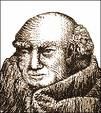
In 845 C.E. after he attacks Clonmacnoise and Clonfert, future Irish high king #1 of all Ireland (846) Mael Sechnaill mac Maele Ruanaid (Máel Sechnaill mac Máele Ruanaid) (-862) captures and drowns Viking leader Turgeis (Turgéis) (Turgesius) (Thorgest) in Lough Owel; meanwhile Irish-born Johannes Scotus Erigena (Eriugena) (815-80) is summoned to France by Charles II the Bald and appointed head of the palace school, and commissioned to translate the Neoplatonic works of Dionysius the Areopagite into Latin.
In the 2nd half of the 9th cent. C.E. the Roman Catholic Church fragments, and the pope becomes a puppet for the next two cents., right when the big one-oh-oh-oh is nearing, like a speeding train with no one driving and blonde devils breathing down their necks?; meanwhile "Almost all Ireland comes flocking to our shores with a troop of philosophers", according to a Frank.
In winter 850/1 C.E. Danish Viking raiders overwinter in England (on the Isle of Thanet in Kent) for the first time ever, beginning a transition to colonizing; meanwhile the Norwegian and Danish contingents of Vikings begin warring between themselves for power in Ireland, causing a 40-year lull in Viking raiding activity there?
In 853 C.E. the Vikings found Waterford (Norse "wether" + "fjord" = ram + fjord) in Munster, SE Ireland at the outlet of the Suir (Siur) River (modern-day pop. 53K/83K); in 902 it is vacated along with all other longship ports after the native Irish drive them out; in 914 the Vikings return and build it into Ireland's first city, becoming the oldest city in Ireland to survive to modern times.
In 862 C.E. Malesechnaill dies, and Aed Findliath ("fair-grey") mac Neil (-879), son of Niel becomes king of Ireland.
In 870 C.E. an army of Danish Vikings under Ivar the Boneless invade England and capture East Anglian king (the last) Edmund, then ritually sacrifice him with the good ole blood-eagle, and destroy Peterborough Monastery; Ivar heads to Ireland, where he conquers Dublin, leaving his brother Halfdan in charge; at the end of the year the Viking hordes turn their attention to Wessex, which is all that stands between them and complete subjugation of the island, coming from East Anglia and invading the Kingdom of Wessex, disembarking from their longboats by the ferry crossing at Maidenhead ("Maiden Hythe" = new wharf) on the Thames River in modern-day Berkshire, then fight their way to Reading in modern-day Berkshire at the confluence of the Thames and Kennet Rivers 37 mi. W of London and 24 mi. S of Oxford, making it their regional power base - like we couldn't guess, just then a "he-ruh" arises to help the Anglo-Saxons fight for their "free-ee-ee-dom" and save Christian England from the Antichrist Vikings?
In 872 C.E. *873?) Ivar the Boneless dies of natural causes in Dublin.
In 876 C.E. Forty Years Rest begin in Ireland (until 916), seeing Viking raids die down.
In 877 C.E. Mercia and Northumbria now have certified Viking Danish kings; Halfdan follows in the footsteps of his brother Ivar and sails to Ireland to secure the throne of Dublin, but is defeated and killed by Norwegian Vikings in the Battle of Strangford Lough; Guthrum is promoted to CIC of the Danish army based in Cambridge.
In 877 C.E. Flann Sinna (847-916) becomes king of Mide, followed on Nov. 20 by high king of Tara in Ireland (until May 25, 916) after the death of his stepfather (1st cousin) Aed Findlath.
On Nov. 11, 892 C.E. a great wind (hurricane?) hits Ireland, destroying forests and wooden bldgs.; the Anglo-Saxon Chronicle records a comet with a long tail this year.
In 896 C.E. a bread failure in Ireland is caused by "vermin like moles with two teeth" which fall from the air and eat the crops up, according to the Anglo-Saxon Chronicle; meanwhile plague and murrain ravage Britain.
In the 10th cent. C.E. the Senchus Fern Alban (fer n-Albann) (History of the Men of Scotland) is written by anon., containing genealogies for the kings of Dal Riata along with a census.
On Sept. 13, 908 C.E. after one of his lt.'s horses stumbles and throws him, which is considered a bad omen, causing many desertions from his army, renowned scholar, abbot, archbishop and king of Munster (since 902) Cormac mac Cuilennain (Cuilennáin) (b. ?) is KIA by Irish forces under high king (877-) Flann Sinna (Flann of the Shannon) (847-916) and his son-in-law Cerball mac Muirecain (-909) (king of Leinster) in the Battle of Bellaghmoon (Belach Mughna) near Castledermont in S County Kildare, Leinster, falling from his horse and breaking his neck, and after beheading his head is taken to Flann Sinna, who calls it an "evil deed" and kisses and carries it around him 3x to show respect.

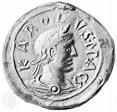
In spring 911 C.E. Norse Viking chief Rollo (Hrolf) (Rolf) Ragnvaldsson (the Ganger) (the Walker) (Wend-a-Foot) (845-930) (who once explored the E coast of North Am. as far S as Conn.?) sails down the Seine River with a raiding and settling party, and sieges Chartres, then prepares to ransack gay Paris, until whimpy king of the West Franks (Charles III, you are no Charlemagne?) Charles III the Simple (879-929) (probably hearing that the Vikings can be bought off, like Eli Wallach in the film "The Magnificent Seven", and saying something like, "Rollo, please do not sack gay Paree, just take this box of treasure, and I'll make you a duke and give you my beautiful daughter, the hottest French poontang in the land, and you can move into the bad side of France and have the left bank of the Seine, plus a little of the right bank, where you can have some Lebensraum and act as bouncers for any other Vikings, how about it, guy"?) cops out, and in the fall signs the Piece, er, Treaty of Saint-Clair-sur-Epte (Fr. "sint clair" = "clear well or pool"), granting them land on the left bank of the Seine River (the bad side of France?), with Rouen (on the right bank) (named after him, which is convenient, because it was originally the Gallic city of Ratumacos) as their new capital, on the condition that they defend the land, receive Christian baptism, and do homage to Charles as their overlord; Charles also sweetens the pot by giving Rollo his daughter (sister?) (all made up?) Gisela of France in marriage to cement the deal; when Rollo's proxy goes to perform the rite of allegiance by kissing the king's foot, the rude Viking stands erect, lifts the royal foot to his mouth and topples Charles over backward, causing Rollo's men to have a good laugh?; Rollo founds the French duchy of Normandy (Northmen Duchy - get it?), becoming duke #1 (until 927), and is baptized under the name Robert, becoming Duke Robert I; the Norsemen acquire the French language and culture (which they proceed to inject with Norse words and turn into their own dialect), learn to ride horses, build forts and siege machinery, and continue their raids on Brittany; Charles III's act is so unpopular with his barons that they start calling him Charles the Simple, and later depose and imprison him for it; Charles acquires Lorraine from France.
In 914 C.E. large Viking fleets return to Ireland and refound Waterford (ON "Vedrafjoror" = windy fjord) in the SE (Munster) (modern-day pop. 50K), becoming the oldest Irish city with a Norse name - because it almost sounds English?
In 915 C.E. the Vikings occupy and expand the 6th cent. monastic settlement (founded by St. Finbarr) of Cork (Gael. "corcach" = marsh) on the Lee River in Munster, SW Ireland (modern-day pop. 125K/208K), turning it into a trading port, with its harbor becoming one of the largest natural harbors on Earth by navigational area; the city is granted a charter by Prince John in 1185.
On Sept. 14, 919 C.E. Niall Glundrub and 5-12 other chieftains (the cream of the Ui Neill) fall to the Dublin-based Vikings of the Ui Imair (Ivar Dynasty) under Sitric (Sihtric) Caech (Cáech) (Sigtrygg Gále) (-927) at the Battle of Islandbridge (Ath Cliath) near Islandbridge, County Dublin.
In 928 C.E. the Vikings massacre Irish at Dunmore Cave in County Kilkenny, Ireland.

In 968 C.E. the Irish of the Dal Cais under Brian Boru defeat the Vikings of Limerick under Ivar of Limerick (-977) at the Battle of Sulcoit in County Tipperary, then burn Limerick the next day, marking the end of Norse expansion in Ireland; in 970 Mathgamain mac Cennetig (Cennétig), elder brother of Brian Boru deposes Munster king (since 959) Mael (Máel) Muad (Molloy) mac Brain (-978), becoming king of Munster until 976, when he is KIA; in 976 C.E. Brian Boru (Boruma) (940-1014) succeeds his brother Mahon as king of the Dalcassians (Dal Cais) based on the River Shannon in Munster, becoming a rival to the Ui Neills and going on to conquer Dublin, Leinster, and all of Ireland; in 978 Molloy is defeated and KIA in the Battle of Belach Lechta (Leachta) by Brian Boru, who becomes king of Munster.
In 980 C.E. after the C Asian silver mines become exhausted, causing their Russian trade routes to collapse, dormant Danish Vikings wake up and again begin to sail their dragon ships to England in hopes of plunder, especially silver, attacking Chester, Southampton, and Thanet; the Vikings from Dublin under Ragnall (Reginald), son of ex-pagan Viking king of Dublin (since 945) Olaf Cuaran (927-81) (known for his love of pillaging churches before converting to Christianity in the 940s) are defeated by the Gaelic Irish of Meath under Malachy II (Mael Sechnaill mac Domnaill) (949-1022) at the Battle of Tara in Ireland, giving the Irish control of the kingdom of Dublin; Ragnall is KIA, and Olaf Curan gets Millennium Fever, abdicating and sailing to Iona in the Hebrides as a penitent, where he dies within a year; Malachy II takes Dublin in a 3-day siege and frees all the slaves, gaining a stronger hand in his rivalry with Munster king Brian Boru.
In 989 C.E. halfbreed Norse-Irish (Norse father, Irish mother) Sigtrygg (Sitric) (Sihtric) (Sitrick) (Sigtryg) (Sigtryggr) II Silkbeard Olafsson (970-1042) of Dublin suceeds his paternl half-brother Gluniaim as king of Dublin (until 994), while his rival Ivar of Waterford waits in the wings, and future Norway king Olaf Tryggvason moves in for a few years (until 994) after marrying Sigtrygg's sister Gytha, plundering his foes and weakening them.
In 994 C.E. Ivar of Waterford expels Sigtrygg Silkbeard from Dublin, but he returns within a year.
In 995 C.E. Sigtrygg Silkbeard and his nephew Muirchertach Ua Congalaich attack the church in Donaghpatrick in County Meath, pissing-off Mael Sechnaill, who raids Dublin and steals the ring of Thor and the sword of Carlus, pissing-off Sigtrygg, who attacks Kells and Clonard in 997.
In 997 C.E. Brian Boru of Munster and Malachy II of Meath meet in Clonfert and make a truce giving rule of S Ireland to Boru and the high kingship and rule of N Ireland to Malachy II, agreeing to hand over their hostages next year and begin working against the Norse of Dublin for the first time; too bad, the Leinsterman ally with the Norse of Dublin and revolt against Boru, fomenting a final battle.
In 998 C.E. Mael Sechnaill (Malachy II) and Munster king Brian Boru force Sigtrygg Silkbeard to recognize their lordship by giving hostages.
Why am I dressed up like a baby, I've no clue? There's no MF way over here? In 999 C.E. Dublin king Sigtrygg (Sitric) (Sihtric) (Sitrick) (Sigtryg) (Sigtryggr) II Silkbeard Olafsson (970-1042) (known for minting the first Irish coins) and his maternal uncle Maelmordha (Mael Morda) mac Murchada (-1014), king of the Ui Faelain of N Leinster defeat their cousin, Leinster king #10 (last) (until 1003) Donnchad mac Domnall Claen (Donnchad mac Dómnaill Clóen), and imprison him in Dublin. On Dec. 30, 999 C.E. after revolting against Irish Ard Ri (high king) Brian Boru (Boruma) (940-1014) of Munster and Meath Ard Ri (high king) Malachy II (Mael Sechnaill mac Domnaill) (949-1022), they are defeated at the Battle of Glenn Mama (Glenmama) (Glen of the Gap) in the foothills of the Wicklow Mts. near Lyons Hill between Windmill Hill and Blackchurch in Ardclough, County Kildaire; the V leaves the road to Dublin "free and unimpeded for the victorious legions of Brian and Mael Sechlainn" (Dictionary of English History); Maelmordha escapes by hiding in a yew tree; Brian Boru magnanimously reinstates both of them in their kingdoms, but the humiliation festers for years.
In 1001 Brian Boru leads his army from Kincora to Athlone on the Shannon River S of Lough Ree in C Ireland to attend a gathering.
In 1002 Irish high king Brian Boru defeats the Norse, and Mael Sechnaill recognizes him as high king of Ireland.
In 1005 Irish Ard Ri (high king) Brian Boru (Boruma) (940-1014) of Munster is declared emperor of the Irish in Armagh.
In 1006 Malcolm II launches a plundering raid into N England, but his army is routed in the Battle of Durham, causing his men to go home without booty, hurting the new king's prestige; meanwhile Brian Boru adopts the title of "Emperor of the Gael" to signal to Malcolm II that he is the #1 Gaelic king.

Pass the shillelaghs? On Apr. 23, 1014 (Good Friday) 73-y.-o. Irish (Dal Cais) high king Brian Boru (b. 940) (pr. BRAN boh-ROO) of Munster with an army of 20K from Munster, the Midlands, and S Connacht defeats the Norse and Leinster Irish at the Battle of Clontarf Plain near Dublin, breaking Norse power in Ireland forever, although they still dominate some cities; Boru has a shield wall formed around him because he won't use a weapon on Good Friday, letting his son Murchad, grandson Toirdelbach (b. 999) and cousin Conaing take command, and later begins praying in a tent in Tomar's Wood; after the Banshee of Dalcais Aibell (guardian spirit of the Dalcassians or O'Brien clan) warns him and he ignores it, Brian is murdered in his tent behind the lines after his big V when his men go off pursuing fugitives by loose Dane Brodir of Man, despite Brian's young son Tadg trying to protect him, cutting off the boy's arm and the king's head; Brodir and his companions are captured and executed by being tied to a tree with their own intestines; Jarl Sigurd, Dubhgall and Maelmordha are KIA, and no Viking of rank is left alive; Brian's younger brother Malachy McDonnell (Mael Sechnaill mac Domnaill) (949-1022) becomes Irish high king (until Sept. 2, 1022); Brian's grandson Toirdelbach drowns, his nephew Conaing is KIA, and his son Murchad dies the next morning of a wound; total losses are 6.7K Vikings, 1.1K Leinstermen, and 4K of Brian's men; Sigtrygg continues to rule Dublin until 1034; no foreign Scandinavian army fights on Irish soil for the next cent. and a half; Ireland falls into anarchy as the O'Brians of Munster (S Ireland)), the O'Neils of Ulster (N Ireland), and the O'Connors of Connacht (Connaught) (W Ireland) begin a struggle for supremacy - slainte?
In 1015 a plague is recorded in Leinster, Ireland.
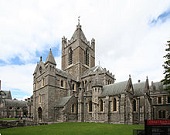
In 1028 Christ Church Cathedral in Dublin, Ireland is founded on high ground overlooking the Viking settlement of Wood Quay by Dublin king Sigtrygg Silkbeard en route to a pilgrimage to Rome, with Dunan (Donat) as bishop #1; at first answerable to Canterbury, it goes on to become the official seat of the Roman Catholic archbishops of Dublin and the Church of Ireland.
In 1029 Sigtrygg Silkbeard's son Aulay (Amhladh) (Amhiaoibh) (Auliffe) (Olaf) is taken POW by Mathghamhain O Riagain (Reagan) (Regan) (a Dalcassian family descended from Riagan, son of Brian Boru's brother Brian Boru), new lord of Brega (Breagh), and ransomed for 1.2K cows, 140 British horses, 60 oz. of gold and silver, the celebrated Sword of Carlus, and the Irish hostages of Leinster and Leath Cuinn, plus 80 cows "for word and supplication" to the man who negotiated his release; soon afterward the O'Reagans are dispossessed and dispersed throughout Ieland.
In 1029 Gudlief Gudlaugson the Icelander embarks from Limerick, gets lost, and later claims to have discovered Irish-speaking people to the S of Vinland in Great Ireland (Hibernia Major) AKA Albania (White Men's Land).
In 1030 Sigtrygg Silkbeard allies with English king Cnut to raid Wales by sea; Silkbeard goes on to establish a Dublin colony in Gwynedd.
In 1035 Sigtrygg Silkbeard of Dublin plunders the stone church of Ardbraccan (Gael. "Hill of Braccan") in Meath, Ireland, burning 200+ men alive inside and taking 200 more into captivity; in revenge Conchobhar Ua Maeleachlainn plunders and burns the church at Swords and takes away cattle and captives; meanwhile Sigtrygg executes Waterford king Ragnall (grandson of his early rival Ivar) in Dublin, after which Echmarcach mac Ragnill (-1065) king of the Isles forces Sigtrygg to abdicate in 1036 and flee to exile, where he dies in 1042.
In 1042 Diarmait mac Mael (-1072) claims the title of king of Leinster, and installs his son Murchad mac Diarmata (Murrough MacDermot) (-1070) as king of Dublin.
In 1052 the Irish wrest control of Dublin from the Danes (until ?).
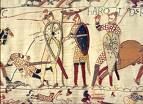




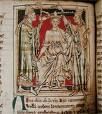

1066: Pop. of Anglo-Saxon England: 1M. The 270' x 20" Bayeux Tapestry (embroidered wool cloth on a linen canvas), created by the victorious Normans starting next year tells the tale of the Norman Conquest of England in the Big Year 1066, incl. the Comet, the Big Bad Conqueror, and Harold with an Arrow in His Eye with Diamonds, complete with a cast of 600 people, 200 horses, 40 ships, and a cameo by Edward the Confessor; only 15 people are named, and only six named in standalone fashion, incl. Harold (twice), William, Robert, Eustace, and the mysterious Turold the Dwarf - the original Sgt. Pepper? I wish I was a little bit taller, like six foot nine? On Jan. 5 Edward the Confessor (b. 1003) (son of Ethelred II and Emma) dies childless in London, and his remains are entombed behind the High Altar of Westminster Abbey, starting a tradition that carries through to George II as every English monarch except Edward V and Edward VII is crowned there; he leaves no Saxon heir to the English throne, but allegedly names his 6'4" blonde brother-in-law Harold Godwinson, earl of Wessex (grandson of prior king Hardicanute Godwin, son of Canute and Emma) as his successor on his deathbed, and on Jan. 5 the Witan elects Harold, who is crowned Harold II Godwinson (1022-66), the 20th monarch of England (last Anglo-Saxon) at Westminster Abbey on Jan. 6, after which on Mar. 20 Halley's Comet appears, which his fellow Anglo-Saxons take as a bad 666 omen (6-6-66); "And in this year also earl Harold was hallowed king; and he experienced little quiet therein, the while that he ruled the realm" (Anglo-Saxon Chronicle); his rival, Norman duke #6 William II (the Bastard) (1026-87) (1st cousin, once removed of Edward the Confessor via his mother Emma, whom he is the grandnephew of) claims the throne by right of succession, and also claims that both Edward and Harold had promised it to him, and gets Harold excommunicated by Pope Alexander II for his dirty business over the exiled Norman archbishop of Canterbury and for not deposing the Anglo-Saxon one, helping William's army by giving him a consecrated banner as a sign of papal approval in hopes of turning the English people gainst Harold, while assembling a fleet of 700 ships in Dives-sur-Mer on the coast of Normandy and assembling an army on the Isle of Wight, causing Harold to begin guarding the coasts of England against William during the summer; too bad, on Sept. 8 after provisions run low, a large part of Harold's force disbands in order to bring in the harvest, and he returns to London; meanwhile Harold's pissed-off brother Tostig Godwinson, earl of Northumbria sails to Norway and persuades Viking king (since 1046) Harald III Hardrada (Haardraade) (1016-66) (did his wife call him that or was he just bragging?) to help him seize the crown, and after waiting for a storm to pass on Sept. 12, they arrive together with a fleet of 270 ships, plunder the coast and burn Scarborough, then sail up the Humber River, attacking from the N at York and defeating the N earls on Sept. 20 at the Battle of Fulford Gate outside Jorvik (York); after receiving the bad news, Harold II issues the immortal gay-curious soundbyte: "I will give him just six feet of English soil, or, since they say he is a tall man, I will give him seven feet"; on Sept. 20 Harold leaves London, gathers the remainder of his c oastal militia along with his thegns and household troops (leaving the S coast unwatched, which gives Duke William his chance), and makes a brilliant dash N, covering 190 mi. in five days, surprising the invaders on Sept. 25 at the Battle of Stamford Bridge 8 mi. E of Jorvik in modern-day East Riding of Yorkshire, becoming the greatest battle so far between Norse and Anglo-Saxons; the over-confident Vikings decide not to wear their armor of leather jerkins with sewn-on metal rings because of the heat, and Harald is KIA with an arrow through his throat; Tostig and many other Vikings are also KIA, and only 30 Viking ships make it back to Norway; England has now been made safe for Anglo-Saxons forever, and they can keep speaking German and there will never be a Shakespeare, right?; too bad, Duke William, promising spoils, has been busy gathering an army of 6K-12K (7.5K?) from Normandy and all over Europe, incl. France, Italy, and Spain (incl. 1K mainly landless Norman knights, plus 500 more from Flanders and Brittany), and sails from Bayeux in Normandy in his long ships (his ship is the Mora, bought for him by his wife Matilda), landing on Sept. 28 in Pevensey (pee in the sea?) on the SW tip of Sussex (65 mi. SSE from London), proceeding to terrorize the countryside, making use of the Chevauchee to burn and pillage in order to force Harold to fight while marching E to Hastings, causing tired Harold and his brothers Gyrth Godwinson (1032-66) and Leofwine Godwinson (1035-66) to hastily attempt to gather a larger force than William (the N earls are too late, and forces end up about equal, incl. 2K-3K Saxon housecarls, and hardly any cavalry like the Normans have, because the insulated Anglo-Saxons never learned to fight on horseback), then march 58 mi. in three days, waiting for William the Bastard a few mi. from Hastings on Caldbec Hill, which with Senlac Hill (Ridge) (originally Santlache, OE for sandy stream, then renamed by the Normans to Sanguelac, Fr. for bloody lake) guards the interior; on Oct. 14 (Oct. 21 Gregorian) (Sun.) after William learns of their position, the 8-hour unhasty Battle of Hastings (Senlac) (one of the longest medieval battles) features the Companions of William the Conqueror fighting an Anglo-Saxon shield wall with feigned Norman retreats to cut them down with cavalry as they try to climb back up the hill; both sides wear chain mail at least, but the Normans have archers and knights, and the Anglo-Saxons take 4K casualties to 2.5K for the Normans, contracting them around tall, blonde, good-arm John Elway, er, Harold, until William's cavalry drives home a charge at Harold, who stands his ground surrounded by his housecarls, but is KIA by an arrow through the eye (according to the Bayeux Tapestry) in the next Norman charge, then his brothers are KIA, and his depleted army flees after losing 35% of their men, later regrouping then suffering more deaths from dysentery; the battle is so close that if Harold could have held out for another hour, an approaching Saxon fleet could have blocked off William's rear and sandwiched him in a 2-front battle, preventing reinforcements or retreat, and the Normans would have been completely crushed?; the battle wipes out the Anglo-Saxon aristrocracy, with the few survivors turned into serfs, allowing the Norman aristocracy to easily take over, and another coup replaces the Anglo-Saxon higher clergy with Normans; the first major medieval battle using knights, spawning their myth of invincibility?; William the Conqueror (Dark Horse MVP of the English Super Bowl, known for his 4th-quarter comebacks?) then plunders SW England, and advances though the Dover Strait towns (Dover, et al.) to secure his communications with Normandy, then up the Thames River looking to cross over to head to London and being repulsed until Anglo-Saxon lord Wigod (Wigot) (kindsman of Edward the Confessor) invites him to cross from W to E at Wallingford in Berkshire N of London, then E to Berkhamsted (Berkhamstead) in order to cut off any aid which Edwin and Morcar might send; meanwhile on Oct. 15 the Witan elects Edgar (the) Aetheling (1051-1126), grandson of Edmund II Ironside (last surviving rep. of the West Saxon royal house of Cerdic) as the new king, never coronating him; too bad, after exchanging letters and failing to recruit enough patriotic Anglo-Saxons from the hinterland, the undefended city of London finally capitulates, sending a delegation outside the walls to kiss foot, and William's army peacock-struts into London, where the Witan offers him the crown, and Edgar resigns on Oct. 10 at Berkhamsted (we were just kidding, you da king, you da king?), being taken back to Normandy by William and treated well until he joins the 1068 rebellion; on Dec. 25 (Christmas Day) William the Bastard becomes William the Conqueror, and is crowned William I (1026-87) (21st English monarch) at Westminster Abbey by York archbishop (since 1060) Ealdred (Aldred) (-1069), assisted by excommunicated Canterbury archbishop Stigand (who has the wealthiest estates in England after Harold), tying England to Normandy for 150 years (until 1204); the first of 3x that England has three kings in the same year (1483, 1936); William begins feudalizing England, completing it by his death in 1087; he keeps the local shires and Hundred Courts, along with the Royal Writ and cool Anglo-Saxon coronation order, but makes sure that estates are spread out over two or more counties to stop attempts at provincial autonomy; each royal tenant-in-chief has to supply from 5-60 knights (in multiples of five) to the king when ordered, a total of 5K for the country; knowing that they can only be made to serve 40 days a year, and are too expensive to transport across the Channel, William institutes scutage ("shield money"), allowing the payment of money in lieu of service so he can hire foreign mercenaries in their place, which later helps the English monarchy raise bigger armies than the French et al.; the Witan is combined with the Norman Curia Ducis (duke's court) to form the Curia Regis (king's court); 3x a year all royal vassals must attend it to hear his announcements, advise him on policy, and hear lawsuits involving the tenants-in-chief; no castles can be built without royal permission; the Anglo-Saxon title of sheriff (shire reeve) is coopted for Norman viscounts, who turn the office from weak to powerful, presiding over the shire courts, where William restores the old Carolingian (and forgotten Anglo-Saxon practice) of swearing-in juries, and acting as local agents of the royal treasury, taking on even the greatest lords in the name of the king; the hereditary rank of baron/baroness (lowest rank, below earl/countess) is created; the title of earl (deriving from the Scandinavian word jarl for chieftain) being cooler to Anglo-Saxons than the Continental title of count, the palatine earldoms of Kent, Hereford, Shrewsbury, and Chester are created, along with the barons of the Cinque Ports (Dover, Hastings, Sandwich, Romney, Hythe, later Winchelsea and Rye) to guard the coast of the Strait of Dover; the fast crushing Norman takeover leads to a loss of prestige for the Anglo-Saxons, who become "dogs", and for the next four decades the haughty superior Normans hold all Anglo-Saxon culture in utter contempt, destroying art works and mss., and turning the Anglo-Saxon language into hut talk fit only for peasants, while for the next 1.5 cents. England becomes a cultural province of France as English society begins to split into a French-speaking upper class and hut-talk-speaking middle and lower classes; the Normans introduce many French words to the Anglo-Saxon dogs, incl. boeuf, mouton, veau, porc, and poularde, which are transformed into beef, mutton, veal, pork, and poultry, along with Latin words, making the dogs want to use them to make themselves seem higher in class, e.g., turning hearty welcome into cordial reception; the Norman takeover was a blessing in disguise since otherwise their disintegrating kingdom would have been taken over by the Norse, cutting off England from exciting French cultural progress, although, duh, the retro Norse wouldn't have destroyed Anglo-Saxon culture and would have eventually been thrown out?; William I becomes Europe's most powerful monarch, setting up a new kind of kingdom that relies on law and admin. machinery rather than ideology to unify it like the Euro monarchies do, beginning the trend toward secularism and absolutism that dominates the 12th and 13th cents.; Norman Romanesque Architecture is born; Fotheringay Castle in Northamptonshire is begun; William I's half-brother Robert of Montain becomes earl of Cornwall, and builds Launceston Castle; the office of queen's (royal) champion is granted to Robert Marmyon, along with the castle-manor of Tamworth and the manor of Scrivelsby, with the job of riding in full armor into Westminster Hall during a coronation to fight anybody challenging the king's title (until 1377); the Norman Pierpoint family settles in a manor in West Sussex (Wessex) taken from Earl Godwin, which becomes known as Hurstpierpoint ("the wood of Pierpoint"); (a new hope?) although William I is king, Harold's partisans still hold most of the wild wild west (Wessex), incl. Barnstaple Castle in Barnstaple, North Devon at the mouth of the Taw River at the entrance to the Bristol Channel, which is granted by William I to Geoffrey de Montbray (-1093), who loses his barony in 1095 after rebelling against William II - Anglo-Saxon Jedi freedom fighters plan revenge against the haughty Norman evil emperor and his stormtroopers, but too bad, their Luke Skywalker is a wuss?
In 1068 after two of Harold Godwinson's sons flee to Ireland after his 1066 death in Hastings and negotiate with Diarmait mac Mael for his Dublin fleet of 52 ships, they sail up the Avon River and attack Bristol, England, but are repulsed, after which they successfully land in Somerset and take plunder, then organize a larger expedition and attack Devon next year, but are repulsed, after which they sail for the court of their uncle the king of Denmark, becoming the last raid by Norse Dublin on England; in 1068 Diarmait mac Mael presents another Irish king with Harold's battle standard.
In July 1069 Leinster-Dublin king Murchad mac Diarmata (b. ?) invades Meath, burning churches and farms until he is badly wounded by defender Feichin, dying next year.
In 1086 Toirdelbach Ua Briain dies, and his son Muirchertach Ua Briain (Muirchertach Ua Briain) (Murtough O'Brien) (1050-1119) (great-grandson of Brian Boru and uncle of Tairrdelbach Ua Conchobair) becomes king of Munster, later declaring himself high king of Ireland.
In 1092 King Ruaidri O'Connor is blinded by Flaithbertaigh Ua Flaithbertaigh (FLaherty O'Flaherty) (-1098), who makes himself king of Connacht, later declaring himself high king (Ard Ri), leading to the domination of Connacht by the Dal Cais of Munster, led by Muirchertach Ua Briain; in 1098 Ruaidri's family dethrones and kills him.
In the 12th cent. the earliest Celtic lit. is written.
In 1101 Conchobar O Briain and Diarmait mac Murchada siege Waterford, Ireland with 200 ships.
In 1101 the First Synod of Cashel in Ireland is convened by Irish king Muirchertach Ua Briain (2nd in 1172); Murtagh O'Brien (Muircheartach Ua Briain) cedes Cashel Castle on the Rock of Cashel (Gael. "cashel" = castle) in County Tipperary, Munster (political capital of the Eoghanacht Dynasty) to the Church, conceding an end to Druidism.
In 1102 to forestall an invasion, a nat. synod of Irish bishops emancipates all English slaves.
In 1106 Irish scribe Mael Juire mac Cellechair (Máel Muire mac Céilechair) is murdered by Vikings in Clonmacnoise, leaving The Book of the Dun Cow (Lebor na hUidre), which is written on a parchment allegedly from the hide of a dun cow owned by St. Ciaran of Clonmacnoise.
In 1111 the Synod of Rath Breasail in Ireland, attended by King Murtagh O'Brien along with 50 bishops, 300 priests, and 3K laymen changes the church of Ireland from a monastic to a diocesan and parish-based church, establishing the provinces of Armagh and Cashel, each with 12 dioceses, with the see of Waterford made a suffragan of the archbishop of Cashel instead of Canterbury; the diocese of Kildare is established, covering the N part of County Kildare and the E part of County Offaly.
In spring 1116 a famine rocks Leinster and Munster, Ireland.
In 1118 after Muirchertach Ua Briain becomes seriously ill in 1114 and retires, causing his kingdom to descend into strife, and Munster king (since 1114) Diarmaid (Diarmait) Ua Briain (1060-1118) dies in Cork, causing Connacht king (since 1106) Toirdhealbhach Ua Conchobhair (Tairrdelbach Ua Conchobair) (Turlough Mór O'Connor) (O'Conor) (1088-1156) invade Munster and enforce the peace, the Treaty of Glanmire creates the Kingdom of Desmond in S Munster, with Tadhg Mac Carthaig as king #1, splitting it from Thomond (N Munster), which is given to the sons of Diarmaid Ua Briain incl. Conchobar Ua Briain (-1142), who becomes king of Demond in 1138 and king of Dublin in 1141.
In 1120 Roderic O'Connor dies (1118), and his youngest son, Connacht king (1106-56) Toirdhealbhach Ua Conchobhair (Tairrdelbach Ua Conchobair) (Turlough Mór O'Connor) (O'Conor) (1088-1156) becomes high king of Ireland (until 1156), becoming the greatest Irish warrior king of the cent.
In 1123 the O'Malley Clan in Ireland becomes pirates, becoming known as the Sea Gods (Mannanain) of the Western Sea.
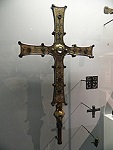
In 1123 the Cross of Cong (Gael. "An Bacall Bui" = the yellow baculum) ornamental cusped processional cross is made for Irish high king Tairrdelbach Ua Conchobair of Connacht, ending up in Cong Abbey in Cong, County Mayo.

In 1139 Irish archbishop of Armagh (1132-8) (St.) Malachy (1094-1148) journeys to Rome via Scotland, England, and France, where he visits St. Bernard of Clairvaux, and beccomes papal legate for Ireland before returning, writing St. Malachy's Prophecy of the Succession of the Popes, which becomes near and dear to Millennium Feverists, predicting all 110 future popes through Pope Paul II, and naming only two more, the last to be called Peter the Roman, who will preside over the end of the Church and the coming of Christ.
In 1151 the Battle of Moin Mhor (Móin Mhór) in Ireland sees Leinster king (since 1126) Dermot (Dermod) (Diarmaid) (Diarmait) (Gael. "without envy") MacMurrough (MacMorrogh) (MacMorrow) (Mac Murchada) (1110-71) and Connacht king (since 1106) and high king (since 1120) Tairrdelbach (Toirdhealbhach) Ua Conchobhair (Turlough Mór O'Connor) (O'Conor) (1088-1156) defeat Munster king Toirrdelbach Ua Briain, with 3K-7K O'Briain soldiers KIA, causing Toirrdelbach to flee Munster, after which the defeat of the O'Briain clain leaves a power vacuum in Munster.
In 1152 the Synod of Kells (Kells-Mellifont) (successor to the 1111 Synod of Rath Breasail) ditches the system of hereditary lay abbots and establishes the diocesan system in Ireland, recognizes the primacy of Armagh and the archbishoprics of Cashel, Tuam, and Dublin, and begins tithing; Dublin changes from a diocese subject to Canterbury to a metropolitan archbishopric.
In 1155 a cattle plague strikes Ireland.
In 1155 English king Henry II abolishes fiscal earldoms and restores royal demesne; his choice of Becket as chancellor works out so well that Henry II feels free to go to the continent; having had the idea of conquering Ireland from the time of his accession, Henry II suggests an Irish expedition to the great council, but shelves the project for other business, then sends Norman brain man John of Salisbury to Pope Adrian IV to ask for lordship of Ireland.
In 1156 the Mac Alexander revolt in Scotland (begun 1153) ends with the capture of Donald Mac Malcolm, who is imprisoned with his daddy Malcolm at Roxburgh; Somerled heads to the Scottish isles with his son, and, although he is part Norse claims to descend from Irish Gaelic kings in the Hebrides dating back to the 7th cent., sees his chance and decides to take Argyll and the Hebrides from the new Norse king (since 1153) Godfred V, and defeats him with his 80 ships, and they agree to split the Manx kingdom, with Godfred getting the part N of Ardnamurchan and Somerled getting the S part; Godfred rules over Dublin for a short time also.

In 1156 high king (since 1120) Turlough Mor O'Connor (b. 1088) dies, and his son Rory O'Connor (Ruaidri mac Tairrdelbach Ua Conchobair) (1116-98) becomes Ard Ri (high king) of Connacht in W Ireland, followed in 1166 by Ireland's last high king before the Norman invasion.

Want to conquer a neighbor in the Middle Ages? Try pope in a pocket? In 1156 Norman philosopher-historian (pupil of Peter Abelard) John of Salisbury (1115-80) obtains from Pope Adrian IV the bull Laudabiliter ("It is praiseworthy"), AKA the Donation of Ireland, bestowing Ireland on English king (since 1154) Henry II of England (1133-89), along with a ring as the symbol of his investiture.
In winter 1156/7 a great frost strikes Ireland, freezing the lakes.
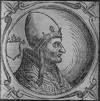

On Sept. 1, 1159 after giving a speech threatening HRE Frederick I with excommunication, Pope (since Dec. 4, 1154) Adrian IV takes a drink in a fountain, and a fly entered his mouth and stuck in his throat, choking him to death, and on Sept. 7 Laurentius (Orlando) (Roland) Bandinelli of Siena is elected Pope #169 Alexander III (1100-81) (until Aug. 30, 1181) (one of the ablest popes) by all but 4-5 of the 22 cardinals, but on Sept. 7 Frederick I's cardinals (the rest) chooses Octavian (Octavianus) as Antipope Victor IV (1095-1164) (until Apr. 20, 1164); Alexander III is friendly with the Jews and employs one to manage his finances; when he goes on to try to enforce the ban on clerical mistresses, but when he selects monk Clernbald for archbishop of Canterbury he finds he has had 17 illegitimate kids in one village alone?; meanwhile Alexander III offers Rory (Roderick) (Gael. "high longing") O'Connor (Ruaidri Ua Conchobair) (1116-98) the kingship of Ireland if he will give up all but one of his six wives, and he says forget it?
In 1161 King Dermot MacMurrough's brother-in-law (St.) Lawrence O'Tool (Lorcan Ua Tuathail) (1128-80) is unanimously elected archbishop of Dublin, becoming the most trusted man in Ireland by all side; Rory O'Connor joins forces with king (since 1124) Tiernan O'Rourke (Tighearnán Mór Ua Ruairc) (Tigernán Mór Ua Ruairc) (-1172) of Breifne (Brefney) in a conspiracy to dethrone Dermot MacMurrough.


In 1166 Rory (Roderick) (Gael. "high longing") O'Connor (Ruaidri Ua Conchobair) (1116-98) becomes the last Ard Ri (high king) of Ireland (until Dec. 2, 1198), which still suffers from the 1014 Irish clan feud; meanwhile Leinster king (since 1126) Dermot (Dermod) (Diarmaid) (Diarmait) (Gael. "without envy") MacMurrough (MacMorrogh) (MacMorrow) (Mac Murchada) (1110-71) is forced to flee Ireland after abducting a neighbor's wife, Dervogilla, from Brefney (Breifne) king (since 1124) Ternan (Tiernan) O'Rourke (Tigernan Ua Ruairc) (-1172) (modern-day County Leitrim), launching the Brefney Curse, that their shades must wander Ireland forever together until one Irishman forgives them; in the meantime MacMurrough is defeated and banished by O'Connor, causing him to seek the protection of Henry II - big mistake, since it invites the stankin' English into the Emerald Isle?

In 1167 the Normans of the Welsh marches are recruited by Richard FitzGilbert "Strongbow" de Clare, 2nd Earl of Pembroke (1130-76) allegedly to help Dermot MacMurrough return and win back some of his ancestral lands, and after claiming to be invited, the stankin' Norman English plan on invading the Emerald Isle of Ireland and never leaving - causing it turn 40 shades of green?
In 1168 the Cathedral of St. Mary in Limerick, Ireland is built (rebuilt in 1490).
In May 1169 the first contingent of English under Robert fitz Stephen and Maurice de Prendergast lands in Bannow Bay, Ireland, meeting paltry resistance, beginning the Norman Invasion of Ireland (ends 1175).
In 1169 a window tax is introduced in England, Wales, and Ireland, with the first 2 windows exempt; to lower their taxes housholders begin blocking windows, leading to the saying "daylight robbery"; it is abolished in 1851.




You are everything, and everything is you? Look me in the eye, boy, you are quarterback of this team until I tell you different? In Apr. 1170 William I of Scotland visits Henry II's court at Windsor, then visits his estates in Huntingdon, then on June 14 attends the coronation at Westminster of Henry II's eldest son Henry the Young King (1155-83) as official English successor, giving him personal homage on June 15; the attempt of the archbishop of York (backed by Henry II) to do the anointing causes archbishop of Canterbury Thomas Becket (b. 1118) to get pissed-off and obtain the support of Pope Alexander III and Louis VII in a showdown, causing Henry II to exile Becket, but Henry II repents and backs down, and formally reconciles, and Becket returns to Canterbury on Dec. 25 and excommunicates three pro-Henry bishops, who flee to Henry II in Normandy, causing him to go into a rage, crying "Will no one rid me of this troublesome priest?" (probably not, but he should have?) and/or "What! Shall a man who has eaten my bread... insult the king and all the kingdom, and not one of the lazy servants whom I nourish at my table does me right for such an affront?", causing four of Henry's Norman baron knights, Hugh de Morville (1155-1204) (Fr. "dead village"), William II de Tracy (-1189) (Gael. "fierce, warlike"), Reginald Fitzurse (1145-73) (Gael. "son of the bear"), and Richard le Bret(on) (de Brito) (Fr. "the brute") to take him literally, swear an oath to kill him, and cross over to England to find him, apparently without the ing's knowledge; on the way to Canterbury they stop at Bletchingley Castle to see Earl Roger the Good de Clare (1115-73), grandson of Earl Gilbert de Clare (-1117) (an expert on hunting accidents?); on Dec. 29 (5 p.m.) they find Becket in Canterbury Cathedral at Vespers, demand that he lift the excommunications, and when he refuses they begin arguing with him and try to arrest him, and when the 6'2" dude (compared to an avg. height of 5' back then) resists, they murder him on the altar, with Fitz Urse drawing first blood, knocking off the crown of his head and spilling his blood and brains all over the floor (in the shape of a rose and lily?), after which they all close in and finish him off, then stir the brains with a sword to be sure he's dead before leaving; too bad, the locals immediately steal samples of his blood in cloths and vials, then announce miraculous cures within days, turning him into a martyr, causing anger against the king and assassins to spread throughout Europe, all to the chagrin of kingy back in Normandy, who is called the new Nero and Judas, holing-up in his chamber for three days sans food while sending emissaries to the pope to declare his innocence and promising to perform penance; Pope Alexander III uses the opportunity to save Louis VII from Henry II's wrath; Becket is hastily entombed in a crypt without bathing (since he's bathed in martyr's blood), and the cathedral soon becomes a center of pilgrimage for England's new martyr of church-state relations, with 2M+ words written about his miracles; the word "canter" comes into use from the easy Canterbury gallop which medieval pilgrims use to ride to the town; Becket is discovered to be wearing an itchy-scratchy goat-hair shirt beneath his sacerdotal robes along with breeches of the same that "swarmed with vermin", cinching his martyr status; the four bad barons do lifetime penance by becoming Crusaders in the Holy Land.
On May 1, 1170 at the invitation of Dermot MacMurrough a party of 10 Norman soldiers and 70 archers led by Raymond le Gros land at the promontory fort in Baginbun, Wexford, Ireland S of Fethard-on-Sea on the Hook Head Peninsula, soon joined by Hervey de Montmorency and building a vast rampart that survives to modern times; finding the backward Irish still fighting with slings and stones, they repel a force of 3K Norsemen and Irish from Waterford; on Aug. 23 Strongbow lands with an army of 1.2K, combining forces and taking Waterford on Aug. 25; the same day Strongbow marries Dermot MacMurrough's daughter (by his 2nd wife Mor O'Toole) Aoife (Eva) MacMurrough of Leinster (1145-88) in the ruins of Waterford.
In 1170 sick of Henry II's infidelity, Eleanor moves to Poitiers, France; Henry II assigns Brittany to his son Geoffrey to hold of his brother Henry the Young King (b. 1155), assigns Normandy, Anjou, and Aquitaine to his son Richard Lionheart to hold directly of the French king, and assigns no lands to his youngest son John, causing him to be called "Lackland", even though daddy later conquers Ireland for him; the premature taste, combined with daddy's bad rep over what he did to Becket backfires and causes his sons to become rebellious, becoming known as the "lion's brood".
In May 1171 Ireland's deposed king Dermot MacMurrough dies, and Strongbow claims the throne of Leinster by marriage to his daughter Aoife (Lorcan's niece), conquering a strip of territory from Dublin to Cork and threatening the establishment of an independent Norman kingdom in Ireland; on Oct. 17 Henry II, with papal sanction lands in Waterford to assert his supremacy, and Strongbow submits without a fight, swearing loyalty to Henry II, who on Nov. 11 holds his court in Dublin, making it a dependency of the English city of Bristol next year; the Normans spread over Ireland except for W and C Ulster, intermarrying with the Irish and adopting their ways, language, and culture while retaining only nominal allegiance to Henry II; the English-ruled Pale in Ireland (Land of Ire) is established, where strong Norman barons (the Fitzmaurices, Carews, Gerards, Davids, and Barries) outvote weak English justiciars (with no English garrisons) (under an English viceroy with orders from Henry II to be fair to the natives, pissing-off the Normans?) to gangbang the Irish for fun and profit without establishing any organized govt.; by the end of the 15th cent. it is reduced to an area on the E coast from Dalkey (S of Dublin) to Dundalk (N of Drogheda), with the W boundary from Leixlip N to Kells.

What's new, pussycat, whoa-whoa-whoa? On Feb. 2, 1172 now that they have their martyr of the millennium,the Second Synod of Cashel (first in 1101), convened by Henry II (who is not present) is held under English occupation, and the Irish acknowledge Henry's sovereignty, and agree that their church needs reformation, with Irish prelates inundating the pope with letters recommending Henry II in hopes of protection against Strongbow; (St.) Laurence O'Toole (1128-80) is made papal rep. to Ireland; meanwhile Richard Lionheart is created duke of Aquitaine.
In Mar. 1172 Anglo-Norman landowner Hugh de Lacy, 4th Baron Lacy (1134-1186) is granted control of Meath and Dubin Castle, becoming the first Norman viceroy of Ireland (again in 1179 and 1180); the prior lord of Meath, Breifne king Tigherman O Ruairc gets pissed-off, and meets Lacy on the Hill of War in Meath, where he is ambushed and decapitated, his head hung over the gate of Dublin Castle and later sent to Henry II.
In 1173 the Aquitaine Revolt of 1173-4 sees Henry II's Angevin Empire slide into civil war as his estranged wife Eleanor of Aquitaine (pissed-off at his adulteries) supports her sons Richard Lionheart and Henry the Young King and ally with Louis VII against him, fleeing to his court; William I of Scotland throws in with the rebels in exchange for a promise of the restoration of guess what Northumberland (after he inherited the title of Earl of Northumbria in 1152 and was forced to give it to Henry II in 1157), but is captured by a small English forces of mounted knights led by Henry II's chief justiciar (1154-89) Ranulf de Glanvil (Glanville) (Granvile) (-1190) at the Battle of Alnwick in Northumberland on July 13; Henry II takes control of Kenilworth Castle in the Arden Forest in Warwickshire to defend against the rebellious barons on both sides of the Channel; Louis VII attacks Normandy while William I invades England, but the support of the middle classes saves Henry II's cause; after becoming the first female Euro monarch to lead troops into battle, Eleanor is imprisoned (until 1183); on Aug. 10 in Rouen Henry II names Strongbow as royal justiciar of Ireland.
In 1174 Henry II of England visits Ireland uninvited and records the use of whiskey (aquae vitae).
In Oct. 1175 Rory O'Connor of Ireland signs the Treaty of Windsor, recognizing Henry II as the Irish overlord, although he remains nominal high king of Ireland and king of Connacht outside Leinster, Meath, and Waterford, but all the Irish kings have to pay tribute to Henry II through O'Connor, and force Irishmen fleeing the conquered areas to return; haughty Normans begin to move into Ireland and lord it over the local "dogs"?
On Apr. 20, 1176 Strongbow (b. 1130) dies in Dublin of an infection, leaving only infant daughter Isabel de Clare, 4th Countess of Pembroke and Striguil (1172-1220) as heir, causing Henry II to seize Leinster and place it in charge of a royal official.
In Jan. 1177 Anglo-Norman knight Sir John de Courcy (Courci) (1150-1219) invades Ulster (Ulaid), Ireland with 22 knights and 200 foot soldiers, defeating its last king Ruaidhrí Mac Duinnshléibhein in June, going on to build strongholds at Dundrum Castle in County Down and Carrickfergus Castle in County Antrum plus Benedictine and Cistercian abbeys, becoming known as its William the Conqueror.
In May 1177 after the Normans defeat the Ulaid of Ulster, Henry II holds a royal council in Oxford, dividing Leinster into three admin. areas, and with the approval of papal legate Cardinal Vivian, Henry II's 10-y.-o. youngest son Evil Prince John Lackland is made the first Lord of Ireland (ends 1542), requiring the principal Anglo-Norman landholders in Ireland to swear fealty to him; too bad, as a haughty Norman he soon begins treating the natives like serfs, giving large chunks of land to his friends, incl. Tipperary to his butler; a Norman earldom is established in Ulster (until 1333); he doesn't come to live in his new domain until 1185, and soon is recalled, leaving a group of haughty Normans behind to sow the seeds of centuries of ire?; the eternal battleground city of Belfast (modern-day pop. 340K/483K) on Belfast Lough, an inlet of the North Channel at the mouth of the Lagan River with a fine harbor is founded with a castle built to defend a ford over the river; 800+ years of direct English rule of Ireland begins.
In 1177 after helping lead the Norman invasion of Ireland, Anglo-Norman knight Miles de Cogan (-1182) and Cambro (Welch)-Norman knight Robert FitzStephen (-1183) are jointly granted the kingdom of Cork "from Lismore to the sea", excluding the city of Cork, going on to make raids in Connaught.
In 1178 the first English invasion of Connaught, Ireland is repulsed, with the town of Galway (Gael. "Dun Gaillimhe" = fort at the mouth of the Gallimhe) (founded in 1124 by Connacht king Tairrdelbach Ua Conchobair) on the Corrib River in Galway Bay (modern-day pop. 80K) becoming an anti-English citadel for cents., nicknamed "the city of the tribes" for its 14 merchant families.
In 1183 Rory O'Connor retires to an abbey; meanwhile Henry II petitions the pope to crown his son John king of Ireland, which proves unpopular with the Irish.

On Apr. 25, 1185 Henry II's son John Lackland, lord of Ireland goes on his first expedition to Ireland to finish the English conquest and organize the govt. (so he finally has some land?), but the haughty conduct of his council in Waterford incl. laughing at the big beards of Irish chieftains causes disturbances, and in Dec. he is recalled after failing to establish either task, making him even meaner; Welsh-born royal clerk Gerald of Wales (Giraldus Cambrensis) (1146-1223) accompanies Henry to Ireland and stays two years, going on to pub. Topographia Hibernica in 1188, which becomes the longest and most influential work on Ireland during the Middle Ages; too bad, it's highly xenophobic, portraying the Irish natives as barbaric savages; he also pub. Expugnatio Hibernica, an account of Henry II's conquest of Ireland.
On July 25, 1186 Hugh de Lacy, Lord of Meath (b. 1134) is assassinated, and after rejoicing that he doesn't have to send his half-wit son back for another try, Henry II has Meath put under administrators while rushing to close his grasp by arranging the marriage of Strongbow's daughter-heir Isabel de Clare, 4th Countess of Pembroke and Striguil (1172-1220) in Aug. 1189 to William Marshal, 1st Earl of Pembroke (1146-1219), who succeeds to the lordship of Leinster (Henry II's last executive decision), turning the Marshal from a a landless knight into one of the richest men in England.
In 1196 Anglo-Norman knight John de Courcy (1150-1219) defeats the king of the Cenel Connail, leaving Donegal at his mercy; in 1198 he returns, devastating Inishowen; too bad, in subsequent campaigns he is defeated by the O'Neill clan under their chief Aed (Aodh) Meith (Méith) (-1230), and finds himself unable to conquer W Ulster.
In the early 13th cent. the English strategy in Ireland changes from invasion to colonization, with immigrants coming from England, Wales, France, and Flanders, all being considered higher than the native Irish "betaghs" (serfs).
In the 13th cent. prof. bards begin working in Ireland.
In the 13th cent. Pedigree of the Saints (Achau'r Saint), The Book of Anerin, The Black Book of Caermarthen (Canu Myrddin), Vita Santorum Wallensium, De Situ Brecheniauc, Life of Carannog, Life of Cuby (Cybi), Life of Illtyd, and The Dream of Rhonabwy are written in busy little Ireland.
About 1200 the town of Tipperary (Gael. "Tiobraid Arann" = Well of the Ara) on the Ara River in Munster, S Ireland (AKA Tipp Town) (modern-day pop. 4.9K) is founded, becoming the home of the Clanwilliam barony and seat of County Tipperary.
In 1200 King John of England orders the construction of King John's Castle on the S bank of the Shannon River in Limerick, Ireland (finished 1210).
On Mar. 30, 1209 (Easter Mon.) Black Mon. sees 500 English settlers from Bristol massacred in Dublin, Ireland by the O'Byrne Clan near Ranelagh Wood, starting a trend (1351, 1360).
Loose brown lips sink ships? In 1210 after once up-and-coming William de Braose, 3rd baron Abergavenny and his wife Maude de St. Valery shoot off their mouths and tattle that John I killed his nephew Arthur, John sends a force which invades Wales and lacklands their domains, claiming unpaid fees; he then goes on a second expedition to Ireland (first 1185) to capture his pesky son William de Braose, 4th Baron Abergavenny (1175-1210), husband of Mathilde (Maude) de Clare (1180-1213) (daughter of Richard de Clare, 3rd earl of Hertford), after which he starves them to death in Windsor and/or Corfe Castle; 20 Irish kings do homage to King John, and he expands his king's council in Ireland, forming the basis of the Irish parliament; too bad, John's cruelty backfires, scaring the other barons into fomenting a revolt, becoming his greatest mistake; he does let Little Brownose's sons John, Giles, Philip and Walter live, and they are released from prison in 1218 to carry on the Brownose, er, Braose name.
In 1210 Blarney Castle 5 mi. from Cork, Ireland is built on the site of a timber house by the MacCarthy clan of Muskerry, becoming the site of the famous Blarney Stone in 1446.
On Oct. 2, 1213 King John signs a royal charter with papal legate Pandulf at St. Paul's Cathedral in London, pledging to return all confiscated Church property and submit his crown and his kingdom in England and Ireland to Pope Innocent III as a fief of the Holy See, and swear an oath of fealty, ruling as the pope's vassal and promising to accept the pope's buddy Stephen Chapter-and-Verse Langton as archbishop of Canterbury, and pay damages to the clergy, plus a tribute to the pope of 1K marks a year; after John surrenders his kingdom to the pope, he receives it back after five days as a papal fief subject to perpetual tribute and fealty; in 1216 the pope sends Guala (Gualo) Bicchieri (1150-1227) as his legate to England (until 1218) to work John's leash, creating an "inglorious league" (Shakespeare, King John, 5.1.65) that pisses-off the nobles and sticks in the English craw for cents.; "This England never did, nor never shall,/ Lie at the proud foot of a conqueror" (Sir Richard in King John, 5.7.112-3) - this is as good as it gets for papal power over European kings, but too bad he couldn't keep his former diaper stuffer Frederick II in line?
Don't slice off me balls, where do I sign? Nyaa, I renege? In Jan. 1215 English king John I is presented with the Articles of the Barons, demands by his northern barons (allied with Llywelyn the Great of Wales), who are pissed-off by the tyrant's long series of abuses in the admin. of justice, as well as his new attempts to tax them to pay a large ransom for his truce with France, demanding that he issue a charter modeled on Henry I's charter guaranteeing them their political and personal rights; he asks for a delay until Easter to answer while attempting to round up support against them, and on May 17 after assembling in Stamford and capturing Shrewbury without resistance, an army led by rebel baron Robert Fitzwalter (-1235) takes London, causing him to seek a truce on May 27; on June 15 the two parties meet in Runnymede Meadow on the Thames River 20 mi. SW of London in Surrey (Egham Parish) near Windsor (an open area where both armies can guard against ambush by facing each other across the field?), and under considerable duress (at swordpoint in a tent?) (a dagger under his balls under the table?) (his chamberlain Hubert de Burgh urges him to do it?) King John signs the Magna Carta (Charta) AKA the Great Charter, authored by Stephen Langton, who puts the first witness signature on it along with 25 barons and earls known as the Magna Charta Sureties, guaranteeing the freedom, rights, and liberties of the Church of England (Article 1), providing that only a gen. council of the kingdom can impose scrotum, er, scutage (Article 12), guaranteeing the freedom of the city of London and its merchants (Article 40), and granting to the aristocracy the right to habeas corpus (Article 36), and the right to lawful judgment of their peers (not necessarily trial by jury) (Article 39), and protection against arbitrary acts of the king incl. taxes by a House of Lords (archbishops, bishops, abbots, earls, and "greater barons of the realm") (the precursor to "no taxation without representation") (Article 14); widows can't be forced to remarry; standard measures will be used for wine, ale, cloth, and corn; towns can't be forced to build bridges; royal officials can't steal wood, horses, or carts; no murder arrest can be made if a woman brings charges unless the victim is her husband; Article 39 provides for due process of law; Article 60 says that "All the aforesaid customs and liberties... all people of our kingdom, as well clergy as laity, shall observe, as far as they are concerned, towards their dependents"; King John acknowledges that Welsh Wales is still under Welsh law; recalcitrant barons break the charter's terms even before it is signed, harrying the king's lands and men, and within 2 mo. John sends abroad for mercenaries to fight them, while kibbitzing Pope Innocent III, who gets pissed-off by lack of recognition of his powers and issues a bull on Apr. 21 backing John, which doesn't stop the barons, who renounce their feudal ties to John in May and March on London, Lincoln, and Exeter, spurring a wave of royalist defectors, starting the First Barons' War (1215-17), leading King John to appeal to the pope to excommunicate the rebel barons, which he does, along with the citizens of London and the Cinque Ports; after Stephen Langton refuses to pub. the ban he is suspended by the papal legates, who help King John raise money for mercenaries from Flanders and France, while the rebel barons, lacking public support outside London invite Prince Louis the Lion, son of Philip II Augustus to invade England and become their king (big mistake?); the papal legates forbid Prince Louis and his followers from crossing the Channel, and excommunicate them when they try it, along with 17-y.-o. Alexander II of Scotland, who in Oct. leads an army over the Tweed River and takes the homage of the barons of Northumbria, something his daddy William I Lion couldn't do in 50 years; King John appoints his chamberlain Hubert de Burgh (1165-1243) as chief justiciar of England (until 1232), going on to personally lead the fight against the invading French army; in Nov. King John seizes the castle of ringleader Richard de Clare, 3rd Earl of Hertford (1153-1217) in Tonbridge and grants his lands to Robert de Bohun; meanwhile the Scots take Carlisle; Rochester Castle is captured by the baronial forces from Stephen Langton, causing the king to siege it for seven weeks until the garrison surrenders from hunger, after which the French recapture it; Millennium Feverists see it all as a sign that the Kingdom of Christ on Earth is drawing nigh?; the Melrose Chronicle is written by Scottish borders monks, becoming the first independent account of the Magna Charta, containing the soundbyte: "A new state of things begun in England; such a strange affair as had never been heard; for the body wishes to rule the head, and the people desired to be masters over the king"; in 1984 U.S. millionaire H. Ross Perot buys one of the 17 surviving copies of the Magna Charta for $1.5M - does that make him English nobility?
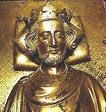

In Aug. 1216 while Alexander II of Scotland meets with Fresh Prince Louis in Dover, becoming the farthest S any Scottish king has ever penetrated, King John moves to attack Alexander's rear, causing him to hurry back to Scotland; on Oct. 12 (Thurs.) bad king (since May 27, 1199) John Lackland (b. 1167) loses his royal baggage and treasure incl. his crown jewels (the scutage tax that caused the revolt) in the fens of the Wash in Norfolk in Lincolnshire, perhaps driving him mad (have you ever lost your baggage in the Fens of Norfuck?); on Oct. 18/19 (Wed./Thurs.) he dies of dysentery at Newark Castle in Swineshead in Nottinghamshire (Lincolnshire?) after eating at an abbey (according to William Shakespeare, he was poisoned by a monk named Brother Simon with a Death Cap (Amanita Phalloides) Mushroom, who tastes some of it first to prove it isn't poisoned, and dies with him) (a plot by the pope?) (or was it someone he ate?), and the English rapidly reunite around his 9-y.-o. son Henry III (1207-72), who is declared too young to have any responsibility for his father's crimes, and is crowned on Oct. 28 by a papal legate in Gloucester (the 28th English monarch) (until Nov. 16, 1272) (first crowned during his minority); he is controlled by regent William Marshal, 1st Earl of Pembroke (1146-1219) (top jousting champ, who lives in Pembroke, Wales, where he gets plenty of practice?), who designates the pope as his guardian; Peter des Roches (-1238), bishop of Winchester becomes his tutor; he grows into an artist-king who rebuilds Westminster Abbey; the rebel barons are ordered by Pope Honorius III to return to their natural allegiance under the threat of excommunication; the spat over the Magna Charta is dropped until Henry III grows up after William Marshal reissues it minus a few clauses (esp. the ones authorizing the barons to use force against the king, and those backing Alexander's grievances), and extends amnesty; later monks hear sounds from King John's grave, causing them to dig up his body as a suspected werewolf and move it from consecrated ground?; "Thus the ill presage of his surname Lackland was completely realized, for he lost in his lifetime almost all the domains under his suzerainty, and even after his death he could not keep peaceful possession of his tomb" (Norman Chronicle); Gilbert de Clare, 4th Earl of Hertford, 5th Earl of Gloucester, 7th Lord of Clare, 1st Lord of Glamorgan (1180-1230), son of rebel baron Richard de Clare, 3rd Earl of Hertford (1153-1217) is captured in Lincoln by William Marshall, and in 1217 after kissing and making up marries his daughter (by his wife Isabel Fitzgilbert de Clare, daughter of Richard "Strongbow" de Clare - you figure it out?) Isabel Marshall (1206-40), later becoming close friends with Henry III even though their daddies were enemies, and getting a new title of earl of Gloucester; meanwhile John I's sister Eleanor Plantagenet "the Fair Maid of Brittany" (1184-1241), who was captured along with her younger brother Arthur I at the Battle of Mirabeau and imprisoned with him is passed over like a bag of manure, and kept imprisoned in Corfe Castle in Dorset for life; King John's wife (since 1200) Isabella of Angouleme returns to France and marries her old beau Hugh X of Lusignan, count of La Marche; under Henry III Norman power in the British Isles rapidly expands, and the Irish are screwed bigtime, with native Irish turned into serfs who cannot make a will or sue an English defendant, and whose murder is not considered a felony by the courts, while Irish are denied access to higher ecclesiastical offices; meanwhile on Nov. 12 Henry III of England issues the Great Charter of Ireland, a version of the English Magna Charta securing rights for Anglo-Norman magnates in Ireland.
In 1217 the govt. of England issues an order prohibiting Irishmen from holding episcopal offices or serving as cathedral deans, and creating John St. John (-1302) as the first lord high treasurer of Ireland (high treasurer until 1695) (ends 1817).
In 1224 Irish king of Connacht (since 1202) Cathal Crobhdearg Ua Conchobair (Cathal the Red-handed O'Conor) (O'Connor) (b. 1153) dies after writing to Lord of Ireland Henry II requesting his son Aedh (Od) be his successor, and in 1226 the Irish kingdom of Connacht is declared forfeit by the English govt., causing a 9-year war, starting next year with an invasion by Domnall Og O Neill of Tir Eogain, who declares himself king and causes several of his chieftains (Siol Muiredaig) to defect, causing Cathal to appeal to a council of English chiefs in Ireland successfully, who back him in a brutal war that devastates Connacht, with major battles in Turlough, County Mayo and Meelick in County Galway, and the plundering of Coolcarney, which results in fishing baskets full of drowned children; after peace is restored, his chiefs are held for ransom by the English, and when they finaly leave, the sons of Ruaidri O'Connor revolt, resulting in 1225 in the Sack of Ardrahan, in which Niall, son of Farrell O'Teige is KIA; in 1228 Connacht king Aedh is KIA, and his cousin Aedh mac Ruaidri Ó Conchobair (-1233) becomes king of Connacht (until 1233); in 1226 Cathal's chief bodyguard Fearghal Ó Taidg an Teaghlaigh (-1226) is KIA by Donslevy O'Gara in County Sligo; in 1232 a truce is declared, after which "This was a necessary tranquility, for there was not a church or territory in Connaught at that time that had not been plundered and desolated. An oppressive malady raged in the province of Connaught at this time: it was a heavy burning sickness, which left the large towns desolate, without a single survivor"; too bad, the English allied with the French see their chance and invade, conquering Connacht by 1235.
In 1226 Aed mac Donn Ó Sochlachain (b. ?) dies, becoming one of the first known Irish musicians, known for chanting and harp-playing.
In 1235 Alan, ruler of Galloway, who had been used by Alexander II of Scotland to build a kingdom in the Scottish Isles for his bastard son to check the Ui Neill of W Ulster (who had backed his enemies the Mac Williams clan) dies, and Alexander crushes the son then partitions the area between Alan's daughters after marrying them to loyal Anglo-Scottish barons; he then deposes the native heads of the local Cistercian houses in favor of monks from his favorite monastery of Melrose.
In 1236 an Irish chancery is established separate from the English chancery; it is abolished in 1877.
In 1242 the first English arrive in Drunholm, Ireland and settle with the O'Connors from Munster to help them fight the chieftains of Donegal.
In 1244 a water tax is imposed in Dublin, Ireland by gov. Maurice Fitzgerald.
In 1245 Maurice Fitzgerald, lord chief justice of Ireland builds Sligo (Gael. "Sligeach" = abounding in shells) Castle on the coast in Connacht, NW Ireland, which grows into the city of Sligo (modern-day pop. 20K), becoming the only Norman-founded Irish town under almost continuous control in the Medieval period.
On Aug. 15, 1249 the First Battle of Athenry (Ath na Riogh) (2nd in 1316) sees an army of Gaels from Connacht attack the new (1241) Norman urban walled settlement of Athenry in hostile territory, only to be repelled by the Normans under Connacht sheriff Jordan de Exeter (d'Exeter).
About 1250 the O'Neill clan in N Ireland begins a major rebellion against the stankin' English, which spreads to Munster, burning English colonists' homes and ransacking their lands until it fizzles by 1261, leaving most of Ireland except the N, midlands, and parts of the W coast ruled by Anglo-French lords.
On Nov. 1, 1254 after Henry III worries about a Castilian invasion of Gascony, he marries his 15-y.-o. son Edward I (1239-1307) to 13-y.-o. Eleanor of Castile (1241-90), half-sister of Alfonso X of Castile; Edward I receives lands worth 15K marks/year, incl. land in England (earldom of Chester), Wales, and Ireland, becoming lord of Ireland, going on to use the country to provision his campaigns against the Welsh, French, and Scots; his son Edward II continues the practice.
In 1255 Brian mac Neill Ruaidh Ua Neill (-1260), king of Tir Eoghain raids the lands of English colonists across the Bann River into Ulaid, destroying towns and castles; in 1256 Connacht king Aodh O'Connor conquers the neighboring kingdom of Breifne with Brian's help; in 1257 Tadhg O'Brien, king of Thomond defeats the colonists and plunders their lands; in 1258 Brian, Aod, and Tadhg form an alliance, meeting near a ruined Geraldine castle in Belleek, County Fermnagh on the Erne River, where Brian is confirmed as high king of Ireland, and Aodh as overlord of Breifna; too bad, Tadhg dies in 1259; on May 14, 1260 the Battle of Druim Dearg (Down) near Downpatrick, modern-day County Down, Ulster, North Ireland sees Brian KIA along with several Ui Cathain chiefs incl. Aedh Ua Conchobhair by a mercenary army of Irish Gaelic soldiers working for the Normans, ending the O'Neill revolt.
About 1261 Roger Owen (-1280) is appointed as the first King's Serjeant-at-law at the Irish Bar.

The last Norse invasion of Scotland? On July 11, 1263 the 120-ship Norwegian leidang (lething) fleet sails W to attack Scotland over control of the Hebrides, and enters the Firth of Clyde in Sept. after doing a little plundering along the way; part of the fleet is then sent to Loch Lomond to plunder Lennox and Menteith, while the main body anchors off Little Cumbrae Island and Largs; too bad, on Sept. 30 a storm wrecks four Norwegian ships, and when Haakon IV himself lands with a small force to salvage the wrecks on Oct. 2, Alexander III's testy Scots arrive, led by Alexander Stewart of Bute and Cowal, 4th High Steward of Scotland (1214-83) fight the Battle of Largs around the mouth of the Gogo Water, forcing the Norsemen back into their ships with small losses, retreating to Orkney on Oct. 29, where they over-winter, after which a delegation of Irish kings invites Haakon to help them rid Ireland of the stankin' English settlers as their new high king, which he declines; on Dec. 16 Haakon IV (b. 1204) dies at the bishop's palace in Kirkwall, and his son Magnus VI (the Law-Mender) (Lagabote) (1238-80) becomes king of Norway (until May 9, 1280), while the Scots push their advantage to force him to give up the Hebrides, and within three years all Viking lands are returned to Alexander, although many Viking families continue to live there, mixing with Scottish clan families moving in.
On June 18, 1264 the earliest known Irish parliament is held at Kilkea Castle near Castledermont, County Kildare, attended only by prelates and magnates.
In 1277 Henry II creates a royal seal for England, along with the first salaried barons of the exchequer.
In 1290 the Court of King's (Queen's) Bench is established in Dublin, Ireland, becoming one of the Four Courts.
In Dec. 1295 Cambro-Norman judge Sir John Wogan (de Wogan), Lord of Picton (-1321) becomes Norman justiciar of Ireland based in Dublin (until 1313), immediately arranging a short truce in the Burke-Geraldine feud, suppressing the Knights Templars based in Kilmainham in Feb. 1308 under orders of Edward II, and holding three Parliaments in Kilkenny (1297, 1307, 1310); in 1307 it decrees that Irish cannot join Anglo-Irish religious houses; in 1310 the first elected representatives of cities and boroughs are summoned, as well as lay and spiritual peers and elected knights of the shire representing the counties and Liberties; no Irish are allowed until 1541.
In 1295 Edward I's 24th Statute of 1295 forbids the "degenerate English in Ireland" from imitating the native Irish "by allowing their hair to grow in coolins" (curls).
In 1297 the first representative Irish Parliament of the Lordship of Ireland meets in Dublin; in 1537 it is expanded to two chambers; it is abolished in 1800.
In 1300 Jofroi of Waterford writes Catalogue of All Known Wines and Ales of Europe; Paris-based Dominicans recommend his favorites to colleagues.
In 1303 the Armagh succession passes from mainly Gaelic Irish to a series of Anglo-Irish prelates, and after Dionysius is never consecrated and resigns, on Aug. 27, 1306 John Taaffe (-1307) is appointed, followed by Walter Joyce (Jorz) (1307-11), Roland Jorz (1311-22), Stephen Seagrave (1323-33), and David Mageraghty (Mag Oireachtaigh) (1334-46).In spring 1315 bad weather caused by volcanic activity in SE Asia and New Zealand leads to the Great Famine of 1315-17 (1314-22?), which kills 35% of the 30M pop. in Europe in a 400K sq. mi. area from Ireland to Italy and Russia, causing cannibalism, infanticide, disease, and crime, ending the period of growth and prosperity begun in the 11th cent.; mothers are fed their children, becoming the source of the Hansel and Gretel legend?
On May 26, 1315 after being sent by his older brother Robert I the Bruce, Edward the Bruce (1275-1318) invades Ireland, hoping to take it over for the Bruce clan, sacking Granard and Dundalk, rallying many Irish lords and quickly occupying Ulster before bogging down at the English colonial capital of Dublin; meanwhile Edward Balliol, son of King John I Balliol waits in the wings, being released from England and allowed to go to his family lands in Picardy, as murmuring begins against Robert for his favoritism in the distribution of forfeited lands, making hay of the pope's excommunication and summons of Robert to be BBQed in Rome. On May 1, 1316 Edward the Bruce, Earl of Carrick, with the help of native chieftains has himself crowned Edward I (1275-1318) of Ireland; too bad, Gaelic Irish clan rivalry keeps them from uniting behind him to kick the English butts' out of Ireland - it's my island, but then, I'm crazy? On May 16, 1316 John FitzThomas, Baron of Offaly is created the 1st Earl of Kildare for his aid to Bruce during his advance into Leinster, becoming one of the three most powerful earldoms in Ireland along with the Earl of Ormonde (James Butler) in 1328 and the Earl of Desmond (Maurice FitzGerald) in 1329. On Aug. 10, 1316 the Second Battle of Athenry is a devastating V for an Anglo-Irish force under Rickard de Bermingham (Rickard Mac Fheorais) (-1322), lord of Athenry and William Liath de Burgh (-1324), deputy justiciar of Ireland over the Gaels of Connacht who allied with Edward the Bruce, losing 3K-5K KIA, with 1.5K beheaded; Irish kings Fedlim O Conchoair of Connacht and Tadhg O Cellaigh of Ui Maine are KIA and their heads mounted over the town's main gate, which becomes the Athenry coat of arms.
In Apr. 1318 the Scots under Robert I retake the port stronghold of Berwick-upon-Tweed (held since 1296) (until 1333), and in Oct. his brother Edward the Bruce (b. 1275) brucely leaves his stronghold in Ulster without him, and on Oct. 14 is KIA at the Battle of Fochart (Faughart) (in the fog?) near Dundalk by Sir John de Bermingham, his body quartered and sent to various towns in Ireland, and his heart sent to Edward II, leaving Robert I with only three illegitimate sons, one illegitimate daughter, and 2-y.-o. grandson Robert Stewart (b. 1316), son of his daughter Marjorie and Walter the Steward, causing the Scottish parliament in Nov. to pass a decree that if he dies without a son his grandson will be crowned, and attempt to hush the murmurs by passing laws correcting some of the land settlement gripes and outlawing murmuring against the king; meanwhile hand-rubbing Edward Balliol comes to the English court after receiving news of Dundalk, and begins the Soules Plot to kill Robert I using pro-Balliol Scottish insiders and place himself on the Scottish throne (ends 1320).
In 1320 the U. of Dublin in Ireland is founded in connection with St. Patrick's Cathedral, but never receives an endowment, and limps along until Henry VIII shuts it down, after which it is reestablished in 1592.
In 1322 a great cattle plague called the Mael Domnaig strikes Ireland (ends 1325).
In 1322 After leaving Clonmel, Ireland on a pilgrimage to Jerusalem, Irish Franciscan monk Symon Semeonis (Simon FitzSimmons or FitzSimon and his companion friar Hugo the Illuminator encounter a group of Romany (Romani) (Roma) (Gypsy) from NW Ondia in Heraklion, Crete, calling themi "the descendants of Cain", becoming the first known encounter; he goes on to write Itinerarium Symonis Semeonis ab Hybernia ad Terram Sanctam (The Journey of Symon Semeonis of Ireland to the Holy Land).
In 1323 John Darcy, 1st Baron Darcy de Knayth (1290-1347) is appointed lord justice of Norman Ireland (until 1344), making it a condition of his reappointment that there should be one and the same law (una et eadem lex) for the Irish and Anglo-Irish, except the betaghs (serfs), after which in 1331 it is codified in an ordinance, which the native Gaels ignore in favor of their brehon law.
In 1326 Cormac MacCarthy Mor (1271-1359) becomes king of Desmond in S Munster, Ireland (until 1359); in 1358 his 2nd son Dermod Mor MacCarthy (1310-68) is created 1st Lord of Muscry (Muskerry) along the Lee River in C County Cork, founding the MacCarthy Dynasty of Muskerry, which owns Blarney Castle.
On Apr. 11, 1328 Adam Duff O'Toole of Leinster, Ireland is burned at the stake in Hogging (Hogges) Green near Dublin for blasphemy and heresy, although it was really for rebelling against the stankin' English?
The Black Death (the original Darth Vader) rockets through Europe's Internet with breathtaking speed? In Oct. 1347 a Genoese trading fleet arrives in Messina, Sicily carrying the Black Death (Bubonic Plague), caused by Yersinia pestis bacteria carried by fleas from rats; not rats but gerbils?; it also arrives in Egypt, Syria, and Cyprus; by 1351 it kills 20M-30M in Europe (a third of Europe's pop., and up to 60% in some areas), and 75M worldwide by 1361; world. pop. decreases from 450M to 350M-375M by 1400; Europe takes 150 years to return to 1347 pop. levels; it ravages China, halving its pop. from 123M in 1200 to 65M in 1400; lucky America is not affected, but not toughened up by it either?; rats didn't really spread it, because it spreads so fast from person to person?; French Franciscan Order minister-gen. (since 1329) Gerard Odon (Geraldus or Gerardus Odonis) (Guiral Ot) (1285-1349) is asked by the pop. of Messina to retrieve the relics of St. Agatha from Catania, and when they refuse he dips them in holy water and takes instead, dying of the plague on his return trip.
In Jan. 1348 the Black Death begins in Marseille and Languedoc, spreading to Avignon in Mar., and Siena, Toulouse, Narbonne, Montpellier, and Carcassone in May; after the cemeteries are filled, bodies are piled high on the Campus Floris near the Church of St. Mary of the Miracles; in June it spreads to Spain, and Bordeaux, Lyon, Burgundy, Normandy, Paris, and SW England in Aug., along with Howth and Drogheda in Ireland; Agnolo di Tura the Fat of Siena, Italy writes the soundbyte: "The mortality in Siena began in May. It was a cruel and horrible thing. The victims died almost immediately. They died by the hundreds, both day and night. I buried my five children with my own hands, and so did many others likewise. Nobody weeps no matter what his loss because almost everyone expected death. So many died that all believed it was the end of the world"; it then disappears for the winter, except Ireland, which it decimates; the Great Plague results in horrible Jewish pogroms throughout Europe, incl. Chillon, Basle, Stuggart, Ulm, Speyer, Dresden, Strasbourg, and Mainz, destroying 60 major and 150 minor Jewish communities, causing survivors to head for Poland, which welcomes them as Kasimir III reworks the Polish law codes; in Strasbourg 2K Jews are hanged; in Freiburg ? are burned alive in wooden bldgs.; Basle burns 600 Jews, expels the rest, and destroys their synagogue and cemetery; Alfonso XI of Spain proposes that the Jews give up banking and take up agriculture; meanwhile, Millennium Fever is on full blast, and when terrible earthquakes rock Italy, this combined with the plague convince people that the end of the world is nigh.
On May 31, 1349 (Pentecost) the death rate from plague eases in London after 60% of the pop. is killed since last fall; it was really spread via coughing? In the summer the Great Plague reappears in Paris, where it peaks, killing up to 800 a day, and spreads to Picardy, Flanders, and the Low Countries; also in the summer it reappears in London, and spreads to Ireland, killing 35% of the pop. within a year; by the middle of the year half of the pop. of Venice is killed; by the end of the year half of England's pop. is killed, and a truce with France is called; the plague spreads to Norway when an English ship full of corpses floats into Bergen, and reaches Elbing (Elblag), Poland on Aug. 24; the Church and its credibility being challenged head-on, the main solution offered is by the Flagellants, who appear in force all over Europe (especially Germany), torturing themselves publicly, and proclaiming that the Second Coming is 33.5 years away (I been a bad, bad boy, so tan my sinful hide?), while causing trouble for Jews, the rich, the Church, and finally themselves (besides all the wounds), causing Pope Clement VI to pub. a bull condemning them on Oct. 20; "Many persons, and even young children were soon bidding farewell to the world, some with prayers, others with praises on their lips."
On Dec. 25, 1351 William Boy (Gael. "bui" = golden-haired) O'Kelly of Ui Maine begins the greatest feast in Irish history, inviting all the learned and entertainers of Ireland to his castle at Galey on the shores of the Lough Ree for a whole month, causing the saying "the welcome of the O'Kellys" to be coined.
In 1353 after the primacy dispute of the archbishops of Dublin and Armagh is referred to him, Pope Innocent VI rules that "Each of these prelates should be Primate; while, for the distinction of style, the Primate of Armagh should entitle himself Primate of All Ireland, but the Metropolitan of Dublin should subscribe himself Primate of Ireland."

The original Wanted Posters for Kennedy? In 1366 after the Anglo-Norman settlers in Ireland become too Irish for the English to swallow, the 36 Statutes of Kilkenny protect the racial purity of the English in Ireland, forbidding intermarriage and requiring the Irish to speak English, decreeing excommunication and heavy penalties for following the customs of or allying themselves with the native Irish, and denying the Irish access to church offices (bishoprics), banning Irish minstrels; nobody is allowed to ride a horse except "on a saddle in the English fashion", causing Irish rebels to love riding bareback; the statute is widely ignored, nativist rulers started gaining ground amid a Gaelic cultural revival, and by the time of the War of the Roses (1450) the authority of the English crown shrinks to the English Pale, a small coastal district of four counties around Dublin and the port of Drogheda incl. Dalkey, Dundalk, Naas, Leixlip, Trim, and Kells enclosed by an earthen rampart, causing the phrase "beyond the Pale" to be coined; the Kilkenny Cat allegedly will fight until only its tail is left.
On Jan. 24, 1382 Richard II's 7-y.-o. heir presumptive Roger Mortimer, 4th Earl of March (b. 1374) is made lord lt. of Ireland, with his uncle Sir Thomas Mortimer acting as his deputy; he is reappointed on July 23, 1392, and in Sept. 1394; on Apr. 25, 1396 he is appointed lt. in Ulster, Connacht, and Meath; in Apr. 1397 he is reappointed lord lt. of Ireland for three more years; too bad, on Sept. 4, 1397 he is ordered to arrest his uncle Sir Thomas Mortimer for treason over the 1387 Battle of Radcot Bridge, which he neglects to do, and in Jan. 1398 he is summoned to a parliament in Shrewbury om Shropshire, where a vast crowd wearing his colors "rapturously receives" him, pissing-off Richard II, after which his nephew and enemy Thomas Holland, 1st Duke of Surrey, 3rd Earl of Kent, 4th Baron Holland (1374-1400) is ordered to arrest him, but before he can do that on July 20, 1398 Mortimer is KIA in Ireland, while on Juy 27 unaware of his death Richard II dismisses him as lord lt. of Ireland, appointing Holland in his place and ordering him on Jan. 22, 1399 to accept all the homages due to himself during the remainder of his term; too bad, after Richard II is deposed on Sept. 29, 1399, Holland loses his appointments.

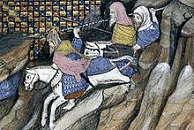
On Oct. 2, 1394 after formidable Leinster king (since 1375) Art Óg Mac Murchadha Caomhánach (Art MacMurrough-Kavanagh) (Art M'Morrough O'Cavanagh) (Art MacMorrough) (Art MacMorrow-Kavanagh) (Art MacMorrow) (1357-1417) erodes the authority of the young earl of Ulster, English king (1377-99) Richard II (Richard of Bordeaux0 (1367-1400) invades Ireland (until May 1395) with 7K men to enforce his rule (first expedition to Ireland since King John in 1210), accompanied by Thomas Woodstock, duke of Gloucester; Edmund of Langley, duke of York acts as regent in his absence; too bad, the Battle of Ros-Mhic-Thriuin (Thriúin) near New Ross in County Wexford is a V for Macmurrough; on Dec. 25 Richard II defines the borders of English rule in Ireland AKA the English Pale.

On Feb. 4, 1399 Edward III's son Old John of Gaunt, duke of Lancaster (b. 1349) dies, "ever a threat to England"; in Mar. the inheritance of his exiled son Henry Bolingbroke of Lancaster is confiscated by Richard II for his Irish war, causing grumbling among his nobles, and Henry to raise an army ("You pluck a thousand dangers on your head/ You lose a thousand well-disposed hearts" - Shakespeare, Richard II, 2.1.205-6); in June Duke Louis I of Orleans gains control of insane Charles VI, causing it to be covenient to allow Henry to leave, and after Richard II invades Ireland for a 2nd time in June to quell a revolt, giving Henry his chance, in July he lands at Ravenspur, after which Richard II returns from Ireland in Aug. to find Henry supported by Harry Hotspur and regent Edmund of Langley, duke of York (brother of John of Gaunt); on Aug. 19 Richard II (king since 1377) is captured and forced to abdicate ("For I must nothing be" - Shakespeare, Richard II, 4.1.201), then thrown into the Tower of London; Parliament asserts its ancient right of election to get around his faulty hereditary claim, and on Oct. 13 Bolingbroke (is bowling that expensive?) is crowned Henry IV (1367-1413) (England's 33rd monarch) (until Mar. 20, 1413), founding the red rose Lancastrian Dynasty (ends 1461) (descended from Edward III's 3rd son John of Gaunt), briefly adopting an eerily U.S. politician's style and promising "to be advised and governed by the honourable, wise and discreet people of his realm, and to do what is best for the government of himself and of the realm by their common counsel and assent; he does not desire to be govered by his own will, nor by his arbitrary purpose or singular opinion, but by common advice, counsel and assent"; the English Parliament is opened with a speech in English for the first time; Bay trees throughout England wither then grow green again?; Henry's rival Edmund de Mortimer, 5th earl of March is imprisoned, although allowed to inherit his vast estates; the French king (father of Richard II's wife) refuses to acknowledge Henry, and nullifies their long truce; exiled archbishop of Canterbury Thomas Arundel returns, and works with never-merry ultra-orthodox Henry IV to suppress the Lollards and burn heretics at the stake for the first time in English history, bringing the Dark Ages back, causing Lollard supporters incl. Geoffrey Chaucer to lie low?; meanwhile under Henry IV the misery in Ireland starts to peak, and eventually half of the English colony ends up returning home.
In late May 1399 Richard II makes his 2nd (last) invasion of Ireland, landing on June 1 in Waterford with only 3K troops, but a retinue of three dukes, three earls, and all five captains of the king's bodyguard; too bad, his results are muddled, and after receiving news of the landing of Henry of Lancaster in July, he scraps plans to have his nephew Thomas Holland crowned as king of Ireland in Dublin on Oct. 13, and returns to take him on; as soon as he departs, war breaks out, and his viceroy is murdered; the Battle of Tragh-Bhaile in Dundalk is a V for the Anglo-Irish over the O'Neills led by Domhall mac Enri of Tyrone, who is captured and sent to England.
In Dec. 1399 the Epiphany Rising against Henry IV by supporters of Richard II in an attempt to put him back on the throne begins, fizzling out by early Jan., sealing Richard II's fate along with that of his top supporters.

On Jan. 18, 1425 Edmund Mortimer, 5th Earl of March (b. 1391), the heir of Lionel, duke of Clarence (3rd son of Edward III) dies of the plague childless, ending the male line of the Mortimers, and Richard Plantagenet, 3rd Duke of York (1411-60), great-grandson of Edward III, husband of Anne, daughter of Roger de Mortimer, 4th earl of March inherits his vast estates in Wales incl. Ludlow plus the earldom of Ulster in Ireland, making him the richest landholder in England; he also inherits his title to the English throne, making him a player in English politics, taking Gloucester's side in the war for domination of infant Henry VI's council - starting over, life has never been this real?
In 1436 Libel of English Policie is written by anon.; it starts by "exhortynge alle Englande to kepe the see enviroun", and warns of the danger that English abuses in Ireland might let it pass into other hands.


On Jan. 28, 1450 Jack Napes (b. 1396) is arrested and imprisoned in the Tower of London for the loss of Normandy caused by his 1444 marriage negotiations over Henry VI and Margaret of Anjou, then banished for five years, but on May 2 his ship is intercepted en route to England, and he is beheaded and his body thrown overboard; his enemy Richard Plantagenet, 3rd duke of York is suspected. In 1450 the French reconquer Normandy from the English, causing the public to turn on Edmund Beaufort, 2nd Duke of Somerset (1406-55) for his ruinous polices that are causing England to lose its French possessions, causing him to be accused of treason while Henry VI tries to protect him through defeat after defeat; Parliament impeaches his ally the earl of Suffolk, but Henry will not permit him to be tried, and banishes him from England for five years, but the fickle finger of fate intervenes, and his ship is seized by pirates as he tries to cross the Channel, and he is beheaded; in May Jack Cade's Rebellion against weak unpopular Henry VI sees 30K men from Kent and Sussex incl. many respectable small landowners led by Irishman Jack Cade (1420-50) march on London demanding govt. reforms and the restoration of Richard Plantagenet, 3rd Duke of York (1411-60) (lt. of France and Ireland) (Shakespeare claims that Richard, now heading an English army in Ireland hired Cade to lead the revolt so that he could personally intervene, quell the rebellion and triumphantly take the throne by force); the rebels' stated aims are reform of the Beaufort-dominated govt. and a change of ministers; the lords of the council raise an army against them, which mutinies, causing the king to flee from London while the rebels invade the city without opposition on July 3, marching across Deptford Bridge with 46K, hunting down ministers and wreaking vengeance; when they execute a man for being able to read and write ("The first thing we do, let's kill all the lawyers", cries Dick the Butcher in Shakespeare's King Henry VI, Pt. 2, 4.2.74, meaning those who can read and write), then turn into pillagers, the citizens of London expel them, and an army led by the duke of Buckingham cruelly defeats them on July 12 in the Harvest of Heads; Jack Cade is killed; England is now on the verge of civil war, with Duke Richard of York waiting in the wings; he returns to England from Ireland with his army, and forces the king to admit him to his council, with the avowed purpose of reforming the govt. and ousting the hated duke of Somerset, but the king and queen side with the latter, and civil war is on.
In 1451 Margaret O'Conor Faly (nee O'Carroll), who takes bards under her special care holds a feast in Killeigh, Leix, at which 2.7K poets, musicians, and antiquarians are royally entertained.
In 1454 Thomas FitzJohn FitzGerald, 7th Earl of Kildare (1421-77), cousin of Thomas FitzGerald, 7th Earl of Desmond is appointed lord justice of Ireland (reappointed in 1461-70), followed in 1455 by deputy lord lt. of Ireland, and in 1463-8 by lord chancellor of Ireland, given the right by Edward IV to use the title and receive the salary for life; in 1462 he becomes justiciar of Ireland, getting an Irish parliament assembled in Drogheda 4x, with the one in 1460 given legislative independence; the cousins become leaders of the home rule party, pissing-off the English in the Pale, who plot to get them executed.

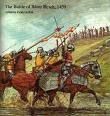

On Sept. 23, 1459 after mad king Henvy VI finally alienates the Nevilles, and James Tuchet, 5th Baron Audley, 2nd Baron Tuchet (b. 1398) is sent to arrest Duke Richard of York's chancellor (since 1454) Richard Neville, 5th Earl of Salisbury and 15th Earl of Warwick (1400-60), the Battle of Blore Heath in Staffordshire is a blorey V for the White Rose Yorkists; Tuchet is KIA; too bad, on Oct. 11 after an army led by Henry IV is advancing toward him, the Battle of Ludford Bridge (Ludlow) sees Sir Andrew Trollope (-1461) defect at the last minute from Richard's side with 600 troops overnight, compelling him to flee to France with his sons and supporters (until 1460); in Nov. the Coventry Parliament attaints them, along with all Yorkists; under threat of arrest in England, Edward III's great-grandson Richard Plantagenet, 3rd Duke of York (1411-60) flees to Ireland, and persuades the Irish parliament to pass a declaration of independence stating that Ireland is "corporate of itself" and that "henceforth no person or persons being in the said land of Ireland shall be, by any command given or made under any other seal than the said seal of the said land, compelled to answer to any appeal or any other matter out of the said land"; later Irish lord deputy (1477-94, 1496-1513) Gerald FitzGerald, 8th Earl of Kildare (1456-1513) (AKA Garret the Great Earl) refuses Edward IV's order to annul it, and it is not done until 1495 - you wanted to play god, game over, my friend?
In the 1460s the Gaelic kingdom of Tyroconnell (Gael. "land of Conaill") is established by the O'Donnell (O Domhnall) Dynasty of the Northern Ui Neill, with capital at Donegal; the O'Donnell kings of Tyrconnell become known as the Fisher-Kings for their export of fish for wine in La Rochelle, W France; it is disestablished in 1607. In 1461 Hugh Roe O'Donnell (Aodh Ruadh mac Néill Gairbh Ó Domhnaill) (-1505) becomes king of Tyrconnell in Ulster, Ireland (until 1505); in 1468 guns are used for the first time in Ireland by his troops; the reigns of he and his son Hugh Duff O'Donnell become known as the golden age of the O'Donnells.
In 1463 Thomas FitzJames FitzGerald, 7th Earl of Desmond (-1468) becomes lord deputy of Ireland for the Duke of Clarence, founding the College of Youghal in 1464, becoming known for defending the native Irish against the cruelty of English law; too bad, in 1467 he is accused by his enemies of treason and extortion, and condemned at a parliament in Drogheda along with Thomas FitzGerald, 7th Earl of Kildare, who escapes to England while he is beheaded on Feb. 14, 1468, shocking the Irish people ("slain by the swords of the wicked, or may I say a martyr)", after which Kildare gets Edward IV to revoke their attainder; meanwhile in 1467 their worst enemy John Tiptoff, 1st Earl of Worcester (1427-70) (who conspired to get Desmond executed?) is appointed by Edward IV as lord deputy of Ireland in Desmond's place, becoming known as "the Butcher of England" for his ruthlessness and cruelty to the Irish.
In 1465 the Irish parliament passes an act requiring every Irishman living in the Pale to dress and shave like the English, and take an English surname such as a color, trade, or name of a town, else forfeit his goods; another act forbids fishing in Irish seas to prevent it from enriching the Irish people; another permits decapitating thieves found robbing "or going or coming anywhere" unless they have an Englishman in their company, with the mayor of the nearest town to pay head money.
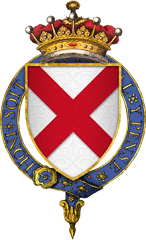
On Mar. 25, 1477 Irish lord chancellor of Ireland Thomas FitzGerald, 7th Earl of Kildare (b. 1421) dies, and his eldest son Gerald FitzGerald, 8th Earl of Kildare (1456-1513) (AKA Garret the Great Earl) becomes lord deputy of Ireland (until 1494, then 1496-1513), becoming so powerful that he is called "the uncrowned king of Ireland", with the common saying: "Since all Ireland cannot control the Earl of Kildare, then Kildare must control all of Ireland"; after he dies a legend arises that he slumbers in a cave beneath the Currah of Kildare, and awakens every seven years on May Day, riding around the Curragh on his seed; when his horse's shoes are worn down to the thickness of a cat's ear, he will allgedly lead the Irish army to drive the stankin' English out and reign as king for 40 years.


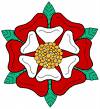
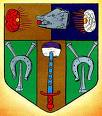

On Aug. 22, 1485 after Sir Simon Digby (-1519) of Coleshill deserts Richard III and gives Henry Tudor details of his position, the Wars of the Roses (begun 1455) between the White Rose (Rosa Alba) of York and the Red Rose (Apothecary's Rose) (Old Red Damask) (Rose of Provins) of Lancaster (White Peppermint Patty of York and Bloody Red Rose of Lancaster?) ends after 32 years and 26 days with the doglike death of Yorkist hunchback cripple king (since 1483) Richard III (Gloucester) (b. 1452) at the Battle of Bosworth (Redemore) (Dadlington) Field 2 mi. SW of Albion Hill in Leicestershire near the market town of Market Bosworth 12 mi. W of Leicester after his horse loses a nail in his shoe in a bog and goes down (with lame Richard crying "A horse! A horse! My kingdom for a horse!", according to William Shakespeare's Richard III, 5.4.7); Ben Franklin in his "Poor Richard's Almanac" of 1758 issues the soundbyte "For want of a Nail the Shoe was lost; for want of a Shoe the Horse was lost; and for want of a Horse the Rider was lost, being overtaken and slain by the Enemy, all for want of Care about a Horse-shoe Nail"; Richmond's army numbers 5K vs. 15K for Richard; actually, Richard's army attacks first, but Henry's army forms itself into a V shape, then Richard leads a charge of his heavily-armed household knights and comes to within an inch of Henry, but Henry's foot soldiers defend him and run him through, and Richard III becomes the last English king to die on the battlefield, and the first since Harold II at the Battle of Hastings in 1066; only 100 of Henry's vs. several hundred of Richard's soldiers are lost, because Yorkist turncoat Sir William Stanley leads his troops in an attack on Richard as he closes in on Henry, then, after Richard falls (he kills him?), finds the royal crown (which fell from his helmet) on a er, rose bush, and places it on Tudor's head, proclaiming him king and stopping the hostilities?; Henry's standard bearer William Brandon is killed, along with Richard's men John Howard and Robert Brackenbury; Thomas Howard is captured and imprisoned in the Tower of London (until 1488), along with Yorkist heir (the last Pantagenet) Earl Edward of Clarence (Warwick). On Dec. 16, 1485 Jasper Tudor is created the 3rd duke of Bedford, and the De Vere family (named after Ver in Lower Normandy, France) is restored to their title of earl of Oxford (insuring the future of Shakespeare's plays?); Sir William Stanley is appointed lord chamberlain; in Dec. Elizabeth Woodville is stripped of her lands and exiled; Sir Richard Howard, who dies at Bosworth Field has his titles attained, along with his son Thomas Howard, who is wounded and imprisoned until 1489; although Ireland supported the Yorkist cause, Henry VII leaves Gerald FitzGerald, 8th Earl of Kildare ("Garret the Great") (1456-1513) of the powerful Geraldine family as viceroy (1477-94, 1496-1513), Ireland's premier peer.

In Nov. 1491 Perkin Warbeck (1474-99) lands in Ireland, claiming to be Richard of Shrewsbury, Duke of York, 2nd son of Edward IV, younger brother of Edward V, and one of the Princes in the Tower, gaining supporters to overthrow Henry VII incl. Hugh Roe O'Donnell, king of Tyrconnell, while Henry VII declares him an imposter; in 1497 after making several unsuccessful landings in England with his small armies, he surrenders in Hampshire, and confesses to being a Fleming born in Tournai; his revolt costs Henry VII £13K, straining his financial resources.
In 1491 a clan war begins in Ulster, Ireland between the O'Donnells and O'Neills, which lasts over 10 years.
In 1494 HRE Maximilian I recognizes Richard, duke of York, er, Perkin Warbeck as king of England; meanwhile Henry VII sends soldier-diplomat Sir Edward Poynings (1459-1521) to Ireland as new English viceroy to replace pesky Earl Gerald of Kildare, who had been supporting Perkin Warbeck, making sure the new viceoy is purely English and will reestablish English control against the sell-out Irish-loving longtime Anglo-Norman residents; Poynings summons the Irish Parliament to Drogheda and informs them that they will be subservient to the English Parliament, and forces them to enact Poyning's Law (Statute of Drogheda) (repealed 1782) to Anglicize them, reducing the power of Anglo-Irish lords and providing for the defense of the English Pale while resurrecting and reconfirming the 1366 Statue of Kilkenny enforcing segregation and confirming the Irish as second class in their own country; the Irish Parliament is made subservient to the English king, requiring him to be informed of proposed legislation and then license Parliament to meet if he approves it; after a time Kildare, the most powerful of the Irish nobles is reinstated on a short leash, and the Pale prospers while those outside the Pale, ahem it takes until the 1800 Acts of Union to repeal it.
In 1497 Perkin Warbeck arrives in Cork, Ireland from Scotland, fails to gain support, then lands in Cornwall during the Cornish Rebellion of 1497, led by atty. Thomas Flamank (son of a royal tax collector) and Michael Joseph (Myghal Josep), AKA An Gof (Gael. "blacksmith"), which starts after Parliament attempts to impose a tax for the proposed invasion of Scotland, causing 15K to march unopposed across the English countryside on London; on June 17 they meet the English army at Deptford Bridge at Blackheath, and are defeated, with 2K KIA and the leaders executed by July 22, becoming the last major revolt against Norman rule in Britain since their brazen 1066 takeover - way to go, Liberace?
In 1505 Hugh Roe O'Donnell dies, and his son Sir Hugh Dubh (pr. "doo") O'Donnell (-1537) becomes king of Tyrconnell in Ulster, Ireland (until 1537), expanding O'Donnell power into N Connaught while developing an alliance with the English crown authorities in Dublin, getting knighted by Henry VII in London in 1513 after a 1511 pilgrimage to Rome; meanwhile he leaves his boy son Manus O'Donnell (-1564) in charge, who turns traitor and allies with the hated O'Neills, causing daddy to appeal to the Maguires for aid, leading to another clan war in 1522.
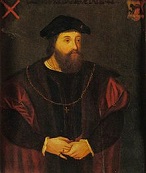
On Sept. 3, 1513 Gerald FitzGerald, 8th Earl of Kildare (b. 1456) AKA Garret the Great dies, and his son Young Gerald FitzGerald, 9th Earl of Kildare (1487-1534) succeeds him as lord deputy of Ireland (until Feb. 1534).

On Mar. 10, 1520 Thomas Howard, 3rd Duke of Norfolk, Earl of Surrey (1473-1554) (uncle of Anne Boleyn) is appointed lord deputy of Ireland, with orders from Henry VIII to use persuasion rather than violence, facing the thankless task of pacifying the rival factions of the Earl of Kildare and Earl of Ormonde, sending letters demanding money and troops; he is recalled at the end of 1521 to take command of the English fleet for naval operations against France.
In 1522 after the O'Neill clan led by Conn O'Neill ally with Munster and Connacht along with the MacDonnells of Antrim and English and devastate Tyrconnell, taking the castle of Ballyshannon, the Battle of Knockavoe (Cnoc-Buidhbh) near Knockavoe (near Strabane), County Tyrone, Ireland sees the O'Donnell clan led by Hugh Dubh O'Donnell (-1618) and his older brother Manus O'Donnell (sons of Sir Hugh Dubh O'Donnell) stage a surprise night attack on the camp of the O'Neills, killing 900 and taking an immense booty.
On Apr. 21, 1529 Spanish diplomat Gonzalo Fernandez comes to Ireland to visit the Earl of Desmond in Dingle, who requests the Spanish king to supply him with a small fleet of four large 200-ton ships and six smaller ones with cannons along with 500 Fleming soldiers to fight the pesky English Protestants, which he reduces to just the artillery after being asked what signal service he had done to justify it.

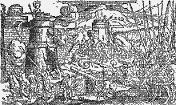
In Feb. 1534 after Gerald FitzGerald, 9th Earl of Kildare is summoned to London, he appoints his 21-y.-o. son "Silken" Thomas Fitzgerald, 10th Earl of Kildare (1513-37) (AKA Lord Offaly) in his absence as lord deputy of Ireland; on June 11 after hearing rumors that his father has been executed in the Tower of London and that he's next, he declares a revolt against the stankin' English in front of the council at St. Mary's Abbey in Dublin with 140 horsemen wearing silk fringes on their helmets, then in July after gaining recruits sieges Dublin Castle, which has been held by the stankin' English since the Strongbow (Richard Fitz Gilbert) era in 1171; too bad, on July 28 after his army is routed, he has archbishop John Alen (Allen) of Clontarf (b. 1476) executed for trying to mediate, alienating the Irish clergy.
In Nov. 1534 the First Act of Supremacy completes the breach of the Church of England with the Roman Catholic Church, with ambassador ? issuing the soundbyte: "This Act of Supremacy is no less than declaring the king to be the pope of England"; it is followed by the 1534 Treasons Act (repealed by the 1547 Treasons Act), which makes it treason to disavow the Act of Supremacy, punishable by death, which is soon used on Sir Thomas More; in practice, mere allegiance to the pope is considered treason.
In Mar. 1535 Silken Thomas' Maynooth Castle in County Kildare, Ireland is taken by an English force under Sir William Skeffington by bribing a guard while Fitzgerald is away in gathering reinforcements, putting the garrison to death after promising them a pardon, which becomes known as the "Maynooth Pardon", after which Fitzgerald, failing to spark a gen. uprising against the stanking' English s surrenders to new Irish lord deputy Leonard Grey, 1st Viscount Grane (1479-1541) under the promise of the king's mercy, after which the dope is sent to the Tower in Oct., then hanged, drawn and quartered in Tyburn, England with his five uncles on Feb. 3, 1537 - I thought maybe, but they really are stankin' English?
In 1536 the cent.-long Tudor Reconquest of Ireland begins (ends 1730), with English under Henry VIII forcing Irish nobles to give up their Gaelic custom of electing chieftains in favor of Roman, er, English-style male primogeniture via the legal mechanism of surrender and regrant, receiving new English feudal titles that change the "Macs and Oes" into Englishmen, incl. the earl of Thomond (O'Briens), earl of Clanrickard (Mac William Burkes), baron of Upper Ossory (MacGillapatricks), and earl of Tyrone (O'Neills) - so they'll become as corrupt as they are?
In 1536 the English Parliament declares the authority of the pope void in England; meanwhile in Oct. after Henry VIII orders the Dissolution (Suppression) of the Monasteries (ends 1541), causing 376 religious houses in England to be dissolved by royal decree, the Pilgrimage of Grace in Yorkshire sees 40K men led by lawyer Robert Aske (1500-37) of Doncaster march through N England protesting the looting of the churches and monasteries by Henry's iconoclastic govt., also seeking relief from tax collectors; pro-Roman Catholic Thomas Howard, 3rd duke of Norfolk negotiates their surrender; Don't Aske is executed for treason next July 12; meanwhile Thomas Cromwell rises to Baron Cromwell of Oakham and Lord Privy Seal, setting up a bureaucratic machine to administer all the income generated by selling Church land and closing monasteries; too bad his big schmuck arrogance and venality causes him to make a lot of enemies; Thomas Mildmay (1515-66) gets a lucrative job as royal admin. of the ecclesiastical revenues annexed to the crown, allowing him to later set up his son Walter Mildmay as privy chancellor and chancellor of the exchequer under Elizabeth I; next year Henry VIII introduces legislation in the Irish Parliament to close the monasteries, which faces considerable opposition, causing only 16 of 400 to be closed, but after regrouping he gets about half closed by the time of his death in 1547 - magic green, cleans like magic?
On Feb. 3, 1537 Silken Thomas FitzGerald, 10th Earl of Kildare (b. 1513) and his five uncles are executed in Tyburn, London for rebellion, and the English Crown tries to capture his 12-y.-o. half-brother Gerald FitzGerald, 11th Earl of Kildare (1525-85), new head of the FitzGerald Dynasty, who is hidden by his aunt Lady Eleanor McCarthy, and seeks to protect him by accepting a marriage offer from Manus O'Donnell (-1564), who in July after the death of his father Sir Hugh Dubh O'Donnell succeeds as king of Tyrconnell in Ulster, Ireland (until 1555); Kildare relative Conn O'Neill (1480-1559) (later 1st Earl of Tyrone) forms the short-lived Roman Catholic Geraldine League incl. the O'Donnells, O'Neills, O'Briens of Thormond et al., allying to restore Lord Kildare to his rightful position and later to overthrow English rule in Ireland.
In 1537 John Travers, chancellor of St. Patrick's Cathedral in Dublin becomes the first of the Irish Catholic Martyrs who die for their faith (until 1714); on Sept. 22, 1992 Pope John Paul II beatifies 17 of them.
In 1541 after invading Tir Eogain, new (since July 7, 1540) lord deputy of Ireland Sir Anthony St. Leger (Sellenger) (1496-1559) defeats the Geraldine League and its leader Conn O'Neill, king of Tir Eogain, who is captured and sent to a parliament in Trim, then goes to England to convert to Protestantism and submit to Henry VIII, who creates him the 1st Earl of Tyrone and presents him with a nice gold chain and money, receiving land grants in the Pale in Balgriffin and being made a privy councillor in Ireland, pissing-off his Gaelic Roman Catholic clansmen and causing his son Shane O'Neill (1530-67) to begin a campaign to be recognized as The O'Neill despite the English and branches of his own family backing other claimants; meanwhile Henry VIII convenes the Irish Parliament to pass the 1542 Crown of Ireland Act on June 18, abolishing the high kingship of Ireland and changing his old title of lord of Ireland (conferred by the pope) to king of Ireland, making make him head of the Irish Church, discarding the old fiction that Ireland is a feudal province of the Church and that England was still a Roman Catholic country and establishing the new Kingdom of Ireland (ends Jan. 1, 1801); meanwhile in actual fact the Irish fight for every chance to break free from the stankin' English, who to them are nothing but plunderers - which only makes the Irish pop. more determined to never become Protestant?
On Apr. 1, 1551 (Easter Sun.) the English Book of Common Prayer is used for the first time in Ireland at Christ Church Cathedral in Dublin.
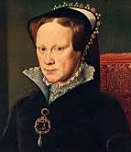

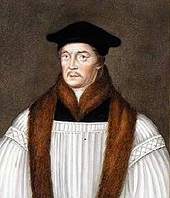


Nausea, heartburn, indigestion, upset stomach, diarrhea, Bloody Mary is maximum pink? Or, hit it, Mrs. Church? On May 25, 1553 as part of a Protestant plot by John Dudley, duke of Northumberland, 15-y.-o. Lady Jane Grey (1537-54) (cousin of Edward VI, great-niece of Henry VIII, and great-granddaughter of Henry VII) (who knows Latin, Greek, and Hebrew) marries his son Guilford (Guildford) Dudley (1536-54), brother of horsemaster Robert Dudley, earl of Leicester; on July 6 after the king's council signs the handwritten King's Device, English king (since 1547) Edward VI (b. 1537) dies of TB; in it he passes over his half-sisters Mary Tudor and Elizabeth for Protestant Lady Jane Grey (1537-54) ("the 9-day queen") (sometimes called the 13-day queen when July 6 is counted), and after Thomas Cranmer forgives his pledge to carry out Henry VIII's will giving it to Mary Tudor, she is proclaimed queen on July 10 in the Tower, and struts her royal stuff until July 19 (never leaving the Tower), with Edward's Greek tutor Sir John Cheke as secy. of state; John Dudley tries to capture Mary in Norfolk and is instead captured in July; meanwhile Mary gathers her forces in East Anglia, and on July 19 after being accompanied by a large force to London along with future Elizabeth I, militant Roman Catholic Mary I Tudor (1516-58), duchess of Suffolk (granddaughter of Ferdinand II and Isabella I the Catholics), later known as Bloody Mary is proclaimed queen (the 42nd British monarch) (until Nov. 17, 1558); the military show of support causes Lady Jane Grey's supporters to fold, and she and her husband are arrested on July 20; Mary I is crowned on Oct. 30 in Winchester Cathedral, immediately signalling a return to Roman Catholicism, and signing a marriage treaty with her cousin Philip II of Spain, promising him the title of King of England without the powers or the succession, triggering Wyatt's Rebellion, with a Protestant army headed by Sir Thomas Wyatt the Younger (1521-54) (son of poet Sir Thomas Wyatt, father of the English sonnet), which heads for London, where they are defeated and the leaders executed by next year, with Elizabeth locked up for almost a year, escaping being implicated in the plot by a hair; too bad, Lady Jane Grey (who has been spared so far and kept in the Tower) is implicated, so her head is on the chopping block with theirs; meanwhile Stephen Gardiner (1483-1555), bishop of Winchester becomes lord chancellor, and soon heads begin to roll; John Knox flees to Geneva to be with John Calvin; St. Paul's chaplain Edmund Grindal flees to Germany (until 1559); Sir John Cheke is imprisoned; Miles Coverdale is removed as bishop of Exeter and imprisoned for two years, then goes into exile for eight years in the Continent (Wesel, Bergzabern, Geneva) (until 1559); after returning to England from exile after the death of Henry VIII in 1547 and being received by Edward VI, who restores his lands, Gerald FitzGerald (1525-85) is restored as 11th Earl of Kildare for his help in suppressing the rebellion, and returns to Ireland, becoming known as "the Wizard Earl" for his interest in alchemy and magic; Thomas Cranmer is reprimanded and confined to his palace at Lambeth, and arrested on Sept. 14 then imprisoned in the Tower of London; Edmund Bonner is released, and goes completely Catholic, becoming known as "Bloody Bonner" for his zealous persecution of Protestants; Thomas Howard, 3rd duke of Norfolk is released from the Tower, and his lands and titles restored, keeping the resilient Howard name going, with his grandson Thomas Howard, 4th Duke of Norfolk (1536-72), son of his dead son Henry Howard inheriting the dukedom on his death next year; on Aug. 23 John Dudley is beheaded after feigning conversion to Roman Catholicism; his son Robert Dudley (b. 1533) (who became an MP this year) supports his father, and ends up in the Tower under sentence of death at the same time that Elizabeth is imprisoned there, sparking rumors that they begin a romance, despite him being married? Queen Mary I proves herself English first and Roman Catholic second by ordering the Irish pop. of Kings and Queens County driven out and their lands given to English colonists, becoming the first English monarch to try colonizing butt-of-the-joke Ireland with stankin' English settlers.
In 1555 Pope Paul IV issues a bull recognizing Mary I of England as queen of Ireland, uniting the kingdoms of Ireland and England.
In 1555 Calvagh O'Donnell (1515-66) and Sir Hugh O'Donnell (-1600) take over the lordship of Tyrconnell from their uncle Manus O'Donnell, who dies in 1564, after which his younger brother Hugh Dubh O'Donnell gains the support of Rev. Miler Magrath (McGrath), Anglican archbishop of Cashel in unsuccessfully challenging them, building a power base in N Dongel and the Swilly River, with castles at Cahir Anuske and Ramelton, but is unable to gain support of the English crown in Dublin.
In 1562 after allying with the Scottish McDonnell clan who had settled in Antrim, Ireland, Shane O'Neill is inaugurated as The O'Neill, visiting Queen Elizabeth I in 1563 and claiming the title of 2nd Earl of Tyrone, who agrees to recognize his claims over Brian O'Neill, son of the assassinated Feardorcha, Baron of Dungannon on the condition that he submit to her authority and that of her deputy the Earl of Sussex, but the deal falls through when he demands a guarantee of his safety, causing Elizabeth I to establish Brian O'Neill in his place, only to see him KIA in Apr. in Shane's absence by Shane's Tanaiste (designated heir) Sir Turlough Luineach O'Neill (1532-95), after which Hugh O'Neill succeeds Brian as Baron of Dungannon, and when he returns Shane goes to war with the O'Donnells and MacDonnells to recognize his hegemony in Ulster, using his deal with Elizabeth I to justify turning on the Scots, burning Armagh Cathedral and fighting to a push in 1564 with Sorley Boy MacDonnell (Domhairle Buidhe Mac Domnhnaill) (1505-90) near Coleraine, and routing the MacDonnells at the Battle of Glentasie in N Ulster on May 2, 1565, killing 300-400; meanwhile in 1565 Sir Henry Sidney (1529-86) becomes lord deputy of Ireland, uttering the soundbyte: "Lucifer himself was not more puffed up with pride and ambition than O'Neill", causing the English to invade Donegal and restore the O'Donnells, while Shane O'Neill ravages the Pale, makes an unsuccessful attempt to take Dundalk, makes a truce with the MacDonnells, and seeks the help of the Earl of Desmond, losing the decisive Battle of Farsetmore near Letterkenny, County Donegal on May 8, 1567 to the O'Donnells of Tyrconnell, losing 600-1,300 KIA, ending Shane O'Neill's aspirations of becoming king of Ulster, fleeing to his enemies the MacDonnells hoping for an alliance, only to be assassinated by them on June 2 after they make a deal with Sir Henry Sidney and William Piers (1510-1603), Seneschal of Clandeboyne, cmdr. of the English garrison in Carrickfergus, who sends Shane's head to Dublin Castle; after Shane's death, Turlough Luineach O'Neill is inaugurated as The O'Neill (until Sept. 1595), managing to fight off the stankin' English despite his rep among the English of being a drunken bum.
In Feb. 1565 after the Old English (descendants of those who moved to Ireland in the 12th-13th cents.) families Butler of Ormonde and Fitzgerald of Desmond in Munster in S Ireland almost end their 13th cent. feud with the "Battle That Never Was" in 1560, when the widowed Countess of Ormonde marries the Earl of Desmond, only to die in 1564, leaving her Protestant pro-Elizabeth I son Thomas Butler, 10th Earl of Ormonde (1531-1614) and his Roman Catholic hereditary enemy Gerald Fitzgerald (FitzGerald), 15th Earl of Desmond (1533-83) (head of the Geraldines) to go back to their billy goat ways, they escalate it to all-out war and fight the private Battle of Affane in County Waterford in Munster in SE Ireland, one of the last private battles in the British Isles, which is a V for the Butlers but leads to the Desmond Rebellions in 1569-73 and 1579-83 in Munster; the feud doesn't end until 1629.
In 1566 Sir Hugh O'Donnell (-1600) becomes king of Tyrconnell in Ulster, Ireland, seeing his sons stage a violent succession dispute in the 1580s until he abdicates in 1592 in favor of son "Red" Hugh Roe O'Donnell.


In Aug. 1568 Sir Peter Carew (1514-75) sails to S Ireland by leave of Elizabeth I to stake a murky legal claim to lands granted to a remote ancestor by Henry II, and ends up stepping on the toes of the Anglo-Norman Butler family, headed by Protestant Sir Thomas Butler, 10th Earl of Ormonde (1531-1614), starting the Desmond Rebellions (1569-73, 1579-83) after they all step on the toes of the Roman Catholic Desmond (Gael. "south Munster") family in Munster, led by the Protestant FitzGerald (Geraldine) family, devastating Munster, slaughtering the rural pop. and stripping them of food and shelter, making them resort to cannibalism; "They looked like anatomies of death; they did eat the dead carrion and one another soon after, insomuch as the very carcasses they spared not to scrape out of their graves" (Edmund Spenser); the fear of marauders destroying their crops causes the Irish to begin relying on potatoes, ending up overreliance on a single crop and regular famines?
On June 20, 1571 St. Patrick's Cathedral treasurer John Kearney pub. the Protestant primer Aibidil Gaoidheilge agus Caiticiosma (Alphabet of the Irish language and Catechism; That is, Christian instruction or teaching along with certain articles of the Christian rule that are proper for everyone who would be obedient to the law of God and the Queen in this kingdom) in Dublin, becoming the first book printed in the Irish language in Ireland.
In 1573 the Earl of Essex attempts to establish a colony in Antrim on the NE shore of Lough Neagh; in July 1575 Essex sends Francis Drake and John Norreys to oust Scottish refugees on the reverse L-shaped Rathlin Island, massacring hundreds of men, women, and children of Clan MacDonnell.


On Mar. 8, 1574 English Capt. William Martin sieges Rockfort Castle on Clare Island in Connaught (Connacht), W Ireland, stronghold of notorious female Irish pirate ("Pirate/Sea Queen of Connacht") ("Dark Lady of Doona") Granuaile (Grainne) (Grace) O'Malley (1530-1600), and after 18 days gives up, enhancing her rep.; in 1577 she offers her services along with three galleys and 200 men to English gov. Sir Henry Sidney in Galway, but ends up getting caught raiding English lord Earl of Desmond, and imprisoned until 1581.
On July 18, 1579 the Second Desmond War (Rebellion) (ends Nov. 11, 1583) in Munster, Ireland begins when the oppressed pissed-off Roman Catholic Irish, led by Gerald FitzGerald, 15th Earl of Desmond (1533-83) of the Irish house of Geraldine in Munster (enemies of the Protestant Butlers) revolt from the stankin' Protestant English, spurred on by papal legate Nicholas Sanders (Sander) (1530-81) and the Spanish, who send 600 troops to Smerwick Bay, beginning a long struggle to suppress them; the English army, led by Sir William Drury (1527-79) and his able capt. William Stanley (1548-1630) win the Battle of Limerick, the Battle of Monasternenagh, and the Battle of Adare, for which Stanley gets knighted; Sir Walter Raleigh serves as capt. of an English infantry co.


On Sept. 10, 1580 after being secretly sent by Spanish king Philip II and financed by Pope Gregory XIII, Spanish ships under command of Adm. Don Juan Martinez de Recalde (1540-88) land 600 Italian-Spanish freelance soldiers supporting the Desmond Rebellion commanded by Sebastiano di San Giuseppe (da Modena) in Smerwick on the Dingle Peninsula (westernmost point of Ireland/Europe); meanwhile 4K men East of their position led by Lord Desmond, John of Demond, and Lord Baltinglass attempt to link up with them for supplies, but are blocked by English forces under the 10th Earl of Ormond and Arthur Grey, 14th Baron Grey de Wilton (1536-93), new lord deputy of Ireland (until 1582), while English ships under Richard Bingham blocked Smerwick Bay, causing the papal forces to retreat to the nearby Fort of Gold (Slaughter) (Dun an Oir); on Nov. 7-10 the English stage the Siege of Smerwick (Ard na Caithne); when the papal forces surrender they are summarily executed under de Wilton's orders.
On June 19/20, 1584 after being smuggled into Dublin in fall 1583 and getting arrested in Sept. while staying with Lord treasurer of Ireland Thomas Butler, 10th Earl of Ormond without his consent, followed by torture and a kangaroo trial after refusing to convert to Protestantism, Roman Catholic archbishop of Cashel, Ireland (since 1583) Dermot O'Hurley (b. 1530) is hanged in Hoggen Green, Dublin, joining the Irish Catholic Martyrs; on Sept. 27, 1992 he is beatified by Pope John Paul II.
In July 1584 the Munster Plantation is begun by the stankin' English as punishment for the Desmond Rebellions, with the depopulated estates of the Geraldine Desmond dynasty confiscated and given to colonists from England and Wales as a bulwark against future rebellions, starting with sending a commission led by Ireland surveyor-gen. (since 1559) Sir Valentine Browne (1510-89) to allocate confiscated lands to English Undertakers, wealthy colonists who undertake to import tenants, develop new towns, and provide for common defense; lands are confiscated in the modern-day counties of Cork, Kerry, and Limerick; by 1589 700 English tenant families plant 500K acres; too bad, English soldiers are withdrawn in the 1590s, and in 1598 the Nine Years War causes most settlers to flee to walled towns or back to England, and the plantation isn't reconstituted until after the rebellion ends in 1603 by Munster gov. George Carew.
On Dec. 3, 1586 after bringing them to Ireland last year, Sir Walter Raleigh's 2nd in command Sir Thomas Herriot arrives in England with the first potatoes (Solanum tuberosum), just in time to combat a severe corn shortage in England this year; too bad, Bible-thumpers can't find them mentioned, so they don't want to plant them, although Roman Catholics later settle for sprinkling them with holy water and planting them on Good Friday; Sir Walter Raleigh later gets the credit instead of him; actually, Raleigh never visited a country that had potatoes?






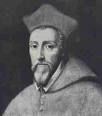
It's getting to be a habit with me? Another big V for Protestantism? The future of the English is so bright they need to wear shades? In Feb. 1588 the Marquis of Santa Cruz dies, and is replaced by Don Juan Alonso Perez de Guzman el Bueno, Duke of Medina-Sidonia (1502-58) as cmdr. of the Invincible Spanish Armada (130 galleon ships carrying 19K-27K men), whose plan is to land in Sandwich-Deal and support an invasion of England through Kent by the Duke of Parma's professional soldiers coming from Flanders (reinforced through the Spanish Road from N Italy), capturing it for the Roman Catholic faith, with exiled English Cardinal William Allen (1522-94) waiting in the wings; it sets sail from Lisbon on May 30, the very day that peace commissioners sent by both sides meet in Parma; after stopping at Corunna for supplies, it sets sail again, then is scattered by a storm from the Bay of Biscay; in early July it leaves La Coruna; on July 19 it is sighted off the The Lizard (Peninsula) by the 197-ship English navy (34 royal warships, 163 armed merchant vessels); on July 21 there is a skirmish off Eddystone, Plymouth, and another on July 23 off Portland, Dorset; on July 27 the Armada anchors off Gravelines between France and Spanish Netherlands to await for communications from Parma's army, the stench from its filthy galleys rowed by slaves chained to their benches carrying for miles on the wind; on Aug. 7-8 (July 28-29 Old Style) (Sun.-Mon.) English "hell-burners" (fire ships) are sent into the 130-ship (22 galleon and 108 armed merchant vessels) Spanish Armada (known for its powerful crescent formation) at the Battle of Gravelines, causing it to break ranks, after which it is defeated by the English guns at close quarters, losing five ships, with the rest badly damaged, and 600 KIA, 800 wounded, and 397 POWs taken; it then makes for Scotland without Parma's army, where it is broken up by a great "Protestant wind" off the coast on July 30, then forced onto the N and W Irish coasts, where 24+ ships are wrecked; the Spanish warship La Girona fires a broadside at the Chimney Tops in the Giant's Causeway on the N coast of Ireland (60 mi. NW of Belfast) after believing them to be an enemy fortress, ending up wrecked on Oct. 26, losing all but nine of 1.3K aboard; on Aug. 19 (Aug. 9 Old Style) glammed and glowing queen (since Nov. 17, 1558) Elizabeth I (1533-1603) rides down to Ft. Tilbury in Essex to cheer up the troops and see the Armada, and rides out with a 6-man bodyguard, giving her big Tilbury Speech while mounted on a grey gelding and dressed in white with a silver cuirass (metal breastplate), with the immortal soundbyte: "I have the body but of a weak and feeble woman, but I have the heart and stomach of a king"; after waiting two more days for a possible invasion by Parma's army from Dunkirk, the English troops disperse and party hearty; meanwhile the remaining 53 intact Spanish ships, having lost two-thirds of their men (15K-20K of the 11K sailors and 19K soldiers) straggle back to Spain by Oct. 14; the English lose eight ships, 50-100 killed, and 400 wounded, although 6K-8K later die of disease; Drake's co-admirals Martin Frobisher and John Hawkins are knighted for their role in the big British V; Elizabeth I hands out medals with the inscription "God breathed and they were scattered"; on Sept. 29 Spanish warship San Esteban is wrecked on the W coast of Ireland, with all survivors killed or taken POW and hanged after reaching shore; 10K English troops were equipped with firearms as an experiment, while the Spanish relied on archers, and the English success convinces military experts to give up on archery; the Armada Portrait of Elizabeth I, by an unknown artist shows her resting her hand on a globe over America; English Roman Catholic Charles Neville, 6th Earl of Westmorland (1542-1601), who commanded a 700-man army of English fugitives from Flanders flees to the Continent, and is attainted by Parliament, living on a small pension from the Spanish king until he dies broke on Nov. 16, 1601; after getting separated from the fleet in July and forced to battle some of England's most powerful ships until putting into port in Ireland, Spanish 2nd in command Adm. Don Juan Martinez de Recalde (1540-88) returns to A Coruna, dying of his wounds on Oct. 23 a few days after docking; British sea supremacy begins, along with increasing nationalism in England, helping secure Protestantism as England's state religion, and being white and not olive-skinned or some other shade of red, brown or black as the metareligion; Spain's officer class is wiped out, the Duke of Medina-Sidonia never recovers from the humiliation, the Duke of Parma's rep. remains under a cloud, but the Spanish keep hoping for a miracle from God to defeat the infidels, sending four more armadas until 1601; the Dutch are greatly helped in their battle for independence from the Spanish, going on to clear them from the territories of the Seven United Provinces by the end of the cent.
In 1588 Fort Duncannon (Gael. "Dun Conan" = "Fort of Conan") in Duncannon Harbour in County Wexford, Leinster, Ireland is built to withstand the Spanish Armada.
On Sept. 3, 1590 the Battle of Doire Leathan in SW County Donegal, Ulster, Ireland sees a force of Scottish Redshank mercenaries working for Queen Ineen Dubh on behalf of her son "Red" Hugh Roe O'Donnell (1572-1602) (great-great-grandson of Hugh Roe O'Donnell, Tyrconnell king in 1461-1505) (who is imprisoned in Dublin Castle) defeat and kill his elder half-brother Sir Donnell O'Donnell (b. ?), the leading rival to the lordship of Tyrconnell, allowing him to finally succeed in 1592 on his father Sir Hugh O'Donnell's abdication after he marries Rose O'Neill, daughter of Hugh O'Neill, 2nd earl of Tyrone in 1587.
In 1592 Trinity College (College of the Holy and Undivided Trinity) in Dublin, Ireland is founded by Elizabeth I for Anglicans only, with the intention of building a univ. around it, which never happens, causing it to also be known as the U. of Dublin; in 1793 Roman Catholics and Dissenters are admitted, but under restrictions that aren't lifted until 1873; in 1871-1970 the Roman Catholic Church prohibits members from attending without permission; women are admitted in Jan. 1904.

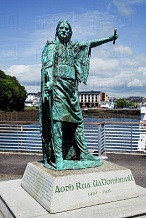
In Apr. 1593 Tyrone's Rebellion (Nine Years' War) begins (ends Mar. 31, 1603) when Gaelic Irish chieftain Hugh O'Neill, 2nd Earl of Tyrone (1550-1616) and his son-in-law, Tyroconnell king (since 1592) "Red" Hugh Roe O'Donnell (1572-1602) try to resist the advance of the stankin' English from the Pale to the whole island, rallying Irish septs.
In 1596 Hugh O'Neill leads the Irish chieftains in an unsuccessful attack against the English, but the Second Spanish Armada, trying to support the Gaelic Confederation in Ireland is prevented from landing by bad weather; the Earl of Essex sends Capt. Lea as his messenger to present the severed head of an Irish rebel to Elizabeth I, which disgusts her.


On Aug. 14, 1598 Irish forces under Irish "Erin go Bragh" freedom fighter Hugh O'Neill, 2nd Earl of Tyrone (1550-1616) ambush the English under Irish marshal Sir Henry Bagenal (b. 1556) at the Battle of the Yellow Ford near the Blackwater River in Ulster, and annihilate them, killing or wounding 1.2K English troops, which leaves English-held territory down to Dublin undefended; in return for sparing the remnant of Bagenal's army locked up in the Cathedral of Armagh, Tyrone is given Armagh and Portmore Fort on the Blackwater River, which becomes the home of the O'Neills; FitzGerald Land, an English colony in Ireland backed by Elizabeth is destroyed, pissing her off and convincing her that she needs to conquer Ireland once and for all; her favorite Robert Devereux, 2nd Earl of Essex (1565-1601) talks her into making him head of the English campaign against the Irish and Spanish as Lord Deputy of Ireland, commanding the largest force in Elizabeth's reign (16K infantry, 13K cavalry); the Spanish promise to help the Irish, but take till 1601, too little too late?

On Mar. 27, 1599 the 2nd Earl of Essex leaves London, arrives in Dublin on Apr. 15 with 17K troops, and loses all but 4K of his men by Aug. without engaging Hugh O'Neill directly; on Aug. 15 (eve.) the Battle of Curlew Pass sees 1.5K tired-hungry English infantry and 200 cavalry under Sir Conyers Clifford get ambushed while marching through a pass in the Curlew Mts. near Boyle, W Ireland by an equal number of Irish troops plus 600 musketeers and 160 Gallowglassses led by Red Hugh O'Donnell, losing 231 KIA and 218 wounded vs. unknown losses for the Irish, becoming the last time the Irish Gaelic clans win on Irish soil before their final defeat at Kinsdale in 1601; in 1999 the sculpture the Gaelic Chieftain by Maurice Harron (1946-) is erected 2 km NE of the battlefield; on May 29 the Battle of Deputy's Pass in County Wicklow, Leinster is a V for 450 Irish under Felim McFiach O'Byrne (son of Fiach McHugh O'Byrne) over 500 English under Sir Henry Harrington, who lose 250, vs. only 20 Irish; on Sept. 7 outnumbered 2-to-1, Essex makes a secret truce with Irish rebel Hugh O'Neill at the Ford of Bellaclynth on the River Lagon near Carrickmacross, then suddenly abandons his army on Sept. 24, rushes back to England, and reaches Westminster on Sept. 28, where he brashly barges into the queen's bedchamber all muddy before she has time to put on her weird white (lead or bismuth based?) makeup (he has really done it this time?); after ascertaining that the rumors that he was leading his army to her palace to stage a coup are unfounded, she has him put under house arrest for botching the Ireland expedition (which MP Robert Cecil calls the heaviest loss by the English on Irish soil along with the Battle of Deputy's Pass in Wicklow), and on Nov. 29 the Star Chamber condemns him without a trial, causing him to get (play?) sick to try and get back in the queen's favor, without success?
In 1600 World pop: 500M (doubles in the next two cents.); Am. colonies: 50K; Delhi: 500K; Lahore: 500K; Agra: 500K; Rome: 100K; France: 16M; Germany: 14.5M; Poland: 11M; Spain: 8M; Hapsburg dominions: 5.5M; England-Ireland: 2.5M; Holland: 3M; Lisbon: 100K, Madrid: 60K, Goa: 60K.
In the 1600's decade the potato is introduced to Ireland, which up till now had difficulty feeding itself, eventually causing a pop. explosion; too bad, Ireland becomes overdependent on a single crop?
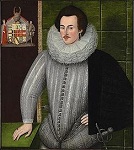
On Oct. 2, 1601 the fifth and last Spanish armada lands 4K men in Kinsale (S of Cork), Ireland to help the Irish under rebel (since 1593) Hugh O'Neill, 2nd Earl of Tyrone (1550-1616) fight the stankin' English under new lord deputy of Ireland (since 1600) Charles Blount (pr. like blunt), 8th Baron Mountjoy and 1st Earl of Devonshire (1563-1606), starting with the unsuccessful month-long Siege of Donegal by Tyroconnell king (since 1592) "Red" Hugh Roe O'Donnell (1572-1602); on Dec. 24 (Christmas Eve) they begin the Battle (Siege) of Kinsale (Kinsala), with a night attack on the stankin' English, but take too long and don't reach them until dawn, and the poorly-trained Irish foot soldiers and spear-chucking stirrup-less Irish cavalry are easily defeated by the English cavalry and their lances, causing them to flee, after which the English encircle Kinsale and starve it out (ends Jan. 3); Hugh Roe O'Donnell flees to Spain to seek support from Philip II, dying in Valladolid, Spain on Sept. 10, 1602 and being succeeded by his younger brother Rory O'Donnell (AKA Red Hugh II) (1575-1608), who becomes the last king of Tyrconnell, followed on Sept. 4, 1603 by 1st earl of Tyrconnell (until Sept. 14, 1607).
On Jan. 3, 1602 the Northern Irish chieftains are defeated at the Battle (Siege) of Kinsale (Kinsala) (begun Dec. 24), effectively ending Tyrone's Rebellion (Nine Years' War) (begun Aug. 1594) and completing England's conquest of Gaelic Ireland after great cruelty is practiced on both sides, but since the English are on Irish soil they don't hesitate to destroy crops, cattle, and whole villages, and practice genocide, laying Munster and Ulster waste, causing starvation that kills more people than the war; after he destroys his own capital at Dungannon and hides in the woods as English forces under Lord Mountjoy approach, Hugh O'Neill holds out until next Mar. 31, seeing his leaders surrender one by one due to starvation.
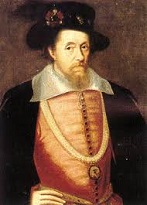

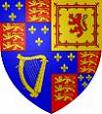
On Jan. 17, 1603 Elizabeth I dines with Lord Thomas Howard at the Charterhouse, and creates him Lord Howard de Walden, then on Jan. 21 moves her court from Whitehall to "her warm winter box" of Richmond Palace in Surrey on the Thames River (which later becomes known for Pen Ponds in Richmond Park, which hosts open-air ice-skating), wearing summer clothes in the cold weather, and telling Lord Nottingham, "My seat hath been the seat of kings, and I will have no rascal to succeed me; and who should succeed me but a king?"; on Feb. 6 she makes her last public appearance, receiving Venetian envoy (first during her reign) Giovanni Carlo Scaramelli, supposedly to discuss curtailing English piracy in the Mediterranean, speaking to him in Italian and gloating about scoring a coup against the pope by getting the Doge to recognize her after 45 years; on Feb. 16 she okays a pardon for Tyrone, and attends the funeral of her cousin and closest female friend the Countess of Notthingham, daughter of Lord Hunsdon at Richmond, going into a depression and having to have her coronation ring sawed off after it becomes impacted, then writes to Henri IV of France that "All the fabric of my reign, little by little, is beginning to fail"; on Feb. 26 she delays a meeting with French ambassador de Beaumont; in Mar. she develops a fever, rallies on Mar. 11, relapses on Mar. 12, refuses medical treatment and food, lies on the floor on cushions in her clothes, develops pneumonia, and refuses to be put in bed, explaining that "If she once lay down, she would never rise"; on Mar. 17 after being lifted into a low chair, and being helped to rise, she remains standing for 15 hours, then is helped back onto her cushions, remaining for four more days in 3-week-old clothes, then on Mar. 21 finally takes to bed; meanwhile since she has no heirs, the rumors cause tons of people to head for Scotland to be with her cousin James VI when the good, er, bad news arrives. On Mar. 24, 1603 (Thur.) (before 3 a.m.) English queen (since Nov. 17, 1558) "Gloriana", "the Virgin Queen" Elizabeth I (b. 1533), stricken with grief over the execution of Essex and/or her close friend the countess of Nottingham dies peacefully in bed at Richmond after a bunch of woo woo woo stuff and giving her soul to Jesus, lying on her back with her face to the wall "mildly like a lamb, easily, like a ripe apple from a tree, as the most resplendent sun setteth at last in a western cloud" (her chaplain Dr. Parry); she dies after viewing William Shakespeare's Hamlet, which debuted earlier in the year; at her death there is not a single known English colonist in the New World (except possibly the lost colonists of Roanoke, who went injun); she leaves after 45 years on the throne (118 total for the Tudors), causing Scottish king (since 1567) James VI, only son of Elizabeth I's murdered rival Mary Stuart, Queen of Scots to be proclaimed king; after Sir Robert Carey, 1st Earl of Monmouth (1560-1639) (the man who broke the Border Reivers) makes a record-breaking ride N, he reaches Holyrood on the evening of Mar. 26 to carry the news to him, and after hastily preparing a magnificent progress (sparing no expense), and attending a service in the Church of St. Giles where he tells the sad crowd that he isn't abandoning them but will return every three years (actually he only returns for a short time in 1617), on Apr. 5 James VI leaves Holyrood with cannons blazing accompanied by a merrymaking procession, heads to Lord Hume's house in Dunglass, crosses the border to Berwick, putting on a great show as he is greated by crowds in every village and hamlet along the way, then arriving in London on May 7 to a great warm reception a few days after a plague arrives, being presented with the Millenary Petition signed by 1K Puritan ministers asking for the reform of abuses and elimination of all Roman Catholic ceremony from the Anglican Church, incl. the signing of the cross during baptism, confirmation, administration of baptism by lay persons, bowing at the name of Jesus, use of the surplice and cap, use of the pagan ring (Saturn?) in marriage, and the practice of giving men multiple paid ecclesiastical positions; on July 25 he is crowned James I (1566-1625) of (at his insistence) "Greater Britain" (until Mar. 27, 1625) (the 44th British monarch), causing the Union of the Crowns, ending the Tudor Dynasty, and beginning the Stuart Dynasty (ends 1714); Scotland has now had 63 kings and one queen (Mary Stuart, Queen of Scots) in an unbroken line, all being titled king or queen of Scots, not Scotland; Liz leaves him a £400K debt, having sold off many of her lands to avoid increasing taxes; a lifelong believer in the Divine Right of Kings who wants to be known as "Rex Pacificus" (peacemaker king), he seeks to end the Roman Catholic-Protestant feud along with all wars with Spain and France, and effect a "stealth union" of England and Scotland, saying that the lack of a visible natural border proves that God intended it, then fills his inner circle with Scots while granting an amnesty in Ireland, going on to rule Scotland with "government by pen", sending written orders to his privy councillors in Edinburgh (setting up the first mail service between London and Edinburgh) while making his Scottish nobles visit him by traveling the Great North Road (after too many visits piss-off the English, he limits the visits by issuing passports); in 1606 the Union Jack (Lat. "Jack" = James) (originally just called the British flag) is designed, consisting of a red English cross on a blue-white Scottish background, bringing the British lion and the Scottish unicorn together (which is considered a bad omen as the two beasts are supposed to be mortal enemies, and the unicorn is untameable except by a virgin, and he's no Virgin Queen); Scots believe that he's just turning Scotland into a 2nd class appendage of England, something they fought for cents. to avoid, and begin grumbling about being run from distant London, while James I surrounds himself with Scots on the make, causing upper class English on the make to grumble; the Jacobean Age (Era) begins (ends 1625); James I orders Fotheringhay Castle (where his mommy was beheaded) demolished, and in 1612 moves her remains from Peterborough Castle to Westminster Abbey, where she is reinterred in a far more splendid tomb than her cousin Elizabeth I, with the two queens, who never laid eyes on each other, so situated that they cannot see each other even in death; James' Lutheran-raised wife Anne of Denmark (1574-1619), who converted to Roman Catholicism in the 1590s causes embarrassment at the coronation by refusing Anglican communion; after being temporarily parted for the Union of the Crowns he tells her, "I ever preferred you to all my bairns [rugrats]"; now that he's king of a real country, he begins elevating local Scottish lairds to the peerage to control the pesky nobles he doesn't trust, devaluing all Scottish titles; thinking the Gaelic segment of his pop. to be backward savages, in 1609 he gets the Statutes of Iona passed, forcing the Highland chiefs to send their heirs to Lowland Scotland to get an English Protestant education, and puts out a hit on the MacGregor clan, ordering them outlawed by "fire and sword", hunted and executed like animals (luckily, some survive after being harbored by Highland sympathizers); having decided to call the amalgamated kingdom Greater Britain, he renames the Scottish borders "Middle Shires" and pacifies them by exiling captured rebels to Ireland, pissing-off the Irish; he never pacifies the Highlands, which remain pesky for the next two cents.; he attempts to anglicize the Scottish elite, causing poet William Drummond to switch from writing in Scots to English, the ascendancy of English dramatists being a powerful convincer?; shortly before his coronation Lord Henry Howard and Robert Cecil, 1st Earl of Salisbury warn the king about the Diabolical Triplicity of Henry Percy, 9th Earl of Northumberland (1564-1632) (an apparent Protestant, despite the Percy family's Roman Catholic roots, known as Wizard Percy for his great wealth and scientific learning), Sir Walter Raleigh (1554-1618), and Henry Brooke, 11th Baron Cobham (1564-1618), suggesting that they dabble in the occult and that Percy plans to marry pesky Arbella Stuart, which doesn't stop Percy from being appointed to the Privy Council, until the 1605 Gunpowder Plot causes him to be accused of complicity with his Roman Catholic relative Thomas Percy and imprisoned in the Tower of London for 17 years.

On Sept. 14, 1607 Irish rebel leader Hugh O'Neill, 2nd earl of Tyrone, fearing arrest for attempted insurrection for a new intrigue flees Ulster to Spanish-controlled Flanders with a boatload of 90 Irish noblemen incl. Rory O'Donnell, 1st earl of Tyrconnell in the Flight of the Earls, ending the era of tribalism in Ireland; using the ancient feud between the earls of Tyrone and Tyrconnell as a pretext, James I confiscates O'Neill's lands, along with the land in six counties of N Ulster, then creates 40 fake boroughs from small hamlets to give the English crown a permanent majority in the Irish Parliament; James I then gives the land in Northern Ireland to English and Scottish Protestants, who found the Plantation of Ulster in 1609, which eventually leads to a Protestant majority there, incl. in the ancient city of Belfast (Gael. "Beal Feirsde" = mouth of the sandbar or tidal river ford) on the Lagan River (modern-day pop. 333K/672K), which is granted city status in 1888, becoming known as "Linenopolis" for its linen industry, as well as shipbuilding industry, which builds RMS Titanic, going on to be equally split in the 20th cent. between Roman Catholic and Protestant pops. in eternal religious war; the immigrants from the Scottish lowlands become known as the Scots-Irish (Ulster Scots); meanwhile James I proposes the Union of England and Scotland on equal terms, but is rejected by the English Parliament - pass the poteen, I think I need it?
In 1608 Bushmills Distillery in Bushmills, County Antrim, Northern Ireland is licensed by a landowner, after which a co. builds a commercial distillery in 1784, becoming the world's oldest licensed whiskey distillery; in 2014 it is acquired by Jose Cuervo.
In 1610 the town of Derry (Gael. "Daire"/"Doire" = oak grove) on the W bank of the Foyle River in County Donegal at the S end of Inishowen Peninsula (modern-day pop. 83K/90K) is separated from County Donegal and combined with County Coleraine and parts of County Antrim and County Tyrone to form County Londonderry, with the city resettled by planters sent by London livery cos., who rebuild the town with high walls in 1613-19 and rename it Londonderry, becoming the first planned city in Ireland, its grid pattern later copied by the colonies of British North Am.; after it is sieged 3x in the 17th cent. and its walls never breached, it becomes known "the Maiden City"; in the late 20th cent. the unionists want to keep the name Londonderry, but the nationalists want to call it Derry, causing it to be called "the Stroke City" (Derry/Londonderry) by local broadcaster Gerry Anderson.
In 1620 the title of Baron Digby is created in Ireland for King's County gov. Robert Digby (-1642); their motto is "Deo, non-fortuna" ("By God, not fate").

On Mar. 27, 1625 English king (since Mar. 24, 1603) James I (b. 1566) dies of a, er, stroke after 58 years on the Scottish throne and 22 years on the English throne, failing to unite the two kingdoms, and his 2nd (Scottish-born but not understanding the Scots?) son Charles I (1600-49) succeeds him as king of the Three Kingdoms of England, Scotland, and Ireland (the 45th British monarch) (2nd of the House of Stuart) (until Jan. 30, 1649); he is crowned next Feb. 2; on Apr. 3 John Donne gives the first royal sermon of his reign; before dying James I founds the Irish Slave Trade by selling 30K Irish prisoners to English settlers in the West Indies, making it a permanent proclamation.
In Dec. 1629 James Butler (b. 1610), heir of the Old English Butler family in Ireland marries Lady Elizabeth Preston, heiress of the Old English Desmond family in Ireland, ending their long feud.
On June 20, 1631 Dutch-born Muslim Barbary pirate (Sale Rover) Murad (Murat) Reis (Jan Janszoon van Haarelem) (1570-1641) sacks Baltimore, County Cork, Ireland in Roaring Water Bay in West Cork, taking 108 slaves back to North Africa after spitting out the Gaels and keeping only the English, becoming the largest attack by Barbary pirates on Ireland or Great Britain.
In 1632-6 the Annals of the Four Masters are compiled by Michael O Cleirigh et al. at a Franciscan friary near the Drowes River in County Leitrim, Ireland, covering from the Deluge (2,242 years after Creation) to 1616 C.E. from an Irish standpoint; the first English tr. is pub. in 1846; they record a summer heat wave and drought in 1252.
In 1634 a 4-mi. horserace is run at the Curragh between the Earl of Ormond's horse and Lord Digby's, which is won by the former.

On Apr. 13, 1640 Charles I calls Parliament, but when it goes against funding his Bishops' War with the Scots he dissolves it on May 4, and it becomes known as the Short (One Month) Parliament; Charles I's Irish viceroy Sir Thomas Wentworth, 1st Earl of Strafford (1593-1641) obtains liberal funds for the king by balancing the number of Roman Catholics and Protestants in the Irish Parliament and holding out the promise of Catholic toleration, but fails to get either the Irish Parliament or the Short Parliament to pay for Irish troops to fight the Scots; Charles I's secy. of state (since June 1632) Sir Francis Windebank (1582-1646) (elected MP for Oxford U. in Mar.) sends an appeal for Queen Henrietta Maria to the pope asking for military and financial aid, and in Dec. when the House learns that he had signed letters of grace to recusant priests and Jesuits, they summon him to answer, but Charles I allows him to escape to Calais then Paris, where he converts to Roman Catholicism; lord high adm. Algernon Percy is one of two members of the privy council who oppose the Short Parliament's dissolution, confirming his break with Thomas Wentworth and earning him the displeasure of the king, causing him to side with the Parliamentarians - they saw "Braveheart"?


On May 12, 1641 lord deputy of Ireland (1632-40) Thomas Wentworth, 1st Earl of Strafford (b. 1593) is executed for treason over the Irish affair in London in front of a crowd of 200K. On Oct. 23, 1641 taking advantage of the Scottish occupation army on English soil, starving Irish Roman Catholics, led by Col. Rory (Roger) O'Moore (1600-55) begin the Irish Revolt (Rebellion) of 1641 (ends May 1642) against domination by Protestant England, seizing Dublin and expelling the English, causing the Roman Catholic lords of the Pale to join and elect a supreme council called the Catholic Confederation (Union of the Irish) (ends 1652) in summer in Kilkenny, becoming a de facto govt. of Ireland loosely aligned with the English royalists and Charles I, controlling two-thirds of the island; in Oct. the Irish revolt spreads to Ulster, and up to 30K Protestants are massacred in Belfast (the Scottish Protestants are spared?), and the remaining English settlers are driven out of Ulster; Charles I sends Edward Somerset, Earl of Glamorgan (1602-67) to deal with them, and he goes so far as to promise them the predominancy of the Roman Catholic Church in Ireland if they'll give up and back the king against the pesky Puritans; Philip Sidney, 3rd Earl of Leicester (1619-98) and his brother Algernon Sidney (1623-83) serve on the English side in the Irish Revolt, along with James Butler, 12th Earl (later 1st Duke) of Ormonde (1610-88), who ended the pesky Butler-Fitzgerald Feud (begun in the 13th cent.) in 1629, and who has relatives on the rebel side, forcing him to try harder?; the beginning of the Irish Confederate (Eleven Years' War) (ends 1653); the first use of the Green Harp Flag by Irish Confed. troops.
On Apr. 15, 1642 after Richard Butler, 3rd Viscount Mountgarret (1578-1651) (joint gov. of Kilkenny with James Butler, earl of Ormonde) rebels and takes all the fortresses in the counties of Kilkenny, Waterford, and Tipperary, the Battle of Kilrush near Athy is a V for Ormonde, who on Sept. 16 is appointed lt.-gen. of Ireland by the king.
On Mar. 18, 1643 the Battle of New Ross sees the British under Thomas Butler, earl of Ormonde defeat the Irish rebels under Thomas Preston, 1st Viscount Tara (1585-1655).

On Aug. 16, 1643 the Parliamentary enemies of Charles I, led by the ailing John Pym (1583-1643) sign the Solemn League and Covenant, which ultimately does Charles I in, as it promises the Scots religious reforms if they aid Parliament, specifically "the preservation of the reformed religion in the Church of Scotland... the reformation of religion in the kingdoms of England and Ireland, in doctrine, worship, disciple, and government, according to the Word of God, and the example of the best reformed churches"; the Westminster Assembly drafts the Westminster Confession of Faith, the first major Presbyterian statement of belief.


On Jan. 25, 1644 the royalists (incl. soldiers sent from Ireland) under John Byron, 1st Baron Byron (1599-1652) are routed by the Parliamentary forces under Sir Thomas Fairfax and Sir William Brereton at the Battle of Nantwich; George Monck, 1st Duke of Albermarle (1608-70) is taken POW and put in the Tower until 1647, when he convinces Parliament of his loyalty and is sent to Ireland to become gov. of Ulster; meanwhile in Jan. James Butler, 12th Earl of Ormonde (1610-88) (later promoted to 1st duke of Ormonde), who had supported Thomas Wentworth since 1640 in his campaigns in Ireland is made lord lt. (viceroy) of Ireland (until 1650), going on to assist Randal MacDonnell, 1st Marquess of Antrim (1609-83) to send an Irish Confederate expedition led by Alasdair MacColla (1610-47) into Scotland to help the Scottish royalists.
On Jan. 17, 1649 James Butler, 1st duke of Ormonde, finding that the papal nuncio in Ireland had been expelled last Sept., returns from exile in Paris with the English queen and prince of Wales and concludes a peace with the Irish Confederates guaranteeing free exercise of their religion (but no more), then after Charles I is executed he proclaims his son Charles II and becomes cmdr. of the Irish Confederate armies along with English royalist troops landed from France.
On Aug. 2, 1649 the Battle of Rathmines near Dublin sees the royalist army of James Butler, 1st duke of Ormonde routed by the Parliamentarians, causing Butler to build a line of fortified towns across Ireland in an attempt to stop Cromwell, who lands in Dublin in Aug. with 10K men, sieges Drogheda (home of the Irish parliament) on Sept. 3-11 and captures its garrison of 2K men, committing the Lenthall Massacre of 4K soldiers, civilians and priests, then scores another V on Oct. 2-11 at the Battle (Sack) of Wexford, killing 2K and committing more atrocities; he then implements the Cromwellian Settlement (ends 1652), evicting non-Protestant landowners E of the Shannon River and replacing them with Protestants (incl. his own men), selling Irish POWs into slavery in Barbados, where they intermarry with African women, creating the (future heavyweight boxing champs?) Black Irish; by next summer only isolated pockets of resistance remain in Ireland; Cromwell leaves Henry Ireton and Edmund Ludlow to finish the war, and they go on to deprive Irish Catholics of their political rights and confiscate and divide Irish land among Parliamentary soldiers, while banishing Catholic and Loyalist landowners to Clint Eastwood, er, Connacht (W Ireland).

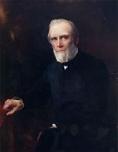
In 1650 Irish Archbishop James Ussher (Usher) (1581-1656) pub. Annals of the Old Testament, Deduced from the First Origins of the World: The Chronicle of Asiatic and Egyptian Matters Together Produced from the Beginning of Historical Time up to the Beginnings of Maccabees (Annales Veteris Testamenti, a Prima Mundi Origine Deductim, una cum rerum Asiaticarum et Aegyptiacarum chronico, a temporis historici principio usque ad Maccabaicorum initia producto), a 1.6K-page Latin tome that uses the Bible to date the creation of the world to nightfall (6:00 p.m.), Sunday, October 22, 4004 B.C., which jives with the Bible verse "One day is with the Lord as a thousand years, and a thousand years as one day" (2 Peter 3:8), meaning that Jehovah gave the Earth 6K years and it's running out fast; he dates the birth of Christ to 4 B.C.E.; it is later used in annotated eds. of the King James Bible, making it super-popular; by the late 19th cent. scientists and theologians begin to ditch it, with Am. Hebrew scholar Wiliam Henry Green (1825-1900) pub. the soundbyte in the influential article Primeval Chronology in Bibliotheca Sacra (1890): "We conclude that the Scriptures furnish no data for a chronological computation prior to the life of Abraham, and that the Mosaic records do not fix and were not intended to fix the precise date either of the Flood or of the creation of the world" - a Christian would say Sunday not Saturday or Friday?
On Feb. 24, 1652 the Act of Pardon and Oblivion is passed to reconcile English Royalists; on Aug. 12 Cromwell's Act of Settlement for Ireland exempts 80K rebels from pardon, esp. pesky James Butler, earl of Ormonde, forcing them to forfeit two-thirds of their lands and receive the third from a different part of the island than that in which they lived (Ormonde loses all of his?); their forfeited estates in Connacht are given to English settlers - Cromwell's crummy name burns in infamy in Ire Ire Ireland ever after?

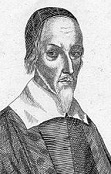
On Apr. 20, 1653 after hearing that they are seeking to remove him from power, Oliver Cromwell arrives in the Rump Parliament to observe it, wearing a plain black coat and gray worsted stockings; even though it fixes the date of its dissolution as next year, the impatient army, freshly returned from Ireland and Scotland forces his hand, and he dissolves it by force, telling it, "You are no Parliament... In the name of God, go!"; Cromwell then calls the Nominated Assembly (Little or Barebone's Parliament), named after Puritan member Praise-God Barebone (Barbon) (Barbone) (1598-1678), whose 140 members are elected by army officers, which meets on July 4 and lasts less than 6 mo. as everybody turns out to be a reforming fanatic; in despair, on Dec. 12 the Cromwellians in Parliament resign their powers to Cromwell, and on Dec. 16 the Instrument of Government, written by gen. John Lambert (1619-84) is adopted by Cromwell and his Council of Officers, becoming the first written constitution on Earth codifying sovereign powers until replaced in May 1657 by the Humble Petition and Advice); he takes the title of Lord Protector of the Repub. of England, Scotland, and Ireland (until Sept. 3, 1658), and becomes a constitutional king with a triennially elected parliament of 460 members (60 to be divided equally between Ireland and Scotland) that cannot be dissolved for 5 mo. and can pass a measure over the protector's veto by a simple majority, and which controls revenues; he has a cooperative council of 21, and a standing army of 30K; between sessions the protector and council can issue ordinances, but Parliament alone can grant supplies and levy taxes - so you might as well behave?

In 1655 Henry Cromwell (1628-74), Oliver Cromwell's 4th son becomes acting lord deputy of Ireland, then lord deputy in Nov. 1657 (until June 1657), slowing down the deportation of the Irish and acting impartially toward the different Protestant sects, becoming popular (for a Cromwell). After many years of plotting to take back Kent Island from Catholic Maryland, Jamestown Puritan leader William Claiborne defeats a force led by Md. gov. Stone in Providence (Annapolis), kills him, then takes control of Md., and travels to England to get official control, but they don't go for it and Sir George Calvert regains control; after the Puritan govt. in England is ousted in 1660, he finally gives up and contents himself with his little ole 5K-acre Romancoke estate on the York River in Va.
In 1662 a heart tax of 2 shillings is imposed in Ireland; it pisses people off so much that it is abolished in 1689.
In 1665 a match race is held at Sandymount in Dublin before a crowd of 5K and presided over by the Lord Deputy Essex, who awards a valuable plate to the winner.
In 1685 horse lover Charles II grants a royal charter to Down Royal (Downpatrick) Racecourse, and in 1690 the Byerley Turk wins a silver bell as a prize before going to fight in the Irish Wars.


In 1687: pop. of Ireland: 1.3M. In 1687 James II receives the papal nuncio, pissing-off the Protestant pop.; he creates his French-born illegitimate son (by Arabella Churchill, sister of the 1st Duke of Marlborough) James FitzJames (1670-1734) as duke of Berwick, and he goes on to become one of the top military strategists of his day; he appoints his brother-in-law Richard Talbot, 1st Earl of Tyrconnell (1630-91) as viceroy of Ireland, reversing Charles II's pro-Protestant policy and advancing Roman Catholics to state positions and giving them control of the militia, causing the Roman Catholic pop. to fall in love with him; when Tyrconnell tries to garrison some Catholic troops in Protestant-dominated Derry, the Young Apprentice Boys shut the gates to them.
On Mar. 14, 1689 a Scottish committee reestablishes Presbyterianism and abolishes the episcopacy again, but the Covenants are not revived, reducing the Covenanters to a small group of kilted die-hards; James II still has some fight in him, and calls on the Irish Catholics for support from his refuge in France, and they rally to his side, with the earl of Tyrconnell waiting with an Irish army as he arrives in Dublin with French gold and offices (incl. his son the duke of Berwick) and a declaration of war on Britain by Louis XIV, then establishes his HQ in Dublin, driving Protestant settlers from their homes into refuge in Londonderry and Enniskillen; on Apr. 13 after landing at Kinsale in S Ireland in Mar. with 2.5K men, James II begins the unsuccessful 105-day Siege of Derry (Londonderry) (ends July 28) after 13 apprentices close the city gates while the townsfolk shout "No surrender" and man the walls, becoming a symbol to Irish Protestants ever after, the city sporting dual Anglican and Roman Catholic cathedrals; after James is hampered by lack of artillery, the city is relieved from the sea, with the British navy killing 10K, after which the V is commemorated each Aug. in the Relief of Derry Celebration; meanwhile on May 7-July 20 the Irish Patriot Parliament of 1689, called by James II restores all lands confiscated since 1641, restores the Roman Catholic Church, and passes an act of attainder against pro-William partisans, all of which causes spooked Londoners to arm themselves and place candles in their windows for fear of an Irish invasion.


On June 14, 1690 new king of England, Scotland, and Ireland William III (William of Orange) (1650-1702) lands at Carrickfergus, then on July 1 routs deposed Roman Catholic king (1685-88) James II/IV (1633-1701) (who is supported by Louis XIV) at the Battle of the Boyne on the banks of the 70-mi.-long Boyne River (35K Protestants v. 25K Catholics), ending Roman Catholicism's final bid to become the official religion of Great Britain, causing James II to head to exile in France from Kinsale; on July 10 the French defeat the English and Dutch ships of the Grand Alliance in the naval Battle of Beachy Head, but it comes too late to keep William III from Ireland long enough for James II to organize his resistance; James Stuart sets a land-sea speed record boinging to France on July 4, believing his cause lost, giving a speech, but the Irish Catholics, who begin calling him "Jim Dung" fight on, and William holds a thanksgiving ceremony at St. Patrick's Cathedral in James' old HQ in Dublin; the Williamite V, being seen as a defeat for Louis XIV is welcomed by dope, er, Pope Alexander VIII; on July 12 Protestant Irish Orangemen celebrate the V; Dublin remains quietly under British control until 1798; one bright spot for the Irish Gaels, on Aug. 9-30 the Williamites siege Limerick, nd on the night of Aug. 10 Anglo-Norman Irishman Patrick Sarsfield, 1st Earl of Lucan (1660-91) and his Irish (Wild Geese) Brigade of 600 Irish exiles (formed in May when five Jacobite regiments were sent from Ireland to France in exchange for a larger force of French infantry) cross Ballyvalle Ford on the Shannon River to relieve the siege, brilliantly destroying William's heavy artillery, causing the siege to fail and William to leave Ireland on Sept. 5; on Sept. 28 after a siege the Duke of Marlborough pops, er, takes Cork, followed on Oct. 15 by Kinsale in S Ireland at the mouth of the Brandon River, and the Protestants begin their total political and economic control of Ireland, and the Huguenots begin migrating there (10K in the next decade).
In 1693 Virtue Rewarded, or the Irish Princess is pub. by anon., becoming the first Anglo-Irish novel?
In 1703 the Popery (Gavelkind) Act is passed by the British Parliament, modifying the Irish practice of Gavelkind (equal division of land among a dead landholder's sons, also used by the Jutes in Kent), giving all the land to the eldest son if he converts to Protestantism; land holdings by Irish Catholics shrink from 35% in 1688 to 14% in 1704 to 5% in 1776.
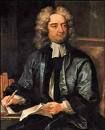
In 1704 Dublin-born Anglo-Irish writer Jonathan Swift (1667-1745) pub. A Tale of a Tub, his first major work, pub. anon., a satire about three brothers, each representing a major branch of Christianity; despite getting his cousin Thomas to claim authorship, it damages his prospects in the Church of England; "Seamen have a custom, when they meet a whale, to fling him out an empty tub by way of amusement, to divert him from laying violent hands upon the ship"; "There are certain common privileges of a writer, the benefit whereof, I hope, there will be no reason to doubt; particularly, that where I am not understood, it shall be concluded, that something very useful and profound is couched underneath; and again, that whatever word or sentence is printed in a different character, shall be judged to contain something extraordinary either or wit of sublime"; "Bread is the staff of life"; "Books, the children of the brain"; "As boys do sparrows, with flinging salt upon their tails"; "He made it a part of his religion never to say grace to his meat"; "It is a maxim, that those to whom everybody allows the second place have an undoubted title to the first." In 1726 he pub. Gulliver's Travels (Travels into Several Remote Nations of the World, in Four Parts, By Lemuel Gulliver, First a Surgeon, and then a Captain of Several Ships); Lemuel Gulliver visits the countries of Lilliput and Blefuscu (6-in. tall people, Lilliput's capital city Mildendo is surrounded by a 2.5-ft. wall), Brobdingnag (60-ft. tall giants), Laputa (flying island of scientific quacks), Glubdubdrib (sorcerers), Luggnag (island where the Stuldbrugs live forever while suffering the infirmities of old age), the land of the Houyhnhnms, where intelligent horses rule over savage humanoid Yahoos, and Balnibarbi (failed inventors and projectors, capital Lagado); a satire of all things English, or just English modernism?; "If I had to make a list of six books which were to be preserved when all others were destroyed, I would certainly put 'Gulliver's Travels' among them" (George Orwell); "He [the emperor of Lilliput] is taller by almost the breadth of my nail, than any of his court, which alone is enough to strike an awe into the beholders"; "I cannot but conclude the bulk of your natives [Brobdingnag] to be the most pernicious race of little odious vermin that nature ever suffered to crawl upon the surface of the earth"; "He had been eight years upon a project for extracting sunbeams out of cucumbers, which were to be put in vials hermetically sealed, and let out to warm the air in raw inclement summers [Laputa]"; "I said the thing which was not. (For they have no word in their language to express lying or falsehood.) [Houyhnhnms]"; "Poor Nations are hungry, and rich Nations are proud, and Pride and Hunger will ever be at Variance [Houyhnhnms]"; "And he gave it for his opinion, that whosoever could make two ears of corn or two blades of grass to grow upon a spot of ground where only one grew before, would deserve better of mankind, and do more essential service to his country, than the whole race of politicians put together."
In 1726 the first written reference to shamrocks being worn on St. Patrick's Day appears in the diary of a traveling Protestant minister, "...it being a Current Tradition, that by this Three Leafed Grass, he emblematically set forth to them the Mystery of the Holy Trinity".
In 1739 500K die in Ireland this year and next because of a potato crop failure coupled with extremely cold winters - the woes of a 1-crop economy?
In 1740-1 (Year of Slaughter) extreme winters and bad potato and grain harvests cause widespread famine in Ireland, killing 300K-480K out of 2.4M (13%-20%); too bad, the Irish only become more reliant on potatoes, setting themselves up for regular famines?
In 1741 in Ireland regular horseracing begins at the Curragh Racetrack in County Kildare, which claims to have hosted chariot races in the 3rd cent. C.E., and which becomes the center of Irish flat racing.
In Nov. 1749 the Sportsmen of the Curragh are formed in the Rose and Bottle in Dame St., Dublin, which becomes the Turf Club in 1790.
In 1752 the Steeplechase allegedly originates in Doneraile, Cork, Ireland when Cornelius O'Callaghan and Edmund Blake race between Buttevant Church and St. Leger Church, which were 4 mi. apart and just close enough to see the steeple if they went in a straight line and jumped over fences, gates, streams etc.

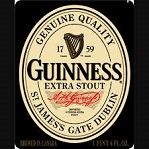
On Dec. 31, 1759 after hops are introduced to Ireland, and his godfather Archbishop of Cashel (since 1744) Arthur Price (1678-1752) leaves him £100 in his will in 1752, which he uses in 1755 to buy a brewery at Leixlip (10 mi. from Dublin) at the confluences of the Liffey and Rye Water Rivers, Sir Arthur Guinness (1725-1803) founds the Guinness Brewery at St. James' Gate in Dublin, Ireland, and secures a modest 9K-year lease at £45/year; the logo features an Irish harp; at first only ales are produced; in 1760 the thermometer is introduced to control quality, followed by the hydrometer in 1770; on May 19, 1769 the first ale is exported, 6-1/2 barrels to Britain; in 1778 the first well-hopped brown malt porter is introduced, evolving into single stout, double stout, and the the main product Guinness Extra Stout; in 1801 extra-hoppy Guinness Foreign Extra Stout is first produced for export; during the Napoleonic War (1803-15), a malt tax is passed, causing less malt to be used; in 1816 a law is passed controlling purity, mandating that only malt and hops be used in beer production; in 1817 black patent malt (kilned at 200C) is invented by Daniel Wheeler, which makes it possible to use up to 95% cheaper pale malt to obtain the required flavor; about 1800 it is discovered that aged porter (6-18 mo. old) can be diluted 2:1 with young porter and still be accepted by consumers; after Guinness and several other brewers and distillers are raised to the peerage, they become known as the Beerage; in 1932 the HQ is moved to London; in 1960 they introduce Harp Lager; in 1997 it merges with Grand Metropolitan to form Diageo; by 2016 stout accounts for 34% of the beer market in Ireland, with lager at 60% and ale at 6%.
In Feb. 1760 the Battle of Carrickfergus in Ireland sees 400 French troops under privateer Francois Thurot land and capture of the castle of Carrickfergus, Ireland, holding the town for five days until a British navy squadron arrives, after which Turot becomes a French nat. hero for his daring and pluck.
In 1782 after 80K Irish Protestants form volunteer militias under a pretext of defending Ireland from the French, they demand legislative independence for Ireland, and on a motion of Charles Fox the British Grattan's Parliament passes the Constitution of 1782), freeing the Irish Parliament of legal restrictions imposed by the anti-Catholic Poyning's Laws of 1494-5; too bad, the Irish Parliament is still all Protestant, and refuses to extend suffrage to Catholics, and after the 1798 United Irishmen Uprising the Parliament of Ireland is abolished and the kingdom of Ireland is absorbed into Britain.
In 1783 Waterford, Ireland begins manufacturing crystal, which becomes world famous.


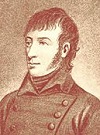

In July 1791 Irish sympathy for the French Rev. results in 6K in "Athens of the North" Belfast voting a congratulatory message to the French nation; meanwhile on Oct. 18 after pub. "Argument on Behalf of the Catholics of Ireland", Dublin-born ("Father of Irish Republicans") Theobald Wolfe Tone (1763-98), along with Dublin-born James Napper Tandy (1740-1803), County Cork-born Thomas Paliser Russell (1767-1803), and London-born Archibald Hamilton Rowan (1751-1834) found the Society of the United Irishmen in Dublin (until 1804), with the aims of union among the Irish people, constitutional reform, and removal of all religious disqualifications; it is soon outlawed.
In Dec. 1796 the Expédition d'Irlande (French expedition to Ireland) sees the French Dir. of the First French Repub. send 15K soldiers from Brest under Gen. Lazare Hoche to attempt a landing in Bantry Bay, Ireland to support the outlawed Society of United Irishmen; too bad, winter storms cause the fleet to break up and return to Brest through British-infested waters; a 2nd landing is attempted in Aug. 1798 with 2K men, but it also becomes a dud.
On Jan. 13, 1797 the Action of Jan. 1797 sees two British frigates engage the 74-gun French line ship Droits de L'Homme from the Expedition d'Irlande for 15 hours in bad weather off the coast of Brittany until it is swept onto a sandbar and destroyed.



The not so soft goodbye in Fireland? On Feb. 19, 1798 the unsuccessful 1798 Irish (United Irishmen) Ruction (Rebellion) (excuse me?), led by the Society of United Irishmen and modeled on the French Rev. starts in Leinster, then spreads, with a rising of poorly-armed peasants in Wexford; British redcoats aided by Hessian mercentaries defeat them on June 21 in the Battle of Vinegar Hill; on May 24 (1:00 a.m.) the Battle of Ballymore-Eustace in Ballymore Eustace in County Kildare, Ireland near the Kildare-Wicklow border starts with a surprise-attack by 500 United Irish rebels on a 50-man loyalist militia led by Capt. Beevor is turned around in two hours, with 100 rebels KIA vs. 12 militia KIA and five wounded; on May 26, 1798 the Dunlavin Green Executions see 36 rebel POWs summarily executed in County Wicklow by the British via firing squad for fear of a possible rebel attack; meanwhile on Aug. 22 a French force of 1,070 under United Irishmen leader Gen. Jean Joseph Amable Humbert (1767-1823) lands in Kilcummin in Killala Bay on the W coast to help them; on Aug. 27 the Battle of Castlebar (Castlebar Races) sees a 2K-man combined French-Irish force under Gen. Humbert defeat a 6K-man British force under Gerard Lake, after which Gen. Humbert proclaims the Repub. of Connacht, with John Moore (1763-99) (descendant of St. Thomas More) as pres. #1; too bad, Humbert arrives too late, and on Sept. 8 26K British forces arrive, decisively defeating the 2,350 rebels at the Battle of Ballinamuck, with 500 rebels KIA, 1,144 captured, and 200 executed vs. 12 British KIA and 16 wounded, and the rebellion is quashed by Sept. 24;Moore is captured in Castlebar by Lt.-Col. Crawford, and after "lenity" by Lord Cornwallis he is sentenced to transportation to New Geneva, dying in Waterford, where he is buried in Ballygunner Temple, his grave rediscovered in 1960, and his remains exhumed and returned to Castlebar on Aug. 12, 1961, where a state funeral is held attended by Pres. Eamon de Valera; the gaseous nature of the revolt causes the word "ruction" to be coined; British secy. for Ireland (since 1797) Robert Stewart, Viscount Castlereagh (1769-1822) (an Ulster Protestant) offers clemency to commoners supporting the ruction, and focuses on punishing the leaders; after the English stop an Irish attempt to seize Dublin, all of Ireland becomes an English garrison run from Dublin Castle, while the Irish pop. is at the mercy of a debauched landlord class with the power of judge, jury, and executioner or transporter of the "tenants", sending hundreds, incl. Presbyterian ministers and professionals without trial or charges to life imprisonment in Australia, where the "rebels of 1798" face inhuman conditions and vicious flogging, all the more because of their intelligence?; the lucky ones begin emigrating to Canada; Irish PM (since 1782) (a liberal Protestant with Catholic sympathies) John Philpot Curran (1750-1817) vigorously defends Society of United Irishmen founder Archibald Hamilton Rowan (1751-1834) and other ruction leaders, gaining a good rep., ending with the defense of Napper Tandy in 1800; meanwhile British PM Pitt sees the ruction as proof of the need for a union of the two countries - some sneak to New Orleans to drink Hand Grenades?
On July 2, 1800 after British PM William Pitt the Younger spreads the money and patronage around, the Acts of Union, sponsored by ruction-crushing Viscount Castlereagh are enacted, uniting Great Britain with Ireland as the United Kingdom (U.K.), effective next Jan. 1.


On Jan. 1, 1801 the 1800 Acts of Union with Ireland come into effect, dissolving the Irish Parliament, giving it 32 peers in the British House of Lords and 100 members of the House of Commons, with the new U.K. Parliament meeting on Jan. 22; English king (since Oct. 25, 1760) George III (1738-1820) becomes king of the United Kingdom of Great Britain and Ireland (until Jan. 29, 1829); his wife (since Sept. 8, 1761) Charlotte of Mecklenburg-Strelitz (1744-1818) becomes queen, adding the title to electress of Hanover of the HRE until her hubby is promoted to king of Hanover on Oct. 12, 1814, allowing the Christmas tree to be introduced to England; in Aug. Britain officially becomes the United Kingdom of Great Britain and Ireland, with the Union Jack as its official flag; Ireland's parliament is dissolved, and the Irish are forced to elect reps. to the British Parliament; Ireland begins to be all about nationalist movements springing up to get it repealed and regain home rule, lasting well into the 20th cent.
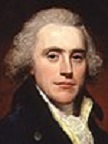
On Mar. 14, 1801 British PM (since Dec. 19, 1783) William Pitt the Younger (1759-1806) resigns along with Viscount Castlereagh when George III rejects his plans for linking the Act of Union with Ireland with the emancipation of Irish Catholics, and approaches anti-emancipationist Henry Addington (1757-1844) about replacing him as PM, becoming British PM on Mar. 17 (until May 10, 1804).



On July 23, 1803 the Society of United Irishmen, led by "the Irish Patriot" Robert Emmet (1778-1803) stage the disastrous poorly-planned Insurrection (Rebellion) of 1803 in Dublin, which is suppressed by English CIC in Ireland gen. Henry Edward Fox (1755-1811) who got rich as paymaster gen. in the Seven Years' War); on Oct. 21 United Irishmen leader Thomas Paliser Russell (1767-1803) is hanged and beheaded in Downpatrick Gaol; on Sept. 20 after telling his judges "Let no man write my epitaph", Emmett is hanged, drawn, and quartered in front of St. Catherine's Church on Thomas St. in Dublin after being held in the new Kilmainham Gaol (built 1796) in Dublin, which becomes infamous for maltreatment of prisoners, with men, women, and children not segregated and forced to live most of the time in the dark; more Irish are transported from Spike Island Prison in beautiful Cork harbor to Botany Bay to face cruel Gov. Captain William Bligh of "Mutiny on the Bounty" fame, incl. Michael Dwyer (1772-1825) of County Wicklow and his comrades Hugh Byrne, Martin Bourke and Arthur Devlin; at least the first Roman Catholic masses are permitted there by the "No Popery" Brits on the site of the future (1844) Church of St. Patrick in Sydney.

In 1805 County Meath, Ireland-born hydrographer and British rear adm. Sir Francis Beaufort (1774-1857) devises the Blowfart, er, Beaufort Wind Scale (0-12) for gauging wind force at sea: 0:0-1 mph (calm), 1:2-3 (light air), 2:4-7 (slight breeze), 3:8-12 (gentle breeze), 4:13-18 (moderate breeze), 5:19-24 (fresh breeze), 6:25-31 (strong breeze), 7:32-38 (moderate gale), 8:39-46 (fresh gale), 9:47-54 (strong gale), 10:55-63 (whole gale), 11:64-72 (storm), 12:73-82 (hurricane).

On May 5, 1823 the Roman Catholic Catholic Assoc. is founded in Ireland by Daniel O'Connell (1775-1847) ("the Liberator") ("the Emancipator") to fight for their free-ee-ee-doms, demanding complete Roman Catholic emancipation from Protestant England and justice for Ireland, organizing large-scale public protests in Ireland, becoming one of the first mass-membership political movements in Europe, scaring British home secy. Robert Peel, who utters the 1824 soundbyte: "We cannot tamely sit by while the danger is hourly increasing, while a power co-ordinate with that of the Government is rising by its side, nay, daily counteracting its views", and the Duke of Wellington to utter the soundbyte: "If we cannot get rid of the Catholic Association, we must look to civil war in Ireland sooner or later"; too bad, after they turn to the Tories to stop Catholic Emancipation, only to find that the Ultra-Tories faction is kaput, Danny wins the day - erin go bragh?
On July 5, 1828 after the exit of the liberal Tories from Wellington's cabinet creates the need for the election of a successor in County Clare in Ireland, he is defeated by Daniel O'Connell, who is barred from sitting in the English Parliament because he is a Roman Catholic; this puts pressure on Wellington to restore the rights of the Irish Roman Catholics, who have been fuming ever since the Act of Union in 1801, and they are finally permitted to hold local office.
On Apr. 13, 1829 after the threat of civil unrest led by Irish atty. Daniel O'Connell makes home secy. Robert "Orange Peel" Peel and PM the Duke of Wellington to give in, the Roman Catholic Relief (Emancipation) Act is given royal assent, repealing the 1672 Test Act and the Penal Laws resulting from the 1728 Irish Parliament Disenfranchising Act, granting emancipation to Roman Catholics in Britain, calming the Irish down by letting Roman Catholics sit in the British Parliament, although property reqts. (10 pounds instead of 40 shillings) for the counties greatly reduce the number of eligible Irish Catholic voters; the action, thought necessary to avoid a civil war is unpopular with the king and the English public, causing Wellington's admin. to tank; all 15 economists in Parliament vote to allow Roman Catholic MPs; meanwhile the Irish are still pissed off-for having to pay tithes to the Anglican Church in Ireland, forming the Ribbon Society to agitate against Orangemen.
In 1830 the Ulster Gaelic Society is founded in Northern Ireland, launching the Gaelic Revival.

On Mar. 29, 1839 the Young Ireland movement is founded by Protestant Thomas Osborne Davis (1814-45) at a meeting of the College Historical Society in Dublin, promoting Irish nationalism along with Catholic-Protestant unity, with the soundbyte: "The country of our birth, our educations, our recollections, ancestral, personal, national; the country of our loves, our friendships, our hopes; our country: the cosmopolite is unnatural, base - I would fain say, impossible. To act on a world is for those above it, not of it. Patriotism is human philanthropy"; he goes on to compose the influential song A Nation Once Again (July 13, 1844).
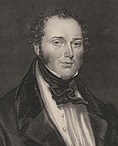
In June 1839 after Protestant Irish (Cork) MP (since 1832) Feargus Edward O'Connor (1796-1855) is unseated in 1835 for failing to meet property qualifications, pissing him off and causing him to start the Nat. Land Co. (Land Plan), a reform movement to give small landholdings to laoborers, the First Chartist Petition (first pub. in May 1838) is presented to Parliament along with 1.25M signatures, calling for universal male suffrage without a property requirement, salaries for MPs, annual gen. elections and secret ballot, getting the nat. working class Chartist Movement in Britain off to a bang, garnering 1,283K signatures; too bad, they reject it by 235-46, after which many leaders are arrested for calling a gen. strike, and O'Connor gives his Manchester Speech, threatening violence on Sept. 29 if the demands are not met, causing 3K demonstrators led by John Frost (1784-1877) of Blackwood, Caerphilly to march on Newport Prison in Monmouthshire on Nov. 4, hoping to spark a Britain-wide revolt against the govt. and gentry, which the govt. answers by firing on the crowd, killing 24 and wounding 40 - you have no more rights than crap in a toilet in Britain?
On Oct. 15, 1842 (Sat.) The Nation, official organ of the Young Ireland Movement begins pub. in Dublin, advocating "defensive physical force" against the govt. when necessary, causing a split with Daniel O'Connell's Repeal Assoc. in 1846; cooperation with Protestant leaders and Young Italy results in opposition by Pope Gregory XVI; it is shut down by the govt. on July 28, 1848, then revived in Sept. 1849 (until 1900).
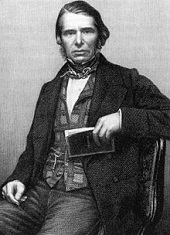
In 1845: Pop. of Ireland: 8M (vs. 4M in 1800, and 6M in 1850); Potato Late Blight (Phytophthora infestans) imported from the Americas infects potato crops in Ireland, which, combined with the prior reduction from four potato varieties (Black, Apple, Cup, Lumper) to one (Lumper, the least tasty, but most prolific) causes starvation to a large portion of the Irish this autumn and next winter, causing 32K to migrate to Quebec (70K more next year) in "coffin ships", dying of cholera and being buried in mass graves on shore; the avg. Irish person consumes 10 (70?) potatoes a day; there are 65K Irish potato farms of an acre or less; total potato acrage: 6M; total potato production: 15M tons/year, reduced 90% by the famine; British civil servant Sir Charles Edward Trevelyan, 1st Baronet (1807-86), in charge of famine relief slows it down because of hatred of the Irish, claiming he didn't want laissez-faire interfered with while making sure that Irish oats and grain depart on schedule for England despite the Irish starving and sometimes losing their lives trying to seize grain ships, earning their everlasting hatred esp. after he is knighted for it; PM Peel (Potato Peel?) proposes repeal of the Corn Law and importation of Indian corn to make food as cheap as possible, but his cabinet refuses to support him, so he resigns; attempts of Lord John Russell to form a Whig cabinet fail, and Peel returns with a new cabinet pledged to the repeal of the Corn Law.
In 1846 famine strikes Europe (until 1847); an economic depression caused by the potato blight (Phytophthora infestans) and other crop failures strikes France (until 1847); all of this creates good hunting for revolutionary recruiters; the Great Irish Potato Famine (Hunger) in Ireland (1845-9) results from the total failure of the potato crop after an exceptionally warm winter (Jan.-Feb.), halving the 8M pop. by 1848, with 1847 (Black '47) being the worst; about 1M die and another 1M emigrate, with the eager assistance of the Roman Catholic-hating English landlords, esp. in County Cork, who forcibly remove whole towns and villages of "disaffected" tenants, incl. Lord Kingston of Fermoy, Stephen Moore, 3rd Earl Mount Cashell (Lord Kilworth) (1792-1883), Lord Doneraile, and Baron Ennismore (Earl of Listowel), packing them off in ships for Quebec, where most die from starvation, smallpox, and typhus on the journey, and those who arrive have to clear forest and build log cabins when they have never used an axe before; others, mainly from Munster and Connacht become navvies working on canals and railroads; Ottoman sultan (1839-61) Abdul Mecid I tries to send 10K sterling to the Irish, but Queen Victoria tells him to only send 1K because she sent only 2K, which doesn't stop him from sending three ships of food to Drogheda - Jesus what?
In 1847 after surviving the Trail of Tears, the Choctaw Nation in Okla. collects donations and sends $5K (modern-day) to Middleton (S of Dublin), County Cork, Ireland to aid them during the Potato Famine; in 1995 Irisih pres. Mary Robinson visits them to thank them; in 2017 the sculpture "Kindred Spirits" is erected in their honor.


A duck, a hen, a cuckoo and a nightingale, with more birds to come, robins and larks? In July 1848 the Young Ireland Movement starts an unsuccessful rising in famine-depleted Ireland; this time the rebels come from the middle class, and the leader is lawyer-journalist John Mitchel (1815-75), ed. of The Nation and The United Irishman, who is railroaded to 14 years in Van Dieman's Land (Tasmania) for "felony treason" for his writings, is given a "ticket of leave" in Bothwell (46 mi. from Hobart Town), where he begins his Jail Journal: Five Years in British Prisons, escaping to the U.S. in 1853, returning to Ireland in 1874 and getting elected as MP for Tipperary, then refused his seat because he is a convicted escaped felon; novelist Charles Joseph Kickham (1828-82) lucks out this time, but gets 14 years in 1865, and is pardoned in 1869, sticking to lit. work afterward.

In 1856 after joining the Anglo-Catholic Oxford Movement and becoming an Anglican deacon in 1844, then making friends with Thomas Carlyle, who turns him anticlerical and gets him to withdraw from the ministry in 1872 after pub. the scandalous novel The Nemesis of Faith (1849), Dartington, Devon-born historian James Anthony Froude (1818-94) begin pub. History of England from the Fall of Wolsey to the Death of Elizabeth (12 vols.) (1856-70) (rev. ed. 1893), which rehabilitates Henry VIII and treats history as a drama, sans scientific or other theories, except when he touts the Protestant Reformation as "the root and source of the expansive force which has spread the Anglo-Saxon race throughout the globe", making him a controversial star. In 1872 he begins pub. The English in Ireland in the Eighteenth Century (3 vols.) (1872-4), explaining why it is futile for the English to conciliate the Irish because they're priest-ridden, and what they need is "enlightened despotism", thus all them English atrocities by Oliver Cromwell et al. were well deserved, pissing-off Irish historian William Edward Hartpole Lecky et al. In 1879 he pub. Caesar: A Sketch, followed by Bunyan (1880). In 1881 he ed. Thomas Carlyle's Reminiscences. In 1882-4 he pub. Thomas Carlyle (2 vols.), incl. "A History of the First Forty Years of His Life", and "A History of His Life in London, 1834-1881", which causes a war with Carlyle's niece Mrs. Alexander Carlyle, who doesn't want his dirty laundry aired. In 1883 he pub. Luther: A Short Biography, followed by Oceana, or, England and Her Colonies (1886). In 1888 he pub. The English in the West Indies: Or, The Bow of Ulysses, which disses the British West Indian colonies for wanting self-govt., claiming that the black pop. will elect leaders who will repress the white pop., pissing-off Trinidadian writer J.J. (John Jacob) Thomas (1841-89), who pub. Froudacity: West Indian Fables by James Anthony Froude in 1889 before dying of pneumonia. In 1890 he pub. The Earl of Beaconsfield, followed by The Divorce of Catherine of Aragon (1891). In 1892 he becomes Regius Prof. of Modern History at Oxford U.
In 1860: Pop.: Russia: 76M, Italy: 25M, Britain: 23M; Ireland: 5.7M; New York City: 805K; before-the-wind Atlanta, Ga.: 9,554.
On Aug. 22-29, 1861 Queen Victoria visits Ireland along with Prince Albert and three of their nine children, landing in Kingstown (modern-day Dun Laoghaire); on Aug. 23 Prince Albert visits his eldest son Prince Edward of Wales in Curragh where he is undergoing military training; on Aug. 24 they visit Killarney where they are greeted by 10K, turning it into a tourist attraction; on Aug. 25 they go boating accompanied by 800 boats; too bad, Prince Edward is introduced to mistress Nellie Clifton at Curragh, hooking up with her again at Cambridge U., pissing-off his father and contributing to his death from typhus, causing Victoria to blame him, with the soundbyte: "I never can or shall look at him without a shudder."
In 1861 the U.K. Offences Against the Person Act is passed, making abortion a criminal offense in Ireland (until Jan. 1, 2019) - a case of their British masters using their Catholic religion against them?




On Mar. 5, 1867 the Fenian Rising in Ireland by the secret Invincibles society begins in Dublin and Kerry, and is stopped by the Irish Constabulary; in Sept. Col. Thomas Joseph Kelly (1833-1908), English leader of the Finians is arrested, and a rescue attempt kills a policeman while attempting to shoot off the lock of the van; Kelly escapes to the U.S., but three Fenians (Allen, Larkin and O'Brien) are railroaded and hanged on Nov. 23 for it, becoming known as the Manchester Martyrs; on Mar. 29 after the Fenian invasion scares them into it, the British Parliament passes the British North America Act, creating the Dominion of Canada on July 1, with the E provinces of Ontario, Quebec, New Brunswick, and Nova Scotia uniting to offset the threat of a U.S. invasion from the S; eventually 10 provinces (Alberta, British Columbia, Manitoba, New Brunswick, Newfoundland, Nova Scotia, Ontario, Prince Edward Island, Quebec, Saskatechewan) and two territories (Northwest Territories and Yukon) join; Glasgow, Scotland-born Conservative Sir John Alexander Macdonald (1815-91) becomes PM #1 of Canada (until Nov. 5, 1873), and Templemore, Ireland-born Charles Stanley Monck, 1st Viscount Monck (1819-94) (gov.-gen. of the Province of Canada since 1861) becomes gov.-gen. #1 (until Nov. 14, 1868); to induce British Columbia to join, the Canadian Parliament guarantees a transcontinental railroad within 10 years, promising 25M acres of western land, a 20-year tax exemption, and other guarantees to six millionaires in exchange for $25M, creating the Canadian Pacific Railroad, which takes until 1885 to finish; Scottish-born Toronto Globe founder George Brown (1818-80) is instrumental in leading the Reform Party to push the confederation.


On Apr. 21, 1875 Avondale, County Wicklow-born Charles Stuart (Stewart) Parnell (1841-91) enters the British House of Commons for Meath at age 29, and quickly establishes a rep. for being anti anything English, and head of the Home Rule lobbyists, followed by pres. of the Nationalist Party in 1877, and leader of the Irish Parliamentary Party in 1882-91, becoming a hero and "uncrowned king of Ireland" to the Irish masses, who treat him like a Messianic figure, kissing his hands and knees and trying to touch his clothes; too bad, he gets involved in a divorce in 1890, pissing-off the good Roman Catholics, who had up till then ignored the fact that he was Protestant, causing him to die an early death in 1891; meanwhile in 1878 the Irish Nat. Land League, founded by Parnell and ex-Fenian Michael Davitt (1846-1906) in favor of poor tenant farmers against landlordism starts a boycott of English goods and English landlords, holding "monster meetings" to protest the stankin' English, with the motto "Fair rent, free sale, fixity of tenure" (3Fs).
In 1880 the Free Mash-Tun (Inland Revenue) Act is passed in Britain, changing the taxation emphasis from malt to beer, removing the 1660 tax on malted barley and leaving brewers free to use other ingredients, incl. sugar in England and unmalted barley in Ireland.

In 1880 Thomas Power "Tay Pay" O'Connor (1848-1929) of Charles Stewart Parnell's Home Rule League is elected as a British MP for Galway, going on in 1885 to become the first Irishman to be elected to sit for an English borough outside Ireland (Liverpool), remaining in office for 49 years 215 days, becoming known as "Father of the House of Commons".
In Apr.-May 1882 after the English press reveals that his mistress had borne him children, Charles Stuart Parnell cops out and signs the Kilmainham Agreement (Treaty) in order to gain release from Kilmainham Jail, going back to working for Home Rule for Ireland; too bad, on May 6 the Fenians murder chief British secy. for Ireland, Lord Frederick Charles Cavendish (b. 1836) and his undersecy. Thomas Henry Burke (b. 1829) in Phoenix Park in Dublin in protest against the Coercion Act of 1881, and on Aug. 17 the Maamtrasna Murders of John Joyce and four members of his family take place, after which innocent non-English-speaking man Maolra Seoighe is hanged and four other innocent men jailed for life; Parnell distances himself from the radical Irish Nat. League and seems to be on the way to his dream until the Times of London pub. a forged letter in which he allegedly supports the murders, setting him back by making him fight it out in court to clear his name while Irish Home Rule goes down in Parliament; meanwhile the British respond by passing the Crimes Act of 1887, making the Coercion Act even more stringent.
In 1882 The British Parliament enacts its first rule of cloture in order to silence pesky Irish Home Rule MPs, with 40 MPs being able to request the speaker to close debate; in 1887 this is changed to 200 MPs, or 100 MPs if the other side has less than 40 MPs.

On Apr. 8, 1886 British Liberal PM (since Feb. 1) William Ewart Gladstone (1809-98) formally introduces the First Home Rule (Irish Govt.) Bill (first attempt to give Irish affairs over to the Irish people), giving the Irish Parliament the right to appoint the executive of Ireland, but reserving taxing power to the British Parliament; Charles Stuart Parnell supports the bill, but there is great opposition in both Ulster (N Ireland) and England, and on June 8 it is defeated in the House of Commons by 341-311, although Parnell's party stays optimistic; the Liberal Party is split asunder, and PM William Gladstone resigns on July 20; the predominantly Conservative Tory coalition Unionist govt. takes over, with the Marquess of Salisbury returning as PM on July 25 (until Aug. 11, 1892), pumping up their policy of gung-ho pip-pip bloody-bloody Empire On Which the Sun Never Sets imperialism, with the mottoes "Splendid Isolation" and "Fight Home Rule With Kindness"; in the face of this bastion of aristocratic conservatism Gladstone remains foreign secy. instead of becoming first lord of the treasury like most PMs do, and doesn't struggle back to power for six years (Aug. 15, 1892).
In the 1890s the Irish Lit. Revival (Celtic Twilight) accompanies the growth of Irish nationalism, with major figures incl. William Butler Yeats, James Clarence Mangan, Samuel Ferguson, Douglas Hyde, William Rooney, and Arthur Griffith.
In fall 1891 the British Liberal Caucus proposes the unified Newcastle Reform Program, incl. Home Rule and electoral reform. On Oct. 6, 1891 Irish nationalist leader Charles Stuart Parnell (b. 1846) dies in Brighton, England (of a broken heart?); 150K attend his funderal at Glasnevin Cemetery; Oct. 6 becomes Ivy Day, when Irish Home Rule supporters wear a sprig of you know what in their clothing.
In 1891 the first lager beer brewery in Ireland is established in Dartry, Dublin.
On July 4-26, 1892 after Lord Salisbury dissolves the English Parliament, the gen. election leaves the Conservatives with the greatest number of seats, but still in a minority against the combined Liberals and Irish Nationalists (Home Rulers), even though the latter are split into pro and anti Parnell factions; Salisbury resigns, and William Gladstone becomes PM again and forms his 4th cabinet, dependent on Irish Nationalist support, which tries in vain to implement the Newcastle Program.
On Apr. 21, 1893 PM William Gladstone's Govt. of Ireland Bill 1893 (Second Home Rule Bill) is approved 347-304 by the House of Commons, but fails by 41-419 in the House of Lords.


On July 31, 1893 the Gaelic League (Conradh na Gaelige) is founded in Dublin, Ireland by Douglas Ross Hyde (1860-1949) and Eoin MacNeill (1867-1945) to promote Irish language, history, and culture, going on to pub. Gaelic Journal and spearhead the Gaelic Revival, which began with the formation of the Ulster Gaelic Society in 1830.

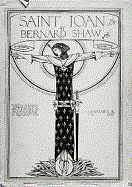
In 1893 after going Socialist and joining the Fabian Society, Portobello, Dublin-born Irish playwright George Bernard Shaw (1856-1950) writes the play Mrs. Warren's Profession, based on his 1882 novel "Cashel Byron's Profession", about a middle-aged English madame and her prudish Cambridge-educated daughter Vivie, who discovers how mommy's fortune was made, forgives her since it saved her from poverty, then is shocked to find out that she's still a madame; after a fight with the British censors, he gets it performed on Jan. 5, 1902 at the members-only New Lyric Club, but when he gets it produced in New York City in 1905, Anthony Comstock calls the pigs on it, getting it closed after one perf., calling him an "Irish smut dealer", to which Shaw replies "Comstockery is the world's standing joke at the expense of the United States. Europe likes to hear of such things. It confirms the deep-seated conviction of the Old World that America is a provincial place, a second-rate country-town civilization after all"; it is not shown publicly in England until 1925. In 1893 Shaw also writes the play The Philanderer, which is not pub. until 1898 and not staged until Feb. 20, 1905. On Apr. 21, 1894 Shaw debuts his play Arms and the Man at the Avenue Theatre in West End, London, followed by Herald Square Theatre in New York on Sept. 17, becoming his first success; title comes from Virgil's "Aeneid" ("Arma virumque cano" - Of arms and the man I sing); influenced by Henrik Ibsen; seeks to introduce a new realism into English drama, attempting to show the futility of war; set during the 1885 Serbo-Bulgarian War; Bulgarian woman Raina Petkoff is engaged to war hero Sergius Saranoff until she falls for Swiss mercenary soldier in the Serbian army Capt. Bluntschli, "my chocolate-cream soldier"; filmed in 1932 and 1958. On May 23, 1905 Shaw debuts his drama Man and Superman at the Royal Court Theatre in London; written in 1903; Mr. Whitefield dies, leaving his daughter Ann (Lilah McCarthy) in the care of old Roebuck Ramsden and young stud John "Jack" Tanner (Harley Granville Barker), author of "The Revolutionist's Handbook and Pocket Companion", who "is prodigiously fluent of speech, restless, excitable (mark the snorting nostril and the restless blue eye, just the thirty-secondth of an inch too wide open), possibly a little mad", who tries unsuccessfully to inculcate his rev. beliefs in her, but ends up getting pussy-whipped and marrying him, beating out suitor Octavius Robinson; incl. the seemingly extraneous 3rd act "Don Juan in Hell", in which Don Juan is the quarry not the hunter, and which is not staged until June 4, 1907. On Oct. 16, 1913 Shaw debuts his play George Bernard Shaw (1856-1950), Pygmalion at the Hofburg Theatre in Vienna, followed by the Irving Place Theatre in New York on Mar. 24, 1914, and His Majesty's Theatre in London on Apr. 11, 1914 (118 perf.); based on the Greek myth of Pygmalion of Cyprus, who fell in love with a statue he sculpted; stars Mrs. Patrick Campbell (1865-1940) as Cockney flower girl Eliza Doolittle, whom he wrote the part for, who might have been based on Alexander Graham Bell's father Alexander Melville Bell (1819-1905); later made into the musical "My Fair Lady" (1956); fear of ridicule causes him to debut it in German in Vienna, after which he gets braver and debuts it in New York (in German) followed by London; "The English have no respect for their language, and will not teach their children to speak it." (preface) On Dec. 28, 1923 Shaw debuts his play Saint Joan at the Garrick Theatre in New York, followed by New Theatre in West End, London on Mar. 26, 1924, about the life of Joan of Arc (1412-31); his only tragedy?; debuts three years after her canonization (May 16, 1920); "A tragedy without villains" (Michael Holroyd); stars Agnes Sybil Thorndike (1882-1976), for whom the role was designed, and she performs in the role repeatedly until 1941; musical score by John Foulds; filmed in 1927 starring Sybil Thorndike, and in 1957 starring Jean Seberg; "There are no villains in the piece. Crime, like disease, is not interesting: it is something to be done away with by general consent, and that is all about it. It is what men do at their best, with good intentions, and what normal men and women find that they must and will do in spite of their intentions, that really concern us" (preface); "O God that madest this beautiful earth, when will it be ready to accept thy saints? How long, O Lord, how long?" (last line)

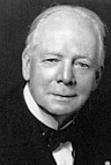
On May 31, 1894 Harvard U. grads Prescott Farnsworth Hall (1868-1921), Charles Warren (1868-1954), Robert DeCourcy Ward (1867-1931) et al. found the Immigration Restriction League in Boston, Mass. to exclude immigrants from S and E Europe (Ireland, Italy, and Germany) for inferior "racial qualities" that are threatening their way of life incl. high wage scale; after introducing a bill to Congress on Apr. 8, 1918 to place numerical limits on immigration, it disbands after Hall's 1921 death.
In 1896 the Irish Agricultural Org. Society is founded to try to rehabilitate Ireland's ruined agriculture.
On Apr. 3, 1900 Queen Victoria makes her 2nd visit to Ireland, landing in Kingstown and visiting Dublin, where she is greeted by enthusiastic crowds (while a botched attempt is made to assassinate her son Prince Edward of Wales in Belgium), staying until Apr. 26.
On July 21, 1903 Edward VII and Queen Alexandria make their first visit to Ireland, cutting their 5-day trip short because of the news of the death of Pope Leo XIII; on Apr. 26, 1940 they return for an 8-day visit.
On Dec. 27, 1904 the Abbey Theatre in Dublin, Ireland, organized by the Irish Nat. Theatre Society opens, becoming the Irish nat. you know what as William Butler Yeats, John Millington Synge et al. write plays for it.
On July 8, 1911 George V and Queen Mary visit Ireland, becoming their first visit outside Britain, landing in Kingstown and staying five days, with The Daily Telegraph calling it "the latest and happiest conquest of Ireland"; it becomes the last visit to Ireland by a reigning monarch until ?.

On Apr. 11, 1912 the Liberal British govt. of Herbert Henry Asquith introduces the Govt. of Ireland Act 1914 (Third Irish Home Rule Bill), sponsored by Irish Roman Catholic MP (1900-18) John Edward Redmond (1856-1918) to give Ireland self-govt.; the House of Lords, egged on by Irish Unionists in Ulster tries in vain to block it for the next two years, but can't veto it anymore; on Sept. 18, 1914 it is passed along with the Welsh Church Act and the Suspensory Act, which postpones the Govt. of Ireland Act's effectiveness until the end of WWI, effectively killing it.




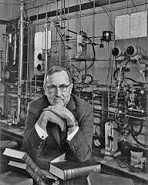
On Aug. 4, 1914 - Nov. 11, 1918 the horrific World War I causes 15M deaths and 39M military casualties. and destroys the Old Order of white formerly Christian Europe. On Feb. 26-28, 1915 the Germans first use a Flamethrower (Flame Projector) in the village of Douaumont, France near Verdun, becoming the first of 653 flamethrower attacks in the war. On Apr. 1, 1915 French aviator Roland Garros (1888-1918) becomes the first pilot to shoot down an aircraft using a deflector gear, which allows shooting through the propeller; after more Vs against German aircraft on Apr. 15 and Apr. 18, he is shot down and the Germans capture his plane, after which Dutch designer Anthony (Anton Herman Gerard) Fokker (1890-1939) clones then improves the deflector gear into the synchronization (interrupter) gear, mounting them on the new Fokker E.I. in Aug., beginning the Fokker Scourge (Scare) as they shoot down nearly every enemy aircraft they encounter and generate the first German aces, incl. Max Immelmann (1890-1916); next year the French counter with the Nieuport 11 Bebe (Bébé), in which the gun is mounted on the top wing clear of the prop, and the British with the Royal Aircraft Factory F.E.2b and Airco DH.2 (Feb. 1916), which mount the engine backwards with the prop in back, causing them to be called "pushers", ending the Fokker Scourge by spring 1917. In 1915 arsenic-based vomiting-sneeze gas Adamsite (DM) (diphenylaminechlorarsine) is synthesized by German chemist Heinrich Otto Wieland (1877-1957); in 1918 Am chemist Roger Adams (1889-1971) duplicates it, and both sides stockpile it, but it is allegedly never used on the battlefield. On Mar. 22, 1916 the British have their first success with their new Depth Charge off the SW coast of Ireland, destroying a German U-boat. Are you used to Hell yet, try this? On Sept. 15, 1916 Winston Churchill's pet project the Tank (Russian Water Closet) (Char-Schneider) is first used by the Brits in the Somme.

In 1914 Rathgar, Dublin-born James Augustine Aloysius Joyce (1882-1941) pub. Dubliners (15 short stories); incl. The Dead; rejected by 22 publishers, then has the first ed. bought out and burned in Dublin. On Dec. 29, 1916 he pub. A Portrait of the Artist as a Young Man; original title "Stephen Hero"; first pub. in "The Egotist" in 1914-15; Stephen Dedalus grows up, breaks free from his Roman Catholic chains and becomes a writer on wings; "Once upon a time and a very good time it was there was a moocow coming down along the road" (first line); "Soft language issued from their spitless lips as they swished in low circles round and round the field, winding hither and thither through the weeds." On Feb. 2, 1922 (2/2/22) (his birthday) he pub. Ulysses (265K words) in Paris; it-has-to-be Jewish ad space salesman Leopold Bloom (Ulysses) (Hungarian Jewish father, Irish mother), wife Molly (Penelope), future son Stephen Dedalus; 18 episodes, each based on an academic discipline and a bodily organ; "To read it with ease, one should have a Ph.D. in comparative languages and literature; to read it with difficulty, one should know the Odyssey, The Golden Bough, Joyce's life and other works, E. K. Chambers' William Shakespeare, and much about the history of English literature, the Celtic Renaissance, Irish politics, and Roman Catholic liturgy... a vocabulary of nearly 25,000 words, Joyce transcends the bounds of Webster's International." (John Greenway); "All perfume yes and his heart was going like mad and yes I said yes I will Yes" (ending); after it uses the word "fuck" twice (once as a noun, once as a verb), the U.S. Post Office burns 500 copies upon arrival in the U.S., and govt. censorship causes Joyce to become a star; the 1935 ed. features illustrations by Henri Matisse; "History is a nightmare from which I am trying to awake" (Stephen Dedalus). In 1939 he pub. the avant-garde comic novel Finnegans Wake, written in Paris over a 17-year period; Finnegan means "fair" in Gaelic; "Riverrun" (first word); "Along the" (end); contains nine 101-letter words he made up to wow readers, starting with "Bababadalgharaghtakamminarronnkonnbronntonnerronntuonnthunntrovarrhounawnskawntoohoohoordenenthurnuk" on page 1, representing the symbolic thunderclap associated with the fall of Adam and Eve. Joyce to write while lying on his stomach wearing a white coat and using large blue pencils, and wrote most of "Finnegans Wake" using pieces of crayon and cardboard.




On Apr. 24, 1916 (Easter Mon.) after seeing their long-awaited (since 1167?) chance, Easter Rising (Week) in Dublin sees 1.6K over-optimistic Sinn Fein nationalists attempt to oust the British Empire from Ireland, marching from Liberty Hall in Dublin to the center of town then seizing several key sites and declaring an independent Irish repub. from the steps of the Gen. Post Office on O'Connell St., describing the Germans as "gallant allies"; too bad, on Apr. 22 leader Eoin MacNeill (1867-1945) cancels mobilization orders, else 5K would have shown up; the rising lasts until Apr. 29, when British forces under gen. Sir John Maxwell (1859-1929) quash it, and the nationalists surrender after 64 are killed along with 220 civilians and 134 troops and policemen; British gunboat HMS Helga destroys Liberty Hall from the sea; on May 12 15 leaders are tried and executed incl. poet Patrick Henry Pearse (b. 1879) (leader of the Irish Repub. Brotherhood), James Connolly (b. 1868) (head of the Irish Citizen Army), and repub. organizer Sean MacDermott (b. 1883); British Capt. J.C. Bowen-Colthurst orders Irish pacifist Francis Sheehy "Skeffy" Skeffington (b. 1878) (a close friend of James Joyce) a rrested for trying to stop looting, then court-martialed and executed on Apr. 26, causing outrage that forces Joyce to flee for Canada and launch his literary career to "beat the English with their own language" (Carmel McCaffrey); Skeffington later becomes a main char. in Joyce's "Portrait of the Artist as a Young Man"; playwright Sean O'Casey (1880-1964) takes part in the rising; math prof. Eamon de Valera (1882-1975) is saved from execution because of his U.S. citizenship, spending the war in English jails; Irish poet William Butler Yeats (1865-1939) writes the pro-Repub. Easter 1916, but waits until 1920 to pub. it; British secy. for Ireland (since 1907) Augustine Birrell resigns.
The American Irish become Mister Feelgood? By the 1920s the Irish have "arrived" in the U.S., and could probably run it if they just weren't !?!? Roman Catholic?; "There are judges by the dozen, incl. a third of the Supreme Court, three Cardinals, Senators, multi-millionaires and captains of industry by the score, like Mr. Henry Ford, the motor king, Mr. Doheny, who dominates the petrol industry, Mr. Thomas F. Ryan, the partner of King Leopold in the Congo diamond mines, Mr. Mellon, the secy. to the Treasury, Mr. Doughtery, the Atty.-Gen., Mr. Smith, the gov. of New York, Mr. Hylan, the mayor of New York, Mr. Tumulty, private secy. to Pres. Wilson, Gen. O'Ryan of the American Army, Dudly Malone, chief official of the port of New York, J.R. Ryan, the head of the Copper Trail, John Mitchel, mayor of New York, Col. Concanon, chmn. of the White Star Line, and J.A. Farrell, Pres. of the U.S. Steel Co." (Terence Sheehy) - we've been ratted out, boys?

On Oct. 14, 1920 IRA leader Sean Treacy (Tracey) (Tracy) (b. 1895) is KIA on Talbot St. in Dublin in a shootout with the stanking' English, pissing-off the IRA; on Nov. 21 (a.m.) after the British Parliament debates the Govt. of Ireland Act (Act to Provide for the Better Govt. of Ireland), dividing Ireland into two political units with some powers of self-govt. and their own parliaments, and Ulster Protestants accept the idea, but the Sinn Fein in Dublin rejects all British attempts to split Ireland, and continues the guerrilla war, causing the British to create the special auxiliary police called the Black and Tans from unemployed WWI veterans, Bloody Sun. sees the IRA kill 14 British undercover intel agents known as the Cairo Gang in Dublin, causing the Black and Tans to retaliate by killing 12 at a Dublin soccer match; in Dec. the military begins a killing and looting spree, causing £3M in damage; on Dec. 23 the Govt. of Ireland Act is passed, creating eternally-divided Northern Ireland by dividing six Unionist NE counties from the other 26, while entrapping many non-Unionists within its boundaries; two Irish parliaments are created, one (Stormont) for the north and one for the south.

On Oct. 25, 1920 Sinn Fein leader (lord mayor of Cork since Mar.) Terence James MacSwiney (b. 1879) dies after a 74-day hunger strike in Brixton Prison in Lambeth, England, becoming a martyr and bringing the Irish War of Independence to internat. attention; next Mar. 1 future cardinal Terence Cooke is born in New York City, named after him.


On Jan. 16, 1921 Michael Collins (b. 1890) becomes chmn. of the Irish provisional govt.; on May 22 (Sun.) the duly-elected parliament of Northern Ireland is opened by the English king, who gives a conciliatory speech; the southern parliament never assembles, and instead a self-constituted body called the Dail Eireann ("assembly of Ireland") (pr. doll-ERR-an) begins meeting, with New York City-born Eamon de Valera (George de Valero) (Edward de Valera) (1882-1975) as pres. #1 of the Irish Free State (ends Dec. 29, 1937), which is established by the Anglo-Irish Treaty (effective Mar. 31), which requires an oath of allegiance to the crown, which Valera and other repub. leaders won't accept but Collins talks a majority of the Dail Eireann into ratifying, so that on June 28 the Irish Civil War begins between the republicans and the nationalists over the treaty (ends May 24, 1923); on July 8 a truce is agreed to, and signed by Great Britain and the IRA on July 11; Michael Collins signs it, saying he's really signed his death warrant, and is assassinated in an ambush by anti-treaty forces on Aug. 22, 1922; on Dec. 6 Great Britain gives the Irish Free State dominion status under the treaty, while six counties in Northern Ireland remain part of the U.K.
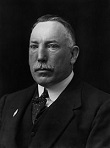
On June 7, 1921 Orange Protestant Sir James Craig, 1st Viscount Craigavon (1871-1940) of the Ulster Unionist Party is appointed PM #1 of Northern Ireland by the Lord Lt. of Ireland (until Nov. 24, 1940), going on to utter the soundbyte on Apr. 1934: "The hon. Member must remember that in the South they boasted of a Catholic State. They still boast of Southern Ireland being a Catholic State. All I boast of is that we are a Protestant Parliament and a Protestant State. It would be rather interesting for historians of the future to compare a Catholic State launched in the South with a Protestant State launched in the North and to see which gets on the better and prospers the more. It is most interesting for me at the moment to watch how they are progressing. I am doing my best always to top the bill and to be ahead of the South."
On Oct. 11, 1921 a conference between the Dail Eireann and the British govt. is held in London in Whitehall on Downing St. under a truce, with Sir James Craig representing the Sinn Fein and Eamon De Valera representing the Dail Eireann.
On Mar. 23, 1926 the right-center Irish repub. party Fianna Fail ("soldiers of destiny", "warriors of Fal") is founded as the official opposition to the Dail Eireann by Eamon de Valera et al. after splitting from Sinn Fein on the abstentionism issue, sharing control of the govt. with Fine Gael until 1989, then leading coalition govts. until 2011.
On Mar. 17, 1931 Ireland hosts its first St. Patrick's Day Parade in Dublin.
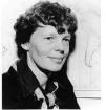
On May 20, 1932 Atchison, Kan.-born freckle cream-using coffee-hating Amelia Earhart (1897-1937) takes off from Harbor Grace, Newfoundland for Ireland in a Pratt & Whitney Wasp-powered Lockheed Vega to become the first woman to fly solo across the Atlantic, and arrives in approx. 15 hours on May 21, becoming the first woman to receive the Distinguished Flying Cross - no ticker tape parade?
In 1932 the Anglo-Irish Trade (Economic) War begins (ends 1938), with unilateral trade restrictions by Britain and Ireland causing severe damage to the Irish economy.
On Sept. 8, 1933 the liberal-conservative Fine Gael ("family/tribe of the Irish") political party is founded in Ireland as the rival of Fianna Fail, growing to the largest party in Ireland (35K members); it goes on to become a founding member of the European People's Party; in 1977 the Young Fine Gael is founded as the party's youth wing (4K members).

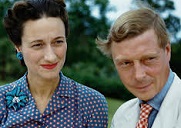
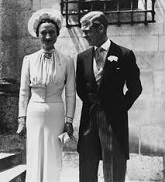
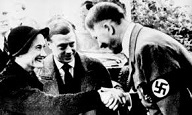
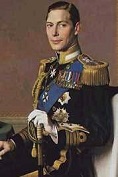


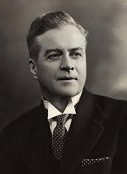
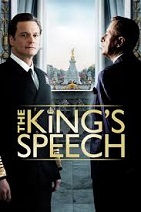
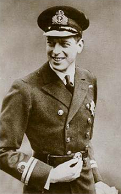

King for a year, or, I Have Eight English Eddies and She Has a Brazilian Bikini Wax, or, The Original Homer Simpson? On Jan. 20, 1936 king (since May 6, 1910) George V (b. 1865) dies, and his depressed, sexually degenerate (submissive?) son Edward VIII (1894-1972) becomes king of Great Britain (58th monarch) (until Jan. 20, 1936) (for 325 days); 568,387 people pass George's coffin in Westminster Hall, and 3M people throng the streets to view the procession to Westminster Abbey for the burial; on his deathbed, George utters the prophecy "After I'm gone, the old boy will ruin himself in 12 months"; upon seeing his daddy's coffin lowered, Edward comments "Christ, what will happen next?"; a power struggle ensues over Edward's friendship with British Nazi Party leader Oswald Mosley, led by PM Stanley Baldwin, who uses the king's twice-divorced concubine Wallis Simpson (nee Bessie Wallis Warfield) (1897-1986) as his Achilles heel; in the summer the king takes a licentious cruise on the steam yacht Nahlin in the Mediterranean with his babe, causing worldwide publicity after British diplomat Philip Henry Kerr, 11th Marquess of Lothian (1882-1940) gives the scoop to Eugene Meyer, owner of the Washington Post, which is blanked out in England, and Baldwin tricks the king into asking his advice on his relationship with Simpson, which he is legally bound to follow, then tells him to give her up or abdicate, because as head of the Church of England, which doesn't let divorced people marry, yada yada yada, which he can never do since she's his dominatrix and makes him beg for a light for his cigs?; Duchess Elizabeth of York detests the "royal harlot", but Churchill stands up for Edward in Parliament, and is hooted down, and the adoring public protests with signs reading "Hands Off Our King" and "Abdication Means Revolution"; however, (does she tie his Windsor knot just right?) after trying all year to get by, slide by, and get over it, all in vain, on Dec. 3 Edward VIII, with the soundbyte "At long last I am able to say a few words of my own" announces that he's in love with a divorced Yankee woman (whose 2nd divorce has not become final?), and abdicates on Dec. 10 (first voluntary abdication in British history) after 325 days in power, saying in a Dec. 11 radio broadcast (written by Churchill), "I have found it impossible to carry on the heavy burden of responsibility and to discharge the duties of king as I would wish to do without the help and support of the woman I love"; on Dec. 11 his reluctant brother Albert Frederick Arthur George, Duke of York (who bears a striking resemblance to Dr. Seuss' Cat in the Hat?) becomes king George VI (Albert Frederick Arthur George) (1895-1952) of the U.K. and the British Dominions (59th monarch) (until Feb. 6, 1952), and last emperor of India (until Aug. 15, 1947), placing his daughter Elizabeth Alexandra Mary (b. 1926) (future Elizabeth II) next in line for the throne, becoming the 3rd time that there have been three different English kings in the same year (1066, 1483); his wife (since 1923) Elizabeth Angela Marguerite Bowes-Lyon (1900-2002) becomes queen consort of the U.K. and the British Dominions, and last empress consort of India (until Feb. 6, 1952, after which she becomes known as Queen Elizabeth the Queen Mother; George VI goes on to preside over the completion of the British Commonwealth (begun 1931) in 1949; George VI suffers from a bad stutter, which he tries mightily to overcome with Australian speech therapist Lionel Logue (1880-1953) (Lat. "speech") (who calls him "Bertie"); within 24 hours of his accession the Irish Free State parliament passes the External Relations Act, dissolving his power in Ireland and removing him from their constitution; the royal family refuses to recognize Wallis' title of Her Royal Highness but makes him the Duke of Windsor, and he leaves for Monts, France where on June 3, 1937 they marry, with the new king banning the royal family from attending, and then live in exile for much of the rest of their lives, forever trying to talk George VI into letting them back in, while the real problem of his Nazi connections makes it impossible?; meanwhile misgivings about the capacity for kingship of the duke of York cause some to prefer his brother George, Duke of Kent (George Edward Alexander Edmund) (1902-42) (4th son of George V and Queen Mary of Teck), who is married to beautiful Princess Marina and has a son to succeed him, until rumors of his kinky interests in black women, hard drugs and young men, plus a gay affair with playwright Noel Coward surface, with Charles Russell later telling Coward, "You were almost a king's mistress, weren't you?"; at the wedding Wallis Simpson wears a wedding dress by Chicago-born. couturier Mainbocher (1891-1976).
On Feb. 17, 1936 a trade pact is signed, greatly reducing tariffs between Britain and Ireland; Ireland agrees to pay land annuities in exchanging for Irish exporters regaining access to the British market, causing the Anglo-Irish Trade War (begun 1932) to end by 1938.
On Apr. 15, 1936 Aer Lingus (Gael. "aerloingeas" = air fleet) is founded by the Irish govt., becoming Ireland's 2nd largest airline after Ryanair, growing to a fleet of 53 with 93 destinations, based in Cork Airport, George Best Belfast City Airport, and Shannon Airport; in 2006-15 it is privatized.
On June 19, 1936 the govt. of Ireland declares the Irish Repub. Army (IRA) illegal.
In Sept. 1936 Ireland abolishes its Senate (until Nov. 3).
On Nov. 3, 1936 Ireland adopts a new 1936 Irish Free State Constitution restoring the Senate, deleting Ireland's relationship to Britain in the wording, and eliminating the functions of the gov.-gen., although retaining the British king for external relations.

On Dec. 29, 1937 New York City-born Eamon de Valera (George de Valero) (Edward de Valra) (1882-1975) becomes PM #2 of Ireland (until Feb. 18, 1948) as the new constitution comes into effect, declaring Ulster to be part of the new state of Eire (Repub. of Ireland) (ends Apr. 18, 1949), which cuts all connections with the British Commonwealth except for retaining Irish envoys; it proclaims a 1937 Irish Constitution, creating a bicameral nat. legislature called the Oireachtas, composed of the Dail Eireann (lower house) and Seanad Eireann (senaate), headed by the Taoiseach (pr. TEE-shock) (PM), nominated by the lower house and appointed by the pres. (7-year term, direct election), who heads a cabinet of 7-15 members.
On Feb. 9, 1938 elections in Northern Ireland give Unionists a big V, ending any hopes of a merger with the Irish Free State.
On Apr. 25, 1938 Britain concludes a 3-year agreement with Ireland, bringing their long-standing feud to an end :).

On June 25, 1938 Gaelic League pres. Douglas Ross Hyde (1860-1949) becomes pres. #1 of Eire (until June 24, 1945).
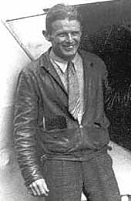
On July 17, 1938 Galveston, Tex.-born pilot Douglas Corrigan (1907-95) is denied permission from the Civil Aviation Authority to fly across the Atlantic from New York City to Ireland because of the poor condition of his plane; he takes off from New York anyway and claims to have mistakenly turned 180 degrees on a flight to Calif., landing in Ireland 28 hours and 13 min. later; after police question him, New York City gives "Wrong Way" Corrigan a ticker-tape parade - the quintessential American success story?

On Jan. 12, 1939 the Army Council of the Irish Repub. Army (IRA) sends an ultimatum, signed by Patrick Fleming to British foreign secy. Lord Halifax, informing them that the "Government of the Irish Republic" intends to go to war if Britain doesn't withdraw its armed forces from Ireland, with a 4-day waiting period; on Jan. 15 after no reply is received, a war declaration is posted in public places throughout Ireland; on Jan. 16, 1939 the Irish Repub. Army (IRA) begins their S-Plan (Sabotage/England Campaign) of bombing England, designed by IRA chief of staff Sean Russell (1893-1940), ending on Mar. 18, 1940 after 300 explosions that kill 10 and injure 96.

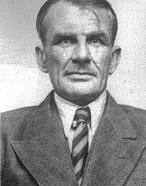


In Apr. 1939 IRA chief of staff Sean Russell (1893-1940) visits the U.S. to stir up public support for militant Irish nationalism, getting trailed all the way by the FBI at the request of Scotland Yard, who get him detained by the U.S. Immigration Service at the Detroit, Mich. border with Windsor, Ont. during the visit of British king George VI, pissing-off Irish-Ams. and causing a protest by 76 Irish-Am. members of Congress, who boycott the Congressional reception for George VI after Pres. Roosevelt refuses to explain; Russell is then smuggled aboard the steamer George Washington to Genoa, Italy on May 1, followed by Berlin on May 5, and informed of Operation Mainau, a plan to parachute German spy Hermann Goertz (Görtz) (1890-1947) into Ireland, failing to brief him on Ireland after missing his takeoff from Kassel-Fritzlar Airfield; Russell then begins training with the Abwehr on the use of advanced explosives disguised as as everyday objects, and on Aug. 8 departs Berlin from Wilhelmshaven aboard German U-boat U-65 with fellow IRA man Frank Ryan (1902-44), leader-founder of the failed Marxist Repub. Congress in 1934-6; too bad, Russell suffers a burst gastric ulcer and dies on board on Aug. 14 100 mi. from Galway, becoming an Irish repub. hero to the IRA and Sinn Fein; in Sept. 1951 a memorial to Russell is erected in Fairview Park in Dublin, which later pisses-off people who accuse him of being a Nazi collaborator, causing the statue to repeatedly be vandalized; "I don't know what was in the depth of Seán Russell's thinking down the years, but I am sure he was never far from Pearse's own position, who said, as a patriot, preferring death to slavery, I know no other way. There are things worse than bloodshed, and slavery is one of them. We are not and will not be slaves." (Provisional IRA army council member Brian Keenan, Sept. 2003); meanwhile in May 1940 Goertz parachutes into Ballivor, County Meath, Ireland, staying in safe houses in Dublin while with making contact with former IRA leader and explosive expert (Agent V-Held) Seamus (James) "Jim" O'Donovan (1896-1979) to plan for IRA assistance during their planned occupation of Britain; too bad, German-descent IRA member Stephen Carroll Held is caught red-handed with his parachute and papers, incl. detailed plans for Plan Kathleen (Artus Plan), an IRA invasion of Northern Ireland with German assistance, leading to Goertz's capture in Nov. 1941 after 18 mo.; he commits suicide with a vial of cyanide on May 23, 1947 to avoid deportation; on June 10, 1944 Ryan dies in a hospital in Loschwitz, Dresden, German while acting as a go-between between the IRA and Abwehr.
On Aug. 25, 1939 (2:32 p.m.) an IRA bicycle basket bomb explodes in the center of Coventry, England, killing five and injuring 70.
On Sept. 1, 1939 the Dail of the Repub. of Ireland (Eire) meets, and on Sept. 2 declares a state of emergency; on Sept. 3 it enacts the 1939 Emergency Powers Act, declaring neutrality, with harsh wartime economic conditions stoking anti-British sentiment, although 50K join the British military; when asked why Eire isn't doing its part in the moral fight against Nazism, external affairs secy. Joe Walshe utters the soundbyte: "Small nations like Ireland do not and cannot assume a role as defenders of just causes except [their] own... Existence of our own people comes before all other considerations... No government has the right to court certain destruction for its people; they have to take the only chance of survival and stay out"; meanwhile the Oireachtas (Parliament) of the Repub. of Ireland (Eire) passes the 1939 Treason Act, replacing the British treason acts of 1351 and 1925, and the 1939 Offences against the State Act, while the British Parliament passes the 1939 Prevention of Violence (Temporary Provisions) Act, causing IRA members to be arrested in Eire or Britain and/or deported to Britain.
In the 1940s Shannon Airport (Ireland) bartender Michael Collins, invents Irish Coffee?
In Jan. 1940 the justice minister of Eire is granted extra powers under an amendment to the Emergency Powers Act, leading to the arrest and imprisonment of 600 IRA members, with 500 more imprisoned during WWII; on June 10 Time mag. pub. the article Eire Against Everybody, containing the soundbyte: "Since 1938 its [the IRA's] 7,500 youthful members (plus 15,000 fellow travelers) have followed the wild-eyed, bomb-Britain policy of 46-year-old, super-radical Chieftain Sean Russell. There is reason to believe that the intransigent I. R. A.-sters are getting money from the Nazis, mostly by way of the U.S."
On Aug. 20, 1940 a German bomber strafes a lighthouse on Blackrock Island off the coast of County Mayo, Ireland, doing little damage.
On Aug. 26, 1940 (afternoon) the German Luftwaffe drops three bombs on Campile, County Wexford, Ireland (14km from New Ross), destroying the Shelbourne Co-Operative Creamery and killing three female staff members; Hitler later explains it as bombers mistaking the Irish E coast for the W coast of Britain, which doesn't stop it from happening again on Apr. 15-16, 1941 (night) in Belfast, causing Eire PM Eamon de Valera to authorize a fire brigade to be sent to help; on May 31, 1941 (night) the Luftwaffe drops four high explosive bombs on the North Strand area of Dublin, damaging or destroying 300 houses, killing 34 and injuring 90, which is taken as a German reprisal for assisting Belfast, causing the German govt. on June 19 to apologize and offer reparations, after which no more German bombings happen in Ireland during WWII.
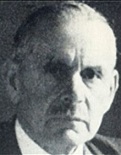
On Nov. 27, 1940 John Miller "J.M." Andrews (1871-1956) becomes Northern Ireland PM #2 (until May 1, 1943).
On Jan. 1, 1941 the Germans bomb Eire, incl. Counties Meath, Carlow, Kildare, Wicklow, Wexford, and Dublin, killing three and injuring two in Carlow; on Jan. 2 (a.m.) the Germans bomb Terenure S of Dublin, followed on Jan. 3 (a.m.) by the South Circular Rd. area of S Dublin, with no fatalities; on May 31 the Germans bomb N Dublin, killing 28 in the North Strand area; on June 2 they bomb Arklow, with no casualties; on July 24 they bomb Dundalk in County Louth, with no casualties.
On Apr. 7/8, 1941 (night) the Belfast Blitz in Northern Ireland by the German Luftwaffe begins, followed on Apr. 15 (Easter Tues.) when 200 bombers attack military and industrial targets with high explosive bombs, killing 900 and injuring 1.5K, becoming the greatest loss of life in a night raid during the Blitz; on May 4/5 a 3rd raid kills 150 with incendiary bombs; on May 5/6 the 4th and final raid demolishes 1.3K houses, badly damages 5K, slightly damages 30K, and makes "first aid repairs" necessary to 20K; fire brigades from Dublin and Dun Laoghaire are sent to assist Belfast.
On Jan. 26, 1942 despite protests from pres. Eamon de Valera, 37K U.S. troops arrive in Ulster, Northern Ireland, becoming their first overseas deployment after the Pearl Harbor attack; the local pop. greets them warmly, esp. the women, making some men jealous.
In 1942 Shannon Airport in Shannon, County Clare, Ireland opens, extending the runways in 1945 to handle transatlantic flights; on Oct. 24, 1945 the Flagship New England (Am. Overseas Airlines DC-4) becomes its first scheduled commercial flight.
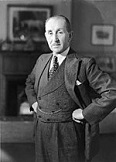
On May 1, 1943 hardcore anti-Catholic Ulster Unionist Party leader Sir Basil Brooke, 5th Baronet (Basil Stanlake Brooke, 1st Viscount Brookeborough) (1888-1973) becomes Northern Ireland PM #3 (until Mar. 26, 1963).
On May 13, 1945 Winston Churchill gives his Five Years of War speech on the radio, criticizing Eamon de Valera and Eire for their neutrality in WWII, with the soundbytes: "This was indeed a deadly moment in our life, and if it had not been for the loyalty and friendship of Northern Ireland we should have been forced to come to close quarters with Mr. de Valera or perish forever from the earth. However, with a restraint and poise to which, I say, history will find few parallels, we never laid a violent hand upon them, which at times would have been quite easy and quite natural, and left the de Valera Government to frolic with the German and later with the Japanese representatives to their heart's content. When I think of these days I think also of other episodes and personalities. I do not forget Lieutenant-Commander Esmonde, V.C., D.S.O., Lance-Corporal Kenneally, V.C., Captain Fegen, V.C., and other Irish heroes that I could easily recite, and all bitterness by Britain for the Irish race dies in my heart. I can only pray that in years which I shall not see, the shame will be forgotten and the glories will endure, and that the peoples of the British Isles and of the British Commonwealth of Nations will walk together in mutual comprehension and forgiveness"; on May 16 Valera gives his own radio speech giving his side.

On June 25, 1945 Sean Thomas O'Kelly (1882-1966) becomes pres. #2 of Eire (until June 24, 1959), succeeding Douglas Hyde (b. 1860), who dies in Dublin on July 12, 1949.
On Jan. 21-Mar. 21, 1947 the 1946-7 U.K. Winter sees cold spells hit on Jan. 21, bringing snowstorms that leave large snowdrifts that block the transport of coal to electric power stations, causing severe hardships incl. shutdown of businesses; in mid-Mar. warm weather returns, causing massive snow melting that brings widespread flooding affecting 100K bldgs., causing a 15% drop in industrial production along with a 15% reduction in cereal and potato crops and 35% of the sheep herds freezing to death, all causing the Labour Party to lose popularity and the English pound to be devalued from $4.03 to $2.80; meanwhile cold and famine in Berlin kills 150, businesses close in Ireland, and civil unrest rocks the Netherlands, contributing to the introduction of the Marshall Plan in Europe.
Eire go bragh? On Dec. 21, 1948 the Roman Catholic Repub. of Ireland (formerly the Irish Free State and Eire), consisting of the provinces of Leinster, Munster, Connacht, and part of Ulster (five-sixths of the Ireland, excluding pesky Protestant Northern Ireland) declares its independence; it comes into force on Easter Mon., Apr. 18, 1949; as Eire, it remained neutral throughout WWII, and sent official condolences to the Germans on the death of Hitler; its official symbol is the harp, not the shamrock? - should be Eerie?
On Apr. 17, 1949 26 countries officially leave the British Commonwealth; a 21-gun salute on O'Connell Bridge in Dublin announces the new Repub. of Ireland.
On Apr. 18, 1949 the British Ireland Act of 1949 comes into effect, recognizing the withdrawal of the Repub. of Ireland from the British Commonwealth and conferring British citizenship on all persons born there or were domiciled outside it before Dec. 6, 1922, or were ordinarily resident outside it from 1935-48 and who had not registered as an Irish citizen.

On June 6, 1952 John Ford's The Quiet Man (Argosy Pictures) (Republic Pictures) debuts, written by Frank S. Nugent based on a 1933 short story by Maurice Walsh and filmed on location in W Ireland in County Galway and County Mayo, starring John Wayne as Yankee boxing champ Trooper Sean Thornton, who quits after killing a man in the ring, and Maureen O'Hara as Red Head Mary Kate Danaher, who is matched in marriage to him, and gets "dragged by the black roots of her red hair", and has a great kissing scene in the cottage in the storm with the big stud, along with a great comic fight scene with her brother Squire Will "Red" Danaher (Victor McLaglen); also stars Barry Fitzgerald as whiskey-loving leprechaun-like Michaleen Oge Flynn, Mildred Natwick as Widow Sarah Tillane, and Ward Bond as Father Peter Lonergan; makes Ashford Castle in County Mayo, former country seat of the Guinness family (where the cast stays) into a tourist trap; does $3.2M box office on a $1.75M budget; watch trailer.
On Dec. 14, 1955 the U.N. Security Council votes 8-0-3 (Belgium, U.S., Repub. of China) for Resolution 109 to admit Albania, Jordan, Ireland, Portugal, Hungary, Italy, Austria, Romania, Bulgaria, Finland, Ceylon, Nepal, Libya, Cambodia, Laos, and Spain.

On June 25, 1959 Irish PM (since 1957) Eamon de Valera is succeeded by Sean Francis Lemass (1899-1971) (until Nov. 10, 1966); New York City-born Eamon de Valera (George de Valero) (Edward de Valera) (1882-1975) becomes pres. #3 of Eire (until June 24, 1973), succeeding Sean Thomas O'Kelly; when he retires at age 90, Valera is the world's oldest head of state.
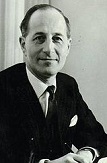
On Mar. 25, 1963 Terence Marne O'Neill, Baron O'Neill of the Maine (194-90) becomes Northern Ireland PM #4 (until May 1, 1969), attempting to bring Catholics and Protestants together and promote industrialization and modernization, getting criticized for visiting a convent and becoming the first Northern Ireland MP who couldn't rely on the support the British govt. after Labor Party leader Harold Wilson becomes PM on Mar. 4, 1974.
On Mar. 7, 1964 Irish Thoroughbred champion steeplechaser Arkle (1957-70) avenges a defeat by defeating English champion Mill House (1957-) by 5 lengths in a 2-horse race that was in reality a national rivalry. The disgruntled Brits force Arkle to carry 2.5 stones more weight than the other horses in the 1964 Irish Grand National, which he still wins by 1 length. In 1965 Arkle crushes Mill House in a Gold Cup rematch by 20 lengths. Arkle becomes a nat.l hero in Ireland, often referred to as Himself, and is said to drink Guinness twice a day, their ultimate compliment. Dominic Behan releases a hit ballad titled Arkle.

On Nov. 10, 1966 former hurling and Gaelic football star John Mary "Jack" Lynch (1917-99) becomes PM (Taoiseach) #4 of Ireland (until Mar. 14, 1973), becoming "the most popular Irish politician since Daniel O'Connell." (Liam Cosgrave)

On Oct. 9, 1968 Francis Ford Coppola's Finian's Rainbow (Oct. 9) (Warner Bros. - Seven Arts) debuts, based on the 1947 E.Y. Harburg-Fred Saidy musical, starring Fred Astaire as Finian McLonergan, Petula Clark as his daughter Sharon McLonergan, who abscond from Ireland with a pot of gold hidden in a carpetbag and head to Rainbow Valley in Missitucky near Fort Knox, while pissed-off Og the Leprechaun (Tommy Steele) pursues him; Barbara Hancock plays Susan the Silent; Keenan Wynn plays Sen. Billboard Rawkins; does $11.6M box office on a $3.5M budget; features songs incl. Look to the Rainbow, How Are Things in Glocca Morra; watch trailer.
On Jan. 1, 1969 the People's Democracy March in Northern Ireland, a 4-day MLK-style protest march from Belfast to Derry begins; too bad, on Jan. 5 after leaving Claudy they are ambushed by a loyalist mob at Burntollet Bridge 7 mi. from Derry, becoming known as the 1969 Derry Riots, leaving 100 injured; more riots occur in Derry and Newry on Jan. 11; on Jan. 15 PM Terence O'Neill announces an official inquiry.

On Jan. 27, 1969 hardline Protestant Northern Ireland leader Rev. Ian Richard Kyle Paisley (1926-2014), leader of the loyalist opposition to the Roman Catholic civil rights movement in Northern Ireland is jailed for 3 mo. for illegal assembly, going on to help instigate the Troubles after taking Terence O'Neill's parliament seat.

On Apr. 17, 1969 21-y.-o. Roman Catholic civil rights activist Bernadette Devlin (1948-) (student at Queen's U. in Belfast) is elected British MP for Mid-Ulster (one of 12 MPs from Northern Ireland), becoming the youngest MP since William Pitt the Younger in 1782, winning the hearts of the English Labour Party in her maiden speech on Apr. 23 at Westminster on her 22nd birthday, going on to organize Roman Catholic resistance in Londonderry, and reaching out to working class Protestants by claiming a class rather than religious struggle, while her nemesis Rev. Ian Paisley rallies Protestant militants, no Roman Catholics allowed.

On May 1, 1969 after moderate reformer Terence O'Neill resigns on Apr. 28 over a series of bomb explosions by the Ulster Volunteer Force (UVF) on Belfast's water supply, Maj. James Dawson Chichester-Clark, Baron Moyola (1923-2002), who enjoys support from the Protestant right wing is elected to head the Ulster Unionist Party, becoming PM #5 of Northern Ireland (until Mar. 23, 1971, going on to top O'Neill's reforms, giving Catholics concessions in public housing and local elections; on May 10 O'Neill utters the soundbyte: "It is frightfully hard to explain to Protestants that if you give Roman Catholics a good job and a good house they will live like Protestants because they will see neighbours with cars and television sets; they will refuse to have eighteen children. But if a Roman Catholic is jobless, and lives in the most ghastly hovel he will rear eighteen children on National Assistance. If you treat Roman Catholics with due consideration and kindness they will live like Protestants in spite of the authoritative nature of their Church."


On July 2, 1969 Blackpool, Cork City-born John Mary "Jack" Lynch (1917-99) is reelected PM of Ireland (until Mar. 14, 1973), and appoints Erskine Hamilton Childers (1905-74) as deputy PM, the highest post ever held by a Protestant in Ireland - lots of board meetings, we're always playing catch-up?
On July 14, 1969 Francis McClusky (b. 1902) becomes the first person killed in the Northern Ireland Troubles, which end in 1998 after 16.2K bombings, 3.5K killed, and 50K injured; by 2011 Protestants outnumber Roman Catholics in Northern Ireland by only 3%, becoming the majority in 2021; in Dec. the Provisional Irish Repub. Army (Provisional IRA) (Provos) is formed to end British rule in Northern Ireland, becoming the biggest and most active paramilitary group during the Troubles; it isn't disbanded until Apr 1998.
On Aug. 12-14, 1969 the Battle of the Bogside erupts in the Bogside area of Derry, North Ireland after a march by the Apprentice Boys of Derry turns into a riot between the Derry Citizens' Defense Assoc. and the Royal Ulster Constabulary, killing eight, injuring hundreds, and burning 2K homes; on Aug. 12 Repub. of Ireland Taoiseach (PM) (1966-73) John Mary "Jack" Lynch (1917-99) gives a speech to the U.N. in which he asks them to deploy a peacekeeping mission in Northern Ireland, followed on Aug. 13 by a speech on RTE in which he utters the soundbytes: "Indeed the present situation is the inevitable outcome of the policies pursued for decades by successive Stormont governments", and: "It is clear also that the Irish government can no longer stand by and see innocent people injured and perhaps worse"; on Aug. 14 British troops arrive in Northern Ireland to intervene after bloodshed in the six counties of Northern Island causes Catholic enclaves in Belfast and Londonderry to build barricades against the Protestant-controlled Royal Ulster Constabulary; the ongoing sectarian violence between Protestants and Catholics, known as The Troubles (1968-98) becomes so intense that the army assumes complete control of security after rioting resumes on Aug. 19; in the next 25 years over 3K (43% Catholic, 30% Protestant) are killed in a 3-way struggle between British troops, the IRA, and Protestant terrorist groups.
On Jan. 11-17, 1971 violence breaks out in two Roman Catholic areas of Belfast, North Ireland.
On Feb. 6, 1971 Robert Curtis becomes the first British soldier to die in the Troubles in North Ireland after he is shot by the IRA.

On Mar. 23, 1971 Arthur Brian Deane Faulkner, Baron Faulkner of Downpatrick (1921-77) becomes PM #6 (last) of Northern Ireland (until Mar. 30, 1972), succeeding James D. Chichester-Clark, who resigned over a dispute over Catholic terrorists;; on Jan. 1, 1974 he becomes pres. #1 (last) of the devolved power-sharing Northern Ireland Assembly Executive until it collapses on May 28; on Mar. 3, 1977 Faulkner dies from a fox hunting accident 24 days after being granted a life peerage as Baron Faulkner of Downpatrick.
On Aug. 9, 1971 the heaviest Catholic-Protestant rioting in 50 years erupts in Northern Ireland after the Brits introduce Operation Demetrius (Internment), arresting 342 suspected of supporting paramilitary orgs. and jailing them without trial, while killing 14 and causing 7K (mostly Roman Catholics) to flee their homes; in Sept. the Protestant loyalists form the Ulster Defence Assoc. (UDA) to combat the Catholic republican IRA, adopting the name Ulster Freedom Fighters in 1973.

In 1971 Armagh-born Presbyterian minister Rev. Ian Richard Kyle Paisley (1926-2014) forms the Protestant Dem. Unionist Party in Northern Ireland; meanwhile Roman Catholic leader Bernadette Devil, er, Devlin gives birth to a child out of wedlock, pissing-off her supporters, and gets a 9-mo. prison sentence; she finally marries in 1973 and runs for reelection in 1974.
On Jan. 22, 1972 the Treaty of Accession to the European Communities is signed in Brussels, allowing Britain, Denmark, Ireland, and Norway to join the European Economic Community (EEC); the British House of Commons approves it on July 14, but Norway votes to not join after all, leaving the poor little EEC at 20 nations with 257M pop.; on July 31 Belgian PM (1938-9, 1946-9) Paul-Henri Spaak (b. 1899), co-founder of the EEC dies.
Northern Ireland finally goes into civil war over silly religion? On Jan. 30, 1972 Bloody Sunday in Northern Ireland sees British parachute regiment soldiers open fire on an unarmed civilian demonstration in Londonderry, killing 13; on Feb. 2 the funerals are held, causing 25K to march to the British embassy in Belfast with replica coffins and black flags and burn it to the ground, becoming the first IRA terrorist action in Northern Ireland; on June 17, 2010 British PM David Cameron apologizes, saying "I am deeply sorry", becoming the first time that a British leader apologizes to the Irish since they took the island over in the 1170s; on Feb. 22 the Aldershot Barracks Bombing at the HQ of the 16th Parachute Brigade by the IRA kills seven incl. five women and a Roman Catholic priest; on Mar. 30 the Provisional Govt. in Northern Ireland (Stormont) is suspended, and direct rule from London is reinstated; on Apr. 14 the IRA explodes 24 bombs across North Ireland, and hold 14 shootouts with British troops; British soldiers and tanks become commonplace as they patrol war zones between Catholic and Protestant neighborhoods; during the year 1.4K bombings and 10.6K shootings are reported by police, and 470 are killed.
On Feb. 2, 1972 a bomb explodes in the British Yacht Club in West Berlin, killing German boat builder Irwin Beelitz; the IRA claims responsibility.

On July 7, 1972 English-born Provisional IRA leader Sean Mac Stiofain (Seán Mac Stíofáin) (John Stephenson) (1928-2001) holds secret talks with the British govt., giving the IRA's demands incl. unconditional release of all political prisoners, declaration of intent to withdraw from Northern Ireland by Jan. 1975, and a democracy consisting of all the people of Ireland voting together as a unit, which are all rejected, causing the IRA to ramp-up its campaign; on Nov. 19 Stiofain is arrested in Dublin after giving a TV interview to RTE's This Week, and on Nov. 25 after the interview is used as evidence of IRA membership he is sentenced to 6 mo. in Curragh Prison, where he goes on a hunger strike amid protests in Dublin; he is released in Apr. 1973 after losing his influence in the IRA. On July 21 (Fri.) (2:10 p.m. local time) Bloody Fri. sees the Provisional IRA explodes 22 bombs in Belfast in a 75-min. period, killing two British soldiers and seven civilians, and injuring 130 more civilians; on July 31 (4:00 a.m.) Operation Motorman sees 12K British soldiers with tanks and bulldozers retake "no-go" areas controlled by the IRA; on July 31 a car bomb in Claudy, County Londonderry, North Ireland kills nine civilians; no group claims credit.
On Oct. 16, 1972 a riot in the new Maze Prison (Her Majesty's Prison Maze) (originally Long Kesh Detention Centre) (opened Aug. 9, 1971) in County Down, Northern Ireland for paramilitary prisonres results in a fire burning most of the camp.
On Dec. 7, 1972 Belfast-born mother of 10 Jean McConville is abducted from her home in Belfast by the IRA and murdered; they don't admit it for 20 years.
On Jan. 1, 1973 Britain, Ireland, and Denmark enter the European Common Market (Community) created by the 1958 Treaty of Rome.
On Mar. 8, 1973 the Border Poll in Northern Ireland on whether Northern Ireland should remain a part of the U.K. is boycotted by Catholics, and results in a 57% yes vote; 59% of the 1M electorate turns out, but only 1% of Catholics; meanwhile on Mar. 8 the Provisional IRA explodes bombs in Whitehall and the Old Bailey in England; on Mar. 20 the British govt. releases a White Paper on a Catholic-Protestant Coalition Govt., calling for reestablishment of an assembly elected by proportional rep., with a possible All-Ireland Council.
On Apr. 11, 1973 the British House of Commons votes against restoring capital punishment by a 142-vote margin, and on May 14 it votes to abolish it in Northern Ireland.

On Apr. 28, 1973 six Irishmen incl. Joe Cahill (1920-2004) (a founder of the Provisional IRA, who was arrested for IRA involvement in 1972 and released after a 23-day hunger strike, then became the IRA chief of staff in Nov. 1972) are arrested off County Waterford, Ireland by the Irish Navy aboard the ship Claudia en route from Libya carrying 5 tons of weapons destined for the Provisional IRA; Cahill is sentenced to three years in priz after uttering the soundbyte: "If I am guilty of any crime, it is that I did not succeed in getting the contents of the Claudia into the hands of the freedom fighters of this country"; after release, he goes to the U.S., and is deported in 1984; in 2004 he dies of asbestosis after uttering the soundbyte: "I was born in a united Ireland, and I want to die in a united Ireland".
On May 17, 1973 an IRA car bomb in Knock-na-Moe Castle Hotel in Omagh, County Tyrone kills five British soldiers.
On June 12, 1973 an IRA bomb in Coleraine, County Antrim kills six Protestant civilians after an inadequate warning.


On June 25, 1973 after defeating Tom O'Higgins by 636K votes to 579K, Protestant (Anglican) Erskine Hamilton Childers (1905-74) becomes pres. #4 of Eire (until Nov. 17, 1974), becoming a popular pres. until he suddenly dies of a heart attack next Nov. 17, after which his Roman Catholic widow (married in 1952) Rita Childers is passed over when a secret deal to make her pres. is given away by a minister with poor hearing who mishears a journalist's question, and on Dec. 19, 1974 former chief justice Cearbhall O Dalaigh (Ó Dálaigh) (1911-78) becomes pres. #5 of Ireland, only to resign on Oct. 22, 1976 after being publicly insulted by the minister of defense, after which she calls for the suspension of the office.
On June 28, 1973 elections for the Northern Ireland Assembly are held, leading to power-sharing between unionists and nationalists for the 1st time; on July 18 the Northern Ireland Constitution Act receives royal assent, abolishing the suspended Parliament of Northern Ireland along with the post of gov., providing for a devolved admin. consisting of an executive chosen by the assembly, which incl. 108 members elected by votes from Northern Ireland's 18 Westminster constituencies (5-8 seats for each); too bad, on July 31 the assembly meets for the first time, while militant protesters led by Protestant minister Ian Paisley disrupt its first sitting.
On Oct. 31, 1973 (Halloween) (3:40 p.m.) the Mountjoy Prison Helicopter Escape near Dublin sees three Provisional IRA members, J.B. O'Hagan, Kevin Mallon, and Seamus "Thumper" Twomey (IRA chief of staff) escape using a helicopter hijacked by another member in Dublin, which lands in the exercise yard to pick them up, becoming the first heli prison escape, spawning many copycat escapes; they thought it was a govt. minister arriving?

On Nov. 22, 1973 Britain announces a plan for moderate Protestants and Roman Catholics to share power in Northern Ireland, negotiated by Scottish-born British Conservative politician William Stephen Ian 'Willie' Whitelaw, 1st Viscount Whitelaw (1918-99); fishing paradise County Fermanagh in the SW is replaced by a number of new districts; the exec body is given control of all affairs except security, justice, foreign relations and some financial matters - it's not how you're covered it's how you're treated?
On Dec. 9, 1973 the Sunningdale Agreement between the Protestant Unionists and Catholic Nationalists is signed in Sunningdale, Berkshire, England, attempting to end the Troubles with a power-sharing Northern Ireland Executive and a cross-border Council of Ireland; too bad, a loyalist gen. strike next May kills it.
On Feb. 4, 1974 an IRA bomb in a coach carrying British soldiers and their families to an army base in Catterick kills 11 and injures 12 on the M62 Motorway in Yorkshire, England.
On Apr. 27, 1974 a Lewis's Dept. Store in Manchesters Piccadilly Gardens in Liverpool (founded 1856) is evacuated after an IRA bomb threat; too bad, the Provisional IRA bombs it for real on June 15, 1996.
On May 29, 1974 the Northern Ireland Assembly collapses, and North Ireland returns to British rule after a gen. strike of Protestant militants topples Brian Faulkner's coalition govt., torpedoing the Dec. 1973 Sunningdale Agreement.
In May 1974 in Northern Ireland IRA member Sean O'Callaghan (1954-) and two other teenagers gun down police inspector Peter Flanagan in Broderick's Bar in Omagh; O'Callaghan later serves 8 years of a 539-year terrorism sentence and is released in Dec. 1996 for becoming an informer.
On June 17, 1974 a Provisional IRA bomb explodes in the Houses of Parliament in London, setting a gas main on fire and severely damaging Westminster Hall, injuring 11.
On July 17, 1974 (14:30) a Provisional IRA bomb explodes in the White Tower in London while it is filled with tourists, killing one and injuring 41, blowing limbs off, etc.; another bomb exploded outside a govt. bldg. in Balham, S London at 04:30.
On Oct. 5, 1974 IRA bombs in two pubs (Horse and Groom, Seven Stars) in Guildford, England kill four British soldiers and one civilian; too bad, the British govt. wrongfully convicts and imprisons the Guildford Four next year, and they aren't released until Oct. 19, 1989; filmed in 1993 starring Daniel Day-Lewis as Gerry Conlon.
In Oct. 1974 the Balcombe Street Gang of the Provisional IRA begins a bombing campaign in England in London and surrounding areas, carrying out approx. 40 bomb attacks by Dec. 1975, incl. hitting the same targets twice and carrying 2+ attacks on the same day, incl. seven time bombs in London on Jan. 27, 1975.
On Nov. 7, 1974 a Provisional IRA bombs explodes at the Kings Arms pub in Woolwich, killing an off-duty soldier and a civilian, and injuring 28; meanwhile two British soldiers are killed by an IRA bomb near Stewartstown in County Tyrone, Ireland.
On Nov. 21, 1974 (8:25 p.m., 8:27 p.m.) the Provisional IRA bombs two pubs (Mulberry Bush, Tavern in the Town) in Birmingham, England, killing 21 civilians (10 at the Mulberry, 11 at the Tavern), and injuring 162, after which on Aug. 15, 1975 the Birmingham Six are wrongfully convicted and sentenced on Aug. 15 to life in prison, and after going through Hell the convictions are finally overturned on Mar. 14, 1991.
On Nov. 27, 1974 the 1-year "emergency temporary powers" Prevention of Terrorism Act is passed in the U.K. in response to the IRA bombings, allowing terrorist orgs. to be made illegal and necessary police actions to be taken; it is renewed yearly, and rewritten in 1974, 1984, and 1989, then replaced with the more permanent 2000 Terrorism Act and 2005 Prevention of Terrorism Act.
On Dec. 19, 1974 (21:00 GMT) a Provisional IRA (Balcombe Street Gang) car bomb explodes near Selfridge's dept. store on Oxford St. in London, injuring nine and causing £1.5M damage.
On Dec. 22, 1974 the Provisional IRA announces a Christmas ceasefire after bombing the vacant home of ex-PM Edward Heath.
On Jan. 17, 1975 the IRA ends the 25-day ceasefire in Northern Ireland.
On Feb. 10, 1975 the Provisional IRA agrees to a ceasefire, after which the Brits set up seven "incident centres" to monitor it; on Feb. 20 the Official IRA and the Irish Nat. Liberation Army begin a feud, which lasts until June, and on Mar. another feud begins between the Ulster Volunteer Force and Ulster Defence Assoc.; the truce ends on Jan. 23, 1976.
On Feb. 26, 1975 off-duty London police officer Stephen Andrew Tibble (b. 1953) is killed by Provisional IRA member Liam Quinn during a chase.
On July 17, 1975 a PIRA bomb hidden in a milk chum near Forkill (Forkhill) in County Armagh kills four British soldiers on foot patrol, breaking the Feb. truce.
On Sept. 5, 1975 (12:18 a.m.) after a 10-min warning, the London Hilton is bombed by the Provisional IRA, killing two and injuring 63.


On Oct. 3, 1975 Dutch industrialist Tiede Herrema (1921-) is kidnapped in Castletroy, Limerick on his way home by Provisional IRA members Eddie Gallagher and Marion Coyle (1954-), who demand the release of three IRA prisoners incl. Gallagher's wealthy babe Bridget Rose Dugdale (1941-) (who robbed the home of wealthy Sir Alfred Beit on Apr. 26, 1974 and stole 19 old masters valued at £8M, and gave birth to Gallagher's child in priz on Dec. 12, 1974) after the kidnappers are traced to a house in Monasterevin, County Kildare, a 2-week siege ends in his release unharmed on Nov. 7; Gallagher is given a 20-year sentence, and Coyle 15 years; on Jan. 24, 1978 Dugdale and Gallagher become the first convicts to marry in prison in the history of the Repub. of Ireland. On Oct. 9 a Provisional IRA bomb explodes outside the Green Park Tube Station near Piccadilly, London, killing one and injuring 20.
On Nov. 22, 1975 the Drummuckavall Ambush by the PIRA in South Armagh kills three British soldiers and captures one - named Jody?
On Nov. 25, 1975 the IRA is officially outlawed in the U.K.

On Nov. 27, 1975 English "Guinness Book of World Records" co-founder (1955) Alan Ross McWhirter (b. 1925) is assassinated outside his home in Bush Hill Park, Enfield, London by two Provisional IRA terrorists, Harry Duggan and Hugh Doherty of the Balcombe Street Gang after he offers a £50K reward for the gang's arrest on Nov. 4; the perps are arrested in Dec. and sentenced to life in priz, then released in 1999 under the terms of the Good Friday Agreement.
On Dec. 6-12, 1975 the Balcolmbe St. Siege in London sees four Provisional IRA members of the Balcombe Street Gang hold two hostages in an apt. until surrendering.
On Dec. 19, 1975 the Protestant Ulster loyalist anti-IRA Red Hand Commandos (founded 1972) kill five Catholic civilians in South Armagh and Louth, Northern Ireland.
On Jan. 29, 1976 the Provisional IRA explodes 12 small bombs in West End, London, injuring a taxi driver.
On Mar. 4, 1976 the Maguire Seven are found guilty of explosives possession, serving 14 years in jail.
On Mar. 4, 1976 the British Parliament dissolves the Northern Ireland Constitutional Convention and retores direct rule.
On May 15, 1976 the UVF kills five Catholic civilians with bomb attacks in Belfast and Charlemont in County Armagh, while the PIRA kills three British police in County Fermanagh, and another in County Down.


On Aug. 10, 1976 IRA fugitive Danny Lennon is fatally shot by British troops while driving in his car in Belfast, Northern Ireland, after which it goes out of control and kills three children and critically injures their mother Anne Maguire, who commits suicide in 1980; witness Betty Williams (1943-) and Mairead Corrigan (1944-) (Maguire's sister, who goes on TV a few hours after the incident, becoming the first Catholic woman in Ulster to challenge the IRA) found the Community of the Peace People (AKA People's Peace Movement), organizing a march on Aug. 14 by 10K Catholics and Protestants to the graves of the children, demanding an end to violence in Northern Ireland; after the IRA disrupts it, they return with 35K people, becoming the 1st time that the two Christian sects join in large numbers for peace; Williams and Corrigan are quickly awarded the 1976 Nobel Peace Prize.

On Dec. 3, 1976 after being elected unopposed, European Commissioner for Social Affairs (since 1973) (Ireland's first European Commissioner) Patrick John "Paddy" Hillery (1923-2008) becomes pres. #6 of Eire (until Dec. 2, 1990), going on to earn credit for withstanding political pressure from his Fianna Fail party during the 1982 political crisis.

On May 14, 1977 undercover British Protestant soldier Capt. Robert Laurence Nairac (b. 1948) is kidnapped by the Provisional IRA outside the Three Step Inn in Drumintee near infamous Forkill, County Armagh, and tortured in vain for info.; his body is never recovered, and he is posth. awarded the George Cross.
On Feb. 17, 1978 the La Mon Restaurant Bombing sees the PIRA kill 12 members of the Protestant Orange Order and injure 30 near Belfast.
On June 17, 1978 the PIRA kills a British RUC officer and kidnaps another near Crossmaglen, County Armagh; on June 18 three RUC officers kidnap a Catholic priest in retaliation and later release him, being charged in Dec. for it.
On June 21, 1978 a shootout between the Provisional IRA and the British army kills three IRA members and one civilian.
On Sept. 21, 1978 the Provisional IRA explodes bombs near an RAF airfield in Eglington, County Londonerry, destroying the terminal, two hangars and four planes.
On Nov. 14-19, 1978 the Provisional IRA (PIRA) explodes 50 bombs across Northern Ireland, injuring 37.
In Feb. 1979 the 11-man IRA Shankill Butchers, known for torturing their victims with butcher knives are sentenced to life in priz for 19 murders.
On Mar. 22 1979 the IRA assassinates Sir Richard Sykes (b. 1921), British ambassador to the Netherlands in The Hague, while exploding 24 bombs throughout Northern Ireland.
On Mar. 30, 1979 an IRA car bomb kills Conservative British MP (since 1953) Airey Middleton Sheffield Neave (b. 1916), Tory spokesman on Northern Ireland as he enters the House Of Commons grounds, becoming the first MP assassination in over a cent.
On Apr. 17, 1979 the IRA detonates a 1000 lb. bomb, killing four policemen in troubles-plagued Bessbrook, County Armagh Northern Ireland, their most powerful bomb yet.

On Aug. 27, 1979 Louis Earl Mountbatten of Burna (b. 1900), great-grandson of Victoria, cousin of Elizabeth II, uncle of Prince Philip, duke of Edinburgh, and last viceroy and gov.-gen. of India is murdered along with his 14-y.-o. grandson and two others by Provisional IRA terrorists with a 50 lb. bomb placed aboard his 29-ft. yacht Shadow V anchored off the coast of Ireland at Sligo; on Nov. 23 Thomas McMahon is sentenced in Dublin to life in priz for the assassination; meanwhile in Northern Ireland the Warrenpoint Ambush sees the Provisional IRA kill 18 British militia at Narrow Water, County Down (35 mi. S of Belfast) with a bomb, after which a gun battle kills one civilian.
On Jan. 17, 1980 an IRA bomb prematurely explodes on Dunmurry Train near Belfast, killing three and injuring five.

On Oct. 20, 1980 the Irish rock group U2 release their debut album Boy (#63 in the U.S., #52 in the U.K.), about adolescence, which features their first hit single I Will Follow. Members incl. singer Bono (Paul David Hewson) (1960-) (short for Bono Vox or Good Voice), guitarist The Edge (David Howell Evans) (1961-), bassist Adam Charles Clayton (1960-), and drummer Lawrence Joseph "Larry" Mullen Jr. (1961-). Album #2 October (Oct. 12, 1983) (#104 in the U.S., #11 in the U.K.), about the conflict between rock & roll and their Christian faith ("It's about God" - Bono) features Fire, and Gloria. Album #3 War (Feb. 28, 1983) (#12 in the U.S., #1 in the U.K.), their first political album features Sunday Bloody Sunday, New Year's Day, Two Hearts Beat As One, and 40. 5-5-83, Or, Under a Blood Red Sky? On June 5, 1983 (Sun.) (eve.) U2 gives a near-religious performance at Red Rocks Amphitheater outside Denver, Colo. to 4.4K rain-soaked fans, which is later released as U2 Live at Red Rocks: Under a Blood Red Sky, which rockets them to internat. stardom; at the same time 16K lamer fans watch Neil Diamond at McNichols Arena in Denver in his Heartlight tour. Album #4 The Unforgettable Fire (Oct. 1, 1984) (#12 in the U.S., #1 in the U.K.) features their biggest hit Pride (In the Name of Love), along with The Unforgettable Fire, and Bad (about heroin addiction). Album #5 (their magnum opus?) The Joshua Tree (Mar. 9, 1987) (#1 in the U.S. and U.K.) sell 25M copies, and features Where the Streets Have No Name, I Still Haven't Found What I'm Looking For, and With or Without You. Album #6 Rattle and Hum (Oct. 10, 1988) (#1 in the U.S. and U.K.) features Desire, Angel of Harlem, When Love Comes to Town, and All I Want Is You. Album #7 Achtung Baby (Nov. 19, 1991) (#1 in the U.S., #2 in the U.K.), named after a phrase utters in "The Producers" sells 18M copies, and features The Fly, Mysterious Ways, One, Even Better Than the Real Thing, Who's Gonna Ride Your Wild Horses. After signing a record-busting $60M 6-album deal with Island/PolyGram, album #8 Zooropa (July 6, 1993) (#1 in the U.S. and U.K.) sell 7M copies, and features Zooropa, Numb, Lemon, Stay (Faraway, So Close!), The First Time. Album #9 Pop (Mar. 3, 1997) (#1 in the U.S. and U.K.) features Discotheque, Staring at the Sun, Last Night on Earth, Please, If God Will Send His Angels, Mofo. Album #10 All That You Can't Leave Behind (Oct. 30, 2000) (#3 in the U.S., #1 in the U.K.) sold 12M copies, and features Beautiful Day, Walk On, Elevation, and Stuck in a Moment You Can't Get Out Of. Album #11 How to Dismantle an Atomic Bomb (Nov. 22, 2004) sell 9M copies, and features Vertigo, City of Blinding Lights, Sometimes You Can't makes It On Your Own, Yahweh, and Original of the Species. Album #12 No Line on the Horizon (Feb. 27, 2009) (#1 in the U.S. and U.K.) (cover photo by Japanese photographer Hiroshi Sugimoto) sold a measly 5M copies, and features Get On Your Boots, Magnificent, I'll Go Crazy If I Don't Go Crazy Tonight, and White as Snow. They go on to release 14 studio albums, sell 150M-170M albums, and win 22 Grammy Awards, most of any band.
On Oct. 27, 1980 six Provisional IRA prisoners go on a hunger strike in Maze Prison, which lasts until Dec.
On Dec. 18, 1980 IRA's Sean McKenna becomes critically ill and ends his hunger strike.
On Jan. 16, 1981 in Northern Ireland, Protestant gunmen wound Irish nationalist leader Bernadette Devlin McAliskey (1947-) and her husband for supporting IRA hunger strikers, after which she makes a defiant appearance in Spain.
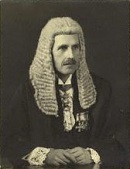
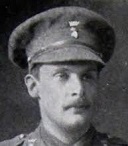
On Jan. 21, 1981 former Protestant Irish Unionist MP (1938-69) (former speaker) Capt. Sir Charles Norman Lockhart Stronge, 8th Baronet (b. 1894) and his ditto son (1969-72) Maj. James Matthew Stronge (b. 1932) are assassinated by the Provisional IRA in their home in Tynan Abbey, which burns down; as the 8+ gunmen flee they get in a fight with British troops before escaping, after which nobody is convicted (until ?).

On Mar. 1, 1981 IRA member Robert Gerard "Bobby" Sands (b. 1954) begins a hunger strike in the H-block section of the Maze Prison in Northern Ireland; after being elected a British MP by Fermanagh and South Tyrone on Apr. 10, he dies 65 days later on May 5, triggering a wave of violence and hunger strikes by 11 other prisoners; meanwhile the Brits change the law to prohibit prisoners from standing in elections.
On July 8, 1981 Provisional IRA member Joe McDonnell (b.1951) dies in Long Kesh Prison after a 61-day hunger strike.
On July 17, 1981 the Glasdrumman Ambush sees the Provisional IRA attack a British Army observation post SW of Crossmaglen, County Armagh, North Ireland, killing one soldier and injuring another.
On Aug. 20, 1981 a 42-day hunger strike is begun by IRA prisoners in an attempt to reachieve political prisoner status, which had been lost on Mar. 1, 1976 with the "criminalization" of IRA soldiers without trial; 10 die by Oct 3.
On Oct. 10, 1981 the Provisional IRA sets off a bomb near Chelsea Barracks in London, killing two and injuring 39.
On Oct. 26, 1981 an IRA bomb explodes in a Wimpy Bar in Oxford St., London, killing bomb disposal expert Kenneth Howorth while attempting to defuse it.

On Feb. 19, 1982 the DeLorean Motor Co. factory in Belfast, Northern Ireland is put into receivership, and the British govt. loses £94M in subsidies of 2K jobs, which they hoped would weaken popular support for the IRA; on Oct. 19 John Zachary DeLorean (1925-2005) is arrested in Los Angeles and accused of putting up $1.8M to bring 100 kilos ($24M) of cocaine into the U.S. to salvage his co.; on Aug. 16, 1984 he is acquitted on the grounds of entrapment by the FBI despite a videotape showing him calling a suitcase full of coke "good as gold", and he retires to his estate in Somerset County, N.J., fighting creditors and declaring bankruptcy in 1999.
On July 20, 1982 the Provisional IRA explodes bombs in Hyde Park and Regent's Park in London during British military ceremonies, killing 11 and injuring 50; in 1987 Gilbert "Danny" McNamee is convicted and sentenced to 25 years, then released under the terms of the Good Friday Agreement after 12 years.
On Dec. 6, 1982 the Droppin Well Bar Bombing in Ballykelly, County Londonderry, North Ireland by the IRA kills 11 British soldiers and six civilians.
On Sept. 25, 1983 38 IRA prisoners escape from Maze Prison in County Antrim, North Ireland using six handguns, becoming the largest prison escape since WWII, and largest in British history (until ?).
On Dec. 17, 1983 (Sat.) (13:21) an IRA bomb outside busy Harrods dept. store in C London kills six, incl. three Christmas shoppers and three police officers as they approach it, and injures 90.
On Jan. 31, 1984 two Protestant Irish solders are killed by a Provisional IRA land mine in their armored car near Forkill in County Armagh.
On Feb. 21, 1984 a shootout in Dunloy, County Antrim, North Ireland kills two IRA members and one British soldier.
On May 18, 1984 an IRA landmine in Enniskillen, County Fermanagh, North Ireland kills three British soldiers; meanwhile two more are killed by a 1K lb. landmine near Camlough in County Armagh.
On July 19, 1984 the IRA announces that it will resume the ceasefire that it broke in Feb. 1996.
On Oct. 12, 1984 the Grand Hotel (Brighton) Bombing in Brighton, Englnd sees British PM Margaret Thatcher and hubby Denis along with most of the cabinet nearly killed by a time bomb set by Provisional IRA member Patrick Joseph Magee (1951-) (AKA the Brighton Bomber) that kills five, incl. Conservative MP (since 1964) Sir Anthony George Berry (b. 1925), and injures 32; Magee is convicted in June 1986.
On Nov. 28, 1984 Ryanair is founded in Swords, Dublin, Ireland as a low-cost airline operating out of Dublin and Lon Stansted airports, growing to 439 Boeing 737-800 aircraft and 225 destinations in 37 countries in Europe, North Africa, and the Middle East incl. Israel and Jordan, becoming Ireland's biggest airline; it commences operations next July 8.
On Feb. 28, 1985 (6:32 p.m.) Provisional IRA terrorists use mortars to kill nine officers and injure 37 at Newry Royal Ulster Constabulary Station in Ulster.
On May 20, 1985 a Provisional IRA bomb near Killean in County Down, North Ireland kills four Royal Ulster Constabulary officers.
On Nov. 15, 1985 PM Margaret Thatcher of Britain and PM Garret FitzGerald of Ireland sign the Anglo-Irish Agreement (Accord), giving Dublin an official consultative role in governing Northern Ireland; the British House of Commons approves it on Nov. 27, followed by the Irish Senate on Nov. 28; too bad, on Dec. all 15 Unionist Protestant MPs resign in protest.
On Dec. 7, 1985 the Provisional IRA attacks the Ballygawley Barracks in County Tyrone, killing two Royal Ulster Constabulary police and destroying the barracks.
On Nov. 2, 1986 the Sinn Fein votes to end its policy of abstentionism (refusal to take seats in the Irish parliament AKA Dail Eireann), causing about 100 to walk out, forming the Repub. Sinn Fein (RSF), claiming to represent true traditional Irish republicanism while failing to reject the use of political violence.

On Nov. 4, 1987 Glengeary, County Dublin-born shaved-head Qabala-loving Irish singer Sinead (Sinéad) Marie Bernadette O'Connor (1966-) releases her debut album The Lion and the Cobra (#36 in the U.S.) (#27 in the U.K.), which sells 2.5M copies, and features the tracks Mandinka, I Want Your (Hands on Me), Jerusalem, and Troy. Album #2 I Do Not Want What I Haven't Got (Mar. 1990) (#1 in the U.K.) (#1 in the U.K.) sell 7M copies, and features the hit track Nothing Compares 2 U (by Prince). Album #3 Am I Not Your Girl? (Sept. 22, 1992) (#27 in the U.S.) (#6 in the U.K.) sells 1.5M copies, dedicated to the homeless of New York City and limited to old songs written in 1936-78, with an intro. blasting sex and emotional abuse and addiction, asking "Ou est le roi perdu?" (Where is the lost king. If you're out there I want to see you); it features Why Don't You Do Right?; she goes on to promote the album on Saturday Night Live (SNL) on Oct. 3, 1992, tearing up a photo of Pope John Paul II, losing much of her audience. In the late 1990s she is ordained as a Roman Catholic priest by renegade Irish Catholic bishop Michael Cox, changing her name to Mother Bernadette Mary and going on to beg Popes John Paul II, Benedict XVI, and Francis to excommunicate her. In 2017 she changes her name to Magda Davitt to be "free of the patriarchal slave names [and] parental curses." In Oct. 2018, no surprise, she converts to Islam, changing her name to Shuhada' Davitt and donning a hijab.
On Nov. 8, 1987 11 are killed when a bomb planted by the IRA explodes in Enniskillen, Northern Ireland at a ceremony honoring Britain's war dead.
On Mar. 16, 1988 pro-British militant Michael Stone attacks an IRA graveside service in Belfast, Northern Ireland with guns and grenades, killing three; in 2000 Stone is released from prison as part of a peace accord.
On Mar. 17, 1988 three people are killed when a man armed with guns and grenades attacks an IRA graveside service in Belfast.
On Mar. 19, 1988 two British soldiers are shot to death after being dragged from a car and beaten by mourners attending an IRA funeral in Belfast, North Ireland.
On Aug. 20, 1988 eight British soldiers are killed by an IRA land mine that destroys a military bus near Omagh, County Tyrone in Northern Ireland.
On Oct. 19, 1988 the British govt. bans the voices of reps from the IRA, Sinn Fein, and nine otehr Irish political-military orgs. from the BBC (until Sept. 16, 1994), causing them to hire actors to dub them.

On Feb. 12, 1989 in Belfast Roman Catholic human rights atty. Patrick "Pat" Finucane (b. 1949), active in the defense of IRA suspects is shot and killed by a lone gunman as he sits down to dinner with his family at home; the Protestant Ulster Defense Assoc. claims responsibility, and in Sept. 2004 member Ken Barrett pleads guilty to murder; in 2011 British PM David Cameron admits British intel collusion.
On July 30, 1990 British Conservative Party lawmaker Dr. Ian Reginald Edward Gow (b. 1937) is killed in an IRA bombing in Hankham, East Sussex.
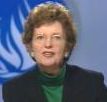
On Dec. 3, 1990 after Brian Lenihan is brought down by a scandal, Mary Therese Winifred Robinson (1944-) becomes pres. #7 (first female) of Ireland (until Sept. 12, 1997), with Charles Haughey continuing as PM (until 1992) - if Britain can do it?
On Mar. 14, 1991 a British court reverses the 1975 convictions of the Birmingham Six for the Nov. 21, 1974 Birmingham Pub Bombings and orders them released.
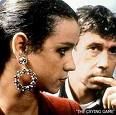
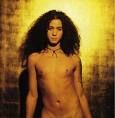
On Sept. 18, 1992 Neil Jordan's The Crying Game (Channel Four Films) debuts, based on the 1931 short story "Guests of the Nation" by Frank O'Connor, and whose title is based on a top-5 British hit of 1964 (played in 3 versions, incl. one by Boy George), starring Stephen Rea as IRA gunman Fergus, who kidnaps black British soldier Jody (Forest Whitaker) and befriends him, then lets him go after being ordered to kill him, only to see him get run over by his own troops, then sets out to find his girlfriend Dil, played by U.S.-born Jaye Davidson (Alfred Amey) (1968-), whom he falls in love with until she wipes off her mouth, takes off her clothes, and shows him her dick, never mind the white-black thang?; one of the seminal movie experiences of the dickade?; does $62.5M box office U.S. and £2M U.K. on a £2.3M budget; watch trailer.

On Jan. 8, 1993 Mark Jones' Leprechaun (Trimark Pictures) debuts, starring 3'6" English "Willow" star Warwick Ashley Davis (1970-) searching for his stolen pot of gold in a little town in S.D. whose luck may have just run out; the film debut of Jennifer Joanna Aniston (1969-); does $8.6M box office on a $1M budget; spawns the Leprechaun series incl. "Leprechaun 2" (1994), "Leprechaun 3" (1995), "Leprechaun 4: In Space" (1997), "Leprechaun in the Hood" (2000), "Leprechaun: Back 2 tha Hood" (2003), "Leprechaun: Origins" (2014), and "Leprechaun Returns" (2019); watch trailer; view clip.
On Jan. 28, 1993 (09:40) a Provisional IRA bomb explodes near the Harrods dept. store in C London, injuring four and causing £1M damage.

On Mar. 1, 1993 the Irish rock band The Cranberries (originally The Cranberry Saw Us), consisting of Delores Riordan (1971-2018) (vocals), Noel Anthony Hogan, Michael Gerard Hogan, and Fergal Patrick Lawler (drums) release their debut album Everybody Else Is Doing It, So Why Can't We?, which sells 5M copies, and features the tracks Linger, and Dreams. Album #2 No Need to Argue (Oct. 3, 1994) sells 16.7M copies, and features the tracks Zombie (about the 1993 IRA bombers that kills two children) ("It's the same only thing since 1916/ In your head, in your head they're still fighting,/ With their tanks and their bombs,/ And their bombs and their guns,/ In your head they are dying.../ Hey hey, what's in your head, Tommy, er Zombie?"), No Need to Argue, Ode to My Family, and Ridiculous Thoughts (video features Elijah Wood). Album #3 To the Faithful Departed (Apr. 30, 1996) sell 6M copies, and features the tracks Salvation, Electric Blue, Free to Decide, and I Just Shot John Lennon. Album #4 Bury the Hatchet (Apr. 19, 1996) features Promises (her misgivings about Irish divorces). Album #5 Wake Up and Smell the Coffee (Oct. 22, 2001) features Analyse.
On Apr. 24, 1993 the Provisional IRA detonates a truck bomb on Wormwood St. in London, England.
On July 5, 1993 the Provisional IRA detonates a 1.5K lb. car bomb in Roma's Bar in Regent St. in Newtownards, Northern Ireland; there are no fatalities.

On Dec. 27, 1993 Jim Sheridan's In the Name of the Father (Hell's Kitchen Films) (Universal Pictures) debuts, based on the Gerry Conlon autobio. "Proved Innocent: The Story of Gerry Conlon of the Guildford Four", starring Daniel Day-Lewis as falsely-imprisoned IRA terrorist Gerry Conlon, whose father Patrick "Giuseppe" Conlon is also framed for the 1974 Guildford Pub Bombings that killed four off-duty British soldiers and one civilian; does $65.8M box office on a $13M budget; watch trailer.
On Aug. 31, 1994 the IRA announces a "complete cessation of military operations", and on Oct. 13 Protestant paramilitary groups announce their own ceasefire, setting the stage for peace negotiations in Northern Ireland.
On Feb. 9, 1995 Riverdance opens at the Point Theatre in Dublin, Ireland, featuring traditional Irish music and dancing, with a score composed by Bill Whelan, featuring Irish dancing champions Jean Butler and Michael Flatley; it goes on to be seen by 25M+ people.
On Feb. 10, 1996 the Docklands Bomb destroys an office complex in London, killing two and injuring 100; the IRA claims responsibility, breaking the ceasefire after deciding that the British govt. is not serious about peace talks.
On Feb. 18, 1996 (22:38) the IRA prematurely explodes a bomb in the double-decker Aldwych bus in C London, killing the bomber Edward O'Brien and injuring eight.
On June 15, 1996 (11:17 a.m.) (Sat.) the 1996 Manchester Bombing in England sees the Provisional IRA detonate a 6K-lb. bomb in a Ford lorry on Corporation St near the city shopping district, becoming the largest IRA bombing in Britain and the largest bomb to explode in Great Britain since the start of WWI; zero are killed, 212 are injured, and £411M is damage is caused; next bombing in Manchester on May 22, 2017.
On July 19, 1997 the IRA announces that it will resume the ceasefire that it broke in Feb. 1996.

On Nov. 11, 1997 Mary Patricia McAleese (nee Leneghan) (1951-) becomes pres. #8 of Eire (until Nov. 10, 2011), becoming the youngest pres. to enter office (46), and 2nd straight pres. named Mary.
Peace at last in Belfast? On Apr. 10, 1998 (Good Fri.) after 22 mo. of peace talks the Good Friday (Belfast) Agreement (effective Dec. 2, 1999) restores a measure of independence to Northern Ireland, incl. their own 108-seat Catholic-Protestant parliament, decommissioning of paramilitary groups, and a Human Rights and Equality Commission; Great Britain and the Irish reps. mutually renounce claims to each other's pot o'gold on the Emerald Isle?; the British army begins dismantling its 16 watchtowers in the "bandit country" of South Armagh, erected in the mid-1980s (finished 2006); in Sept. the Red Hand Defenders are formed by loyalists opposed to the Belfast Agreement.
On Jan. 1, 1999 the Eurodollar (Euro) is launched in 11 EU countries incl. Austria, Belgium, Finland, France, Germany, Ireland, Italy, Luxembourg, Netherlands, Portugal, and Spain.
On Feb. 11, 2000 the IRA misses a disarmament deadline, causing the British on Feb. 15 to suspend the new North Ireland Assembly, created in 1999 as part of the U.K.'s historic devolution program; it is reinstated on June 4 after Sinn Fein agrees to disarm.
On July 20, 2000 the British Terrorism Act of 2000 is passed, superseding the 1989 Prevention of Terrorism and 1996 North Ireland Emergency Provisions Act with more permanent powers, resulting in 750 arrests and 22 convictions by Oct. 2005.
On Sept. 29, 2000 the Long Kesh (Maze) Prison in Northern Ireland is closed.
On Aug. 31-Sept. 8, 2001 the World Conference Against Racism (Durban I) in Durban, South Africa issues a Report on the Slave Trade, calling slavery a "crime against humanity" and demanding apologies and reparations; it recognizes Islamophobia (not Islamophilia?) as a form of prejudice; too bad, under chmn. Mary Robinson of Ireland it goes on to condemn Israel for racism and apartheid, causing the U.S. to walk out, with U.S. state secy. Colin Powell uttering the soundbyte: "I know that you do not combat racism by conferences that produce declarations containing hateful language, some of which is a throwback to the days of Zionism equals racism, or supports the idea that we have made too much of the Holocaust, or suggests that apartheid exists in Israel, or that singles out only one country in the world, Israel, for censure and abuse"; too bad, in Nov. 2010 Pres. Obama awards Robinson the Medal of Freedom.
On Jan. 1, 2002 the eurodollar (euro) replaces nat. currencies in a dozen countries of Europe (Austria, Belgium, Finland, France, Germany, Greece, Ireland, Italy, Luxembourg, Netherlands, Portugal, Spain) as 15B euro banknotes and 50B euro coins (with a value of over 664B euros) are put into circulation, becoming the largest currency introduction in history.

On June 11, 2002 ex-Beatle Paul McCartney (b. 1942) marries Heather Anne Mills (1968-) (an anti-mine vegetarian activist who lost part of her left leg in 1993 after being hit by a police motorbike) at Castle Leslie in Glaslough, Ireland; they separate on May 17, 2006, then divorce on Feb. 18, 2008.
On July 16, 2002 the IRA issues an apology to the families of civilians killed during 30 years of violence in Northern Ireland.
On Oct. 14, 2002 the Northern Ireland govt. is suspended in protest of a suspected IRA spy ring.

In Oct. a 2002 Roman Catholic-Protestant admin. for Northern Ireland falls apart after exposure of longtime Sinn Fein official Denis Martin Donaldson (1950-2006) as a spy on the payroll of the British secret service.
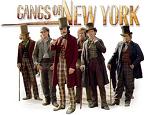

On Dec. 20, 2002 Martin Scorsese's Gangs of New York (Miramax) debuts based on the 1927 book by Herbert Asbury, starring Leonardo DiCaprio as Amsterdam Vallon, son of Priest Vallon (Liam Neeson), Daniel Day-Lewis as William "Bill the Butcher" Cutting, Jim Broadbent as Boss Tweed, John C. Reilly as Happy Jack Mulraney, and Cameron Diaz as pickpocket Jenny Everdeane in an attempted recreation of hellhole Five Points, Manhattan, New York City in 1862-3 incl. the Dead Rabbits and their bitter nativist gang enemies (the Bowery Boys?); does $193.8M box office on a $100M budget; watch trailer.
On Feb. 15, 2003 100K in Dublin, Ireland and 30K in Belfast, Northern Ireland march in protest of the imminent U.S. invasion of Iraq.
On June 25, 2004 U.S. pres. George W. Bush arrives in Ireland for an EU-U.S. summit at Dromoland Castle in County Clare, where anti-war protests are staged against the use of Shannon Airport as a transit stop for U.S. troops en route to Iraq.
On Sept. 30, 2004 Northern Ireland Protestant Dem. Unionist Party leader Ian Paisley makes an historic first visit to Dublin for talks with Taoiseach (PM) Bertie Ahern.

On Oct. 19, 2004 Dalkey, County Dublin, Ireland-born aid worker Margaret Hassan (nee Fitzsimons) (b. 1945) AKA Madam Margaret is kidnapped in Baghdad by ISIS, and killed on Nov. 8 after a video is releaed showing her pleading for help, with the soundbyte: "Tell Mr. Tony Blair to take the troops out of Iraq and not bring them here to Baghdad."
On July 29, 2005 the British army begins dismantling military positions in Northern Ireland one day after the IRA promises full disarmament and renounces all violence; on July 27 the Brits parole an IRA mass murderer as part of the deal; on Sept. 23 the Sinn Fein and Irish govt. meet for the time time in 8 mo., and the IRA agrees to dispose of its stockpiled arms within a week.
I'm too sexy for my Volvo? On Dec. 19, 2005 lezzies Shannon Sickels of Northern Ireland and Grainne Close of New York City become the first gay couple in the U.K. to legally form a civil partnership in Belfast, as North Ireland, the last region of the U.K. to legalize homosexuality (1982) becomes the first to legalize same-sex partnerships; Scotland follows its lead on Dec. 20, and England and Wales on Dec. 21; Denmark was the first country (1989), and by now Belgium, France, Germany, Netherlands, Norway, Portugal, Spain, and Sweden permit them.
Let's hear it for the true-blue Dubs? On Mar. 8, 2006 the Roman Catholic Church in Ireland admits that 102 of its 2.8K Dublin priests past and present (3.6%) are suspected of child abuse; 32 have been sued and eight have been convicted of criminal offenses.
On Apr. 4, 2006 former Sinn Fein official Denis Martin Donaldson (b. 1950), whose spying for Britain for 20 years was revealed in Dec. 2005 is found shot to death after being tortured in his home near Glenties, County Donegal in NW Ireland; the IRA denies responsibility.
On Jan. 28, 2007 Sinn Fein members vote overwhelmingly to recognize the authority of the North Ireland pigs, er, police, paving the way for the return of a Catholic-Protestant admin. there to meet a 1988 Good Friday Peace Pact deadline of Mar. 26.
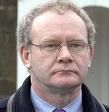
On Mar. 26, 2007 after the IRA drops its goal of ousting Northern Ireland from the U.S. by force, leaders of North Ireland's major Protestant and Roman Catholic parties announce a stunning deal to forge a coalition within 6 weeks, becoming the first time that "Not an inch" "Dr. No" Protestant evangelist Rev. Ian Paisley and his Dem. Unionists and Sinn Fein's Gerry Adams agree to direct negotiations; Britain promises to pass emergency legislation extending its deadline to May 8 for a working power-sharing govt., when the North Ireland Assembly elects a 12-member admin., with Paisley as first minister and former IRA terrorist (high school dropout) Martin McGuinness (1950-) of Sinn Feinn as deputy first minister; the Protestant orange and Catholic green conflict has claimed 3.6K lives since the 1960s.

In June 2007 Nigerian immigrant Rotimi Adebari (1964-) becomes the first black mayor in Ireland, in the town of Portlaoise W of Dublin.
On July 1, 2007 the 100-ft.-long Sea Stallion (Havhingsten) of Glendalough, a Viking replica long ship leaves Roskilde, Denmark on a 1.2K-mi. voyage to Dublin, Ireland, becoming the biggest Viking ship clone, modeled after a real one excavated in 1962 from the Riskilde fjord and dated to 910 C.E.; it arrives on Aug. 15.
At the beginning of 2008 there are 12 women heads of state: Michelle Bachelet (Chile), Helen Clark (New Zealand), Luisa Diogo (Mozambique), Tarja Halonen (Finland), Ellen Johnson-Sirleaf (Liberia), Gloria Macapagal-Arroyo (Philippines), Mary McAleese (Ireland), Angela Merkel (Germany), Yulia Tymoshenko (Ukraine), Emily de Jongh-Elhage (Netherlands Antilles), Pratibha Patil (India), and Cristina Fernandez de Kirchner (Argentina).
On Mar. 4, 2008 Northern Ireland Protestant leader Ian Paisley announces that he's stepping down in May.
On Mar. 13, 2009 thousands of Protestants and Catholics unite at the funeral of constable Stephen Carroll (b. 1960), who was shot on Mar. 7 as he sat in his patrol car, becoming the first policeman shot in Northern Ireland since 1998; on Mar. 5 two unarmed soldiers were gunned down outside their base, becoming the first British troops killed since 1997; on Mar. 14 police arrest three IRA members, incl. Colin Duffy (1967-), "the IRA Godfather of Lurgan", causing more violence.
On June 17, 2009 100 Romanian Romas (Gypsies) are driven from their homes in Northern Ireland by racists after they stage a demonstration against racism; most of them announce they're leaving Northern Ireland, and only 14 decide to remain.
On June 27, 2009 the Ulster Volunteer Force and Ulster Defense Assoc., two major Protestant paramilitary groups in Northern Ireland announce voluntary disarmament after killing 1K in their war with the Catholic IRA, which disarmed in 2001-5 after killing 1.8K over 27 years; the way is paved for the 1998 Good Friday Peace Accord to be implemented.

On Aug. 2, 2009 the White House announces that it will award a Pres. Medal of Freedom to former Irish pres. (1990-7) Mary Robinson (1944-), a longtime opponent of the state of Israel and backer of the 2001 Durban Conference Against Racism that came out against Israel and the U.S. walked out of, creating a firestorm of controversy, incl. the Repub. Jewish Coalition coming out against it.
On Oct. 12, 2009 U.S. state secy. Hillary Clinton urges Northern Ireland to push forward with its peace process begun by her hubby Bill.
On Jan. 1, 2010 a new Irish Anti-Blasphemy Law passed last July comes into effect, causing Atheist Ireland to vow to fight it by publishing anti-religious quotes on its Web site.
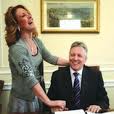
On Jan. 11, 2010 after 60-y.-o. born-again anti-gay-rights grandmother Iris Robinson (1949-) ' is exposed as having a 2008 affair with 19-y.-o. Kirk McCambley and helping him raise $81K to open a cafe, her hubby Peter David Robinson (1948-) temporarily steps down as first minister of the North Ireland assembly (until ?); on Jan. 13 she resigns as MP for Strangford; meanwhile the Simon and Garfunkel song "Mrs. Robinson" gets downloaded heavily in Northern Ireland.
On Apr. 12, 2010 a splinter group of the IRA detonates a car bomb outside British MI5 HQ in Belfast just minutes after the official transfer of police and justice powers from Britain to Northern Ireland.
On May 8, 2010 the secret Trilateral Commission meets in Dublin, Ireland, causing enemies of a 1-world govt. to go nonlinear again.
In May 2010 Ireland establishes the Laureate na nOg (Laureate na nÓg) position for best children's writer or illustrator; the first award goes to Niamh Sharkey.
On Sept. 1, 2010 former British Labour PM (1997-2007) Tony Blair (1953-) releases his new memoir "A Journey"; on Sept. 3 he gives an interview on it, calling radical Islam the greatest threat facing the world, saying that after 9/11 he didn't understand it yet, but that its roots go far deeper than he thought, and "If they could, they would use nuclear, chemical or biological weapons" and kill 300K not just 3K, saying "This is actually more like the phenomenon of revolutionary Communism", and "It's the religious or cultural equivalent of it, and its roots are deep, its tentacles are long, and its narrative about Islam stretches far further than we think into even parts of mainstream opinion who abhor the extremism, but sort of buy some of the rhetoric that goes with it"; on Sept. 4 he holds the first public signing of his memoir in Dublin, Ireland, where protesters hurl shoes and eggs at him; on Sept. 5 he warns that Iran's nuclear program must be stopped by tougher sanctions followed by a military action.
On Sept. 7, 2010 BioMed Central's Genome Biology reports the first sequencing of the entire genome of an Irish person; meanwhile PLoS Biology reports the 90%-sequencing of the genome of the turkey.
On Sept. 17, 2010 David Grennan of Dublin, Ireland becomes the first amateur astronomer to discover a supernova.
On Nov. 21, 2010 Ireland becomes the 2nd EU country after Greece to ask for a multibillion-euro emergency loan; in Nov. 28 the EU agrees to give $89.4B in bailout loans to struggling Ireland.
On Jan. 18, 2011 the Central Bank of Ireland prints its own notes, dumping the Euro.
On Jan. 22, 2011 Irish PM Brian Cowen resigns as leader of the Fianna Fail Party, but vows to stay PM until the Mar. 11 election.
On Feb. 26, 2011 elections in Ireland become the worst D since 1932 for the ruling Fianna Fail party, and a V for Fine Gael.
On May 17-20, 2011 British Queen Elizabeth II visits Ireland.
On May 23, 2011 Pres. Obama begins a week-long European tour, starting with his mother's ancestral homeland in Ireland,. where he utters the soundbytes: "There's always been a little green behind the red, white, and blue", "My name is Barack Obama, of the Moneygall Obamas"; "I've come home to find the apostrophe that we lost somewhere along the way"; on May 24 he after leaving Ireland early to avoid the volcanic ash from Grimsvotn Volcano in Iceland, Obama visits Buckingham Palace, receiving a royal welcome from the queen and royal family along with a 62-gun salute; too bad, he signs the guestbook at Westminster Abbey with the date "24 May 2008".
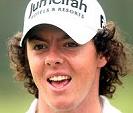
On June 19, 2011 Rory McIlroy (1989-) of Northern Ireland wins the U.S. Open of golf in Bethesda, Md. with a record 16 under par; too bad, NBC-TV omits the words "under God" and "indivisible" from the Pledge of Allegiance, causing an outcry.
On July 20, 2011 Irish PM Enda Kenny attacks the Roman Catholic Church in parliament, praising the Cloyne Report for showing how allegations of sexual abuse by priests in Cork has been covered up by the Church, and saying that the historic relationship between church and state in Ireland cannot be the same again.
On Nov. 3, 2011 after their fight over the Church's handling of sex abuse cases earlier in the year, Ireland closes its embassy to the Vatican, claiming it "yields no economic return", becoming the first major Roman Catholic country to do so.

On Nov. 11, 2011 Labour Party pres. (since 2003) Michael Daniel Higgins (1941-) becomes pres. #9 of Eire (until ?), going on to make the first state visit by an Irish pres. to the U.K. in Apr. 2014 and win election to a 2nd term in 2018 by a landslide, with the largest personal mandate in the history of Eire (822,556 first preference votes).
On Feb. 18-20, 2012 Chinese vice-pres. Xi Jinping visits Ireland, signing trade pacts.
On Mar. 6, 2012 authorities in the U.S., U.K., and Ireland arrest six senior members of the Lulz Sec hacking group, incl. FBI member Sabu (Hector Xavier Monsegur).
On Apr. 19, 2012 Dylan Moran (1971-) of Ireland becomes the first prof. English-speaking comedian to perform in Russia, dissing laws banning gay propaganda et al.
On Apr. 4, 2013 the Teachers' Union of Ireland (TUI) becomes the first academic union in Europe to academically boycott Israel to please the Palestinians, calling it an "apartheid state".
On June 17, 2013 the G8 Summit in Belfast, Northern Ireland focuses on Syria, with Pres. Obama and Russian PM Vladimir Putin backing opposite sides, and Putin getting in a soundbyte about how Western govts. can back cannibals.
On July 12, 2013 by a 127-31 vote, formerly Roman Catholic Ireland legalizes abortion when physicians deem the woman's life at risk.
On Jan. 1, 2014 the controversial Protection of Life During Pregnancy Act comes into effect in formerly Roman Catholic Ireland, allowing abortions where doctors believe there is a threat to the life of the mother.
On Dec. 10, 2014 Ireland announces that it's considering parliamentary recognition of a Palestinian state, pissing-off Israel, which gets even more pissed-off at news that all mention of it is being banned from the Jan. 27 Holocaust Memorial Day.
On May 23, 2015 Ireland votes to legalize same-sex marriage, becoming the first to do it with an amendment to the nat. constitution.
On Jan. 6, 2016 Christian preacher James McConnell of County Antrim, Ireland is acquitted of "grossly offensive speech" for preaching that Islam is Satanic and a doctrine spawned in Hell, which doesn't stop Irish Muslims for lobbying for Islamic blasphemy laws like in the Muslim World.
On Aug. 30, 2016 the European Commission announces that Apple cheated Ireland out of taxes, paying 50 euros for every 1M euros in profit in 2014, and orders it to pay it $14.5B in back taxes.
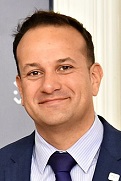
On June 14, 2017 Leo Eric Varadkar of Fine Gael becomes PM (Taoiseach) #14 of Eire (until ?), becoming the first openly gay, first of Indian heritage, and youngest (until ?).
On Feb. 24, 2018 the Great Britain and Ireland Cold Wave (Beast from the East) begins (ends Mar. 19), caused by a large Arctic air mass with anticyclonic structure stretching from E Russia to the British Isles and centered on Scandinavia.
On Mar. 15, 2018 a group of Irish MEPs pub. a report warning that Ireland is a "soft target" for terror and cyber attacks.
On May 25, 2018 a referendum in the Repub. of Ireland overturns its longtime ban on abortion by 66.4%-33.6%, approving the 36th Amendment to the Constitution, which repeals the 8th Amendment; the Health (Regulation of Termination of Pregnancy) Act of 2018 is signed into law on Dec. 20, coming into force on Jan. 1.
On Oct. 10, 2018 the U.K.'s supreme court rules that a bakery in Belfast, Northern Ireland run by evangelical Christians can't be forced to make a cake with slogans supporting gay marriage, pissing-off gay activists - it's really about kowtowing to Muslim bakers?
On Mar. 26, 2019 former Eire pres. Mary Robinson utters the soundbyte that climate change denial is "malign and evil" because it denies the human rights of the most vulnerable people on Earth.

On Apr. 18, 2019 Northern Ireland journalist Lyra Catherine McKee (b. 1990) is shot and killed during a riot in Creggan, Derry by a masked Republican gunman, causing the Sinn Fein, UUP et al. to condemn it as "an attack on all the people of this community, an attack on the peace and democratic processes", calling it a "pointless and futile act to destroy the progress made over the last 20 years, which has the overwhelming support of people everywhere."